
arts culture food health history libations music outdoors people shops Spring 2024 | Volume 7: Issue 27 Premier Edition

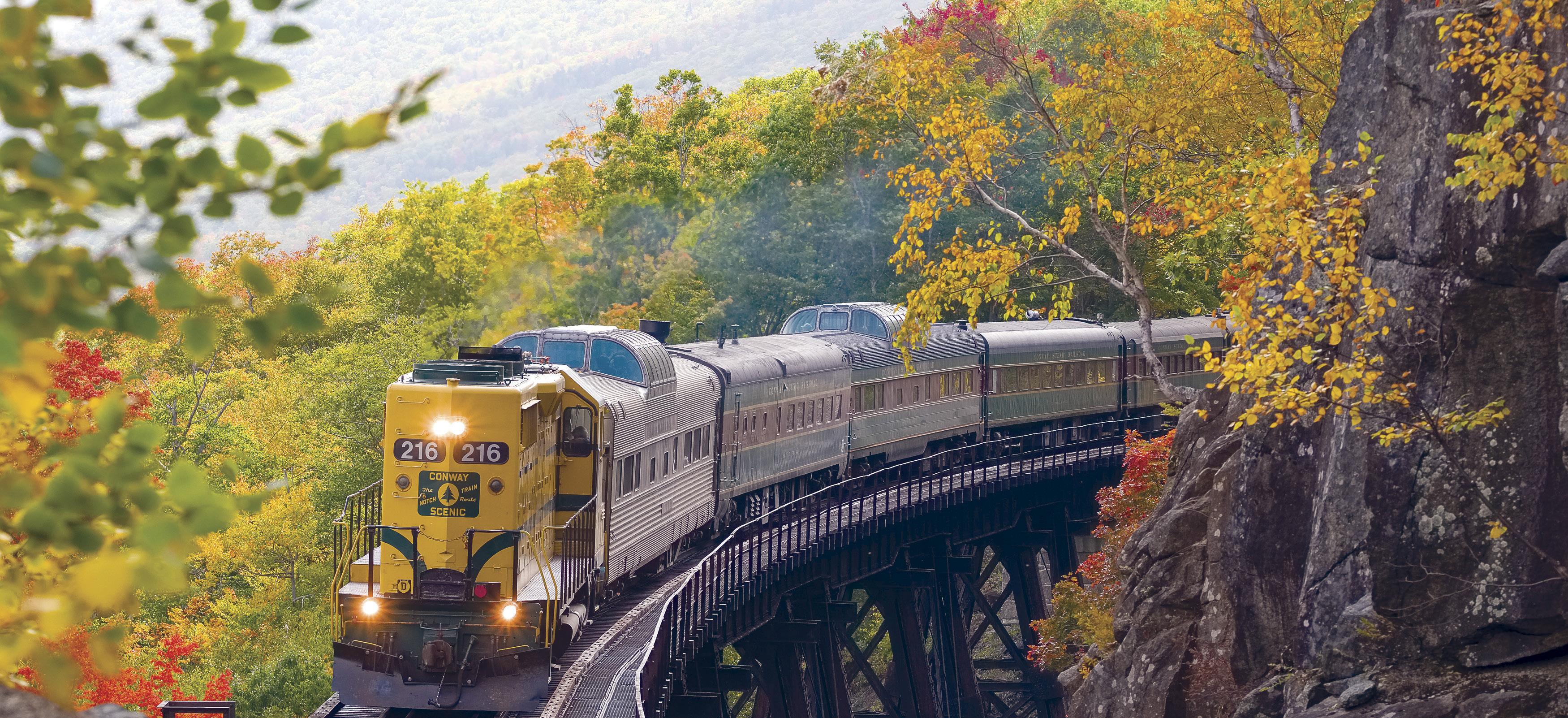
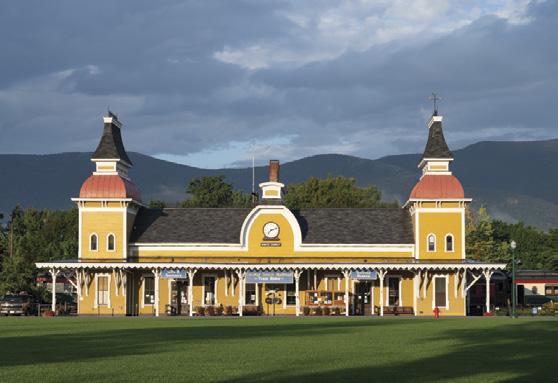


All Aboard! Call or Book online - ConwayScenic.com • (603) 356-5251 38 Norcross Circle | North Conway, NH 50 ANNIVERSARY th 1974 - 2024 Celebrating 50 years of railroad excursions THREE GREAT TRAIN RIDES! • Experience classic train travel on the Valley and Sawyer River Trains or take a scenic journey over Crawford Notch aboard the Mountaineer. • Seasonal excursions begin in April and run through November. • 50th Anniversary celebrations planned for August 3rd & 4th! The Mountaineer offers a supremely scenic journey over Crawford Notch.


PUBLISHER/CREATIVE
Dan Houde dan@wiseguycreative.com
MANAGING EDITOR
Cam Mirisola-Bynum
SALES MANAGER
Chris Pacheco ads@mwvvibe.com
DISTRIBUTION / CIRCULATION
Mt Washington Valley Vibe is published four times annually and is available for pick-up, free of charge, in over 300 locations throughout the White Mountain Region of New Hampshire and into the communities of Western Maine.
MWV Vibe is also available at many New Hampshire Welcome Centers throughout the state.
MWV Vibe can also be found in select retail shops, dining establishments, lodging properties, and grocery stores throughout the same area. If your business, or one you know, would like to make MWV Vibe available to its customers, please contact us.
©2024 Wiseguy Creative Media. All rights reserved. Content may not be reproduced or copied in any form, in part or in whole, without explicit permission. The views and opinions presented here are those of their respective authors and may not reflect the views of the MWV Vibe or its staff.
ADVERTISING
For advertising, feedback, and subscriptions, call (603) 986-5761 or email info@mwvvibe.com.
SUBSCRIPTIONS
Four editions annually - $40 www.mwvvibe.com/subscribe
Well, that was an odd winter. Early snow, flooding, lots of snow, no snow, then our biggest storm of the year in late March. Maybe that isn’t odd at all … and just the new normal? We shall see.
But I’m not here to complain about the weather. I’m here to talk about learning. Personally, we’re learning that trends tend to dictate what we cover with Vibe. It would be easy to tell you how much effort we put into planning each edition carefully and discussing how to come up with themes and follow through with collecting specific content—but that’s just not at all how it happens.
Our themes tend to happen naturally. In most winter editions, we seem to cover all the ways locals and visitors to the area can enjoy the outdoors and stay healthy doing so. Writers pitch story ideas to us, and we simply follow the trends of the incoming season. We live in an outdoor recreation area, so naturally, we go with the flow. Our spring editions have typically been more focused on locals and what our community has to offer residents of the Valley.
Over the past few years, it has become more evident that this community is heavily focused on youth programs that offer authentic outdoor-related experiences capable of translating into personal growth opportunities—ones that provide variable perspectives that foster critical thinking skills. From toddlers to teenagers, our educational programs provide activities that naturally communicate the many ways to learn from exploring. Academics are being combined with real-world scenarios, indoors and outdoors, to create a broader, more holistic educational opportunity for our youth.
For example, MESA—the Maine Environmental Science Academy—is offered at the Molly Ockett School in Fryeburg. The program encourages kids to grow as pupils and as individuals. MESA brings collaboration, creativity, exploration, a sense of community, and deep connections in a more natural setting. Hear from some of the students on page 62.
Speaking of a natural setting, Waukeela, a girls’ summer camp in Eaton, has a similar philosophy: kids are allowed to be kids. They are guided to take a break from the pressures of the modern world. They are encouraged to follow and explore their own intuition and decide what they want to do in a judgment-free environment. Page 74 immerses you into the experience.
The 2024 MWV Youth STEM Expo (science, technology, engineering, and math), saw a major increase in participation this year (from both public and private local schools), from 22 students presenting 16 projects in 2023 to 103 presenting 77 projects this year. The program is aimed to keep STEM relevant and exciting for students by allowing them to explore their own ideas and present alongside their peers. Many of the projects presented had an outdoor focus, with topics involving water, erosion, and environmental concerns. We write about this year’s event on page 10.
The Lilliputian School—a Montessori-based early childhood education center in North Conway, has become the area’s first TimberNook-certified school. The TimberNook curriculum philosophy is that children flourish when given the time and space to play in sensory-rich, experiential learning environments. See page 58 to learn more about their programming and offerings.
The change of season signals a change of mind—here’s hoping yours is one of curiosity and exploration. And let us know what you find out there that you might want others to know about here.
Happy spring!
Dan Houde, dan@wiseguycreative.com

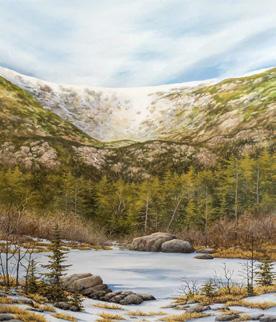

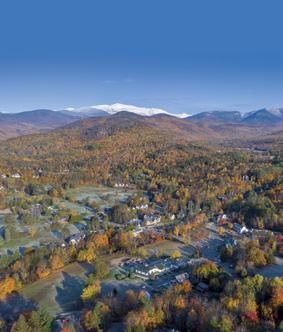


4 MWVvibe.com THOUGHTS FROM THE PUBLISHER Looking for back editions or to subscribe to stay current? Visit www.mwvvibe.com/subscribe! arts culture food libations music outdoors people shops Winter 2020/21 Volume Issue arts culture food health libations music outdoors people shops Spring 2021 Volume 4: Issue 15
food health history libations people shops Issue
WRITERS & PHOTOGRAPHERS
Lily Hartman, Seabrook, NH

Lily loves to write about health and outdoor recreation. Before making her way back to New Hampshire, she studied publishing and journalism at Emerson College. She often thinks of story ideas while exploring trails in the White Mountains. In 2021, she discovered Hiking Buddies NH 48, a 501(c)(3) organization, where she met lifelong friends who helped her finish the NH 48.
Bernadette Donohue, Fryeburg, ME

Known as the Dream Home Matchmaker, Bernie’s love of adventure, nature, and people started her real estate career 37 years ago. Bernie’s passion is also to facilitate caring connections and community. She is co-chair of local REALTORS® Community Service Committee, Creator of MWV Photo Contest, Calendars for Charities and Hands of Hope, cancer survivor banner.
Dr. Trish Murray, Albany, NH

Dr. Trish has run an osteopathic medicine office in Conway for 18 years. She moved to the Valley because she loves everything outdoors: hiking, canoeing, skiing, etc. In her 30s, she ran an outdoor adventure business and now returns to guiding hiking trips with Holidays Afoot in U.S. and UK.
Clem McAuliffe, Bartlett, NH

Throughout his 13 years as the prior owner of Vista Bev Beer & Wine shop, he was his own best customer. Clem has a love for beer and all the people dedicated to getting it to him. A self-defacing beer dork who will happily always answer the question, “Clem, what am I drinking today?”
Emily Calderwood, Bartlett, NH

Emily is a UK native and retired pharmaceutical research chemist. She swapped her lab coat for mountain gear and moved with her family to Bartlett in 2018. Emily is passionate about causes helping children; she serves as a Bartlett School Board Member, CASA volunteer, and leads the MWV Youth STEM Expo Committee.
If you reside locally or have ties to the Valley and would like to offer your creative talents, please contact us at info@mwvvibe.com.
Barbara Murphy, West Paris, ME
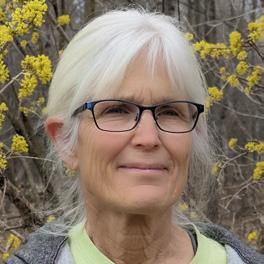
Barbara Murphy is the director of the Habitat for All Garden in Bethel, Maine. She is a former organic farm manager, university faculty member, and founder of Maine Harvest for Hunger. Barbara is passionate about teaching people about the wonders and opportunities that backyard gardens have to offer.
Lea Camille Smith, Intervale, NH

Lea is a writer, gardener, and student at The University of Southern Maine’s Stonecoast MFA program in creative writing. She is the fiction editor for the Stonecoast Review. When she’s not writing or playing in the dirt, she can be found on skis, rollerblades, or a mountain bike somewhere in the Valley.
Sam Norton, Tamworth, NH

Sam Norton is a trail builder and writer who lives between Tamworth, New Hampshire and the Berkshires of Massachusetts. A life-long creature of New England, he was born in Northampton, MA and went to college in Connecticut. He balances his outdoor work with media-related work.

Ryan St.Onge, North Conway
Born in rural Gorham, NH, Ryan has formed a fulfilling music and writing career in the bustling ski town of North Conway, NH. He loves to explore, cook, and experience. When he’s not performing live, writing new songs, or contributing material, he enjoys time with his family and friends playing sports, cards, and all that the MWV has to offer.
Emma Carlson Risch, Madison, NH

Emma is a career outdoor educator with a degree in environmental education from Colby College. She was the director of wilderness trips at Chewonki, led St. Lawrence University’s Adirondack Semester, and trained with the National Outdoor Leadership School. Most recently, she launched a family business, White Mountain Playscapes. Emma is a TimberNook-certified teacher.
Dr. Joshua Knowles, North Conway, NH

Joshua Knowles is a retired Air Force orthopedic surgeon who served in eight military hospitals throughout his career. He and his wife and three kids have lived all over the world, experiencing different cultures and landscapes. They share a passion for outdoor activities including hiking, biking, skiing, and snowboarding. Eager to immerse themselves in the vibrant community at Memorial Hospital, they anticipate a future filled with meaningful connections and exciting experiences.
Heather Corrigan, North Conway, NH

Originally from Connecticut, Heather has called the White Mountains home for over a decade. Her passion for preservation and local history have put her in the middle of the rich history of the Valley and a member of the Conway Historic District Commission. When she’s not rooting for the “wrong” baseball team, she’s preserving local history as the executive director of the Conway Historical Society.
Josette Deschambeault, Fryeburg, ME

Josette is a former hiking, climbing, and rafting guide who now calls Fryeburg, Maine home. In her spare time, she serves as a firefighter/EMT with Fryeburg Fire Department, and tests/reviews outdoor gear for publications such as REI Co-op’s Uncommon Path and Backpacker Magazine
Majo Orozco, Mexico City, Mexico

Majo is a Mexico City native who first came to New Hampshire at 11 years old as a camper at Camp Waukeela. She has since been a part of this institution, as a counselor, head counselor, and now assistant director. Majo loves to spend her summers in the Mt. Washington Valley connecting with nature and the wonderful people.
Additional contributers
Wendy Scribner, Sarah Frankel , Jotham Oliver, Julie Schoenfeld, Deidre Blair, William Gilson
Spring 2024 5
10 - STEM SCIENCE FAIR

FEATURES
10 FOSTERING FUTURE
By Emily Calderwood
12 HIKING FOR A LIFETIME
By Dr. Trish Murray
14 FROM SURGERY TO SUMMIT
By Dr. Joshua Knowles
16
By Lily Hartman
22
40 - TUCKERMAN RAVINE FACTS
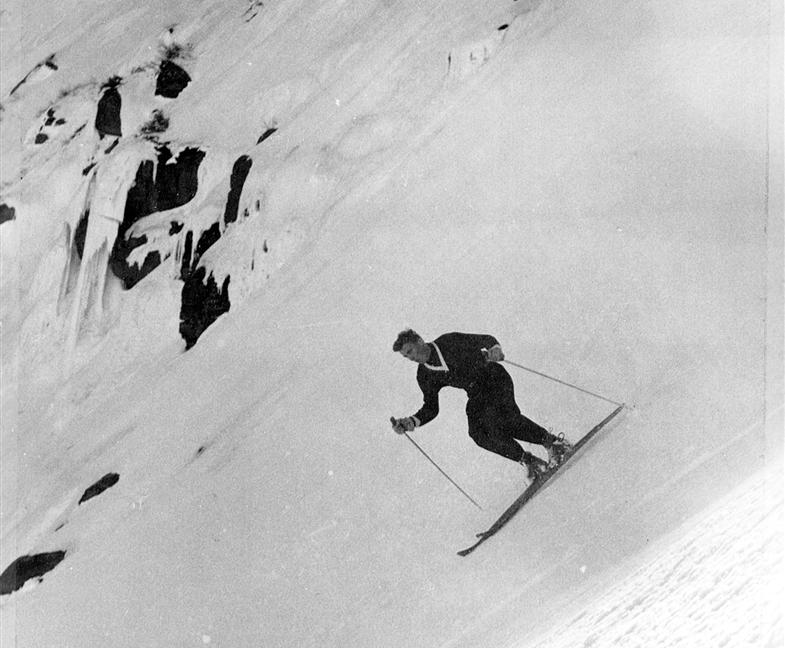
26 WEATHER IN THE EXTREME
By Wendy Scribner
28 POLLINATORS OF THE WHITES
By Barbara Murphy
34 AN ODE TO MWV FARMERS’ MARKET
By Lea Camille Smith
38 TUCKERMAN-READY LAYERING
By Josette Deschambeault
40 28 TUCKERMAN RAVINE FACTS MWV Vibe Desk
REGULARS
5
16
70 - EATON’S CAMP WAUKEELA

44 RIDING THE WHITES IN 2024 MWV Vibe Desk
46 OSSIPEE VALLEY MUSIC FESTIVAL
By Ryan St.Onge
50 THE TRAIL FIXING COLLECTIVE
By Sam Norton
58 CHILD-LED, OUTDOOR LEARNING
By Emma Carlson Risch
64 THE MESA CLASSROOM
By Sarah Frankel
70 CAMP WAUKEELA FOR GIRLS
By Majo Orozco
78 THE HOUSE IN THE CLOUDS
By Heather L Corrigan
ON THE COVER
Springtime in the Ravine is an oil color painting provided by artist and gallery owner Deidre Noreen Blair, of The Three Sisters Gallery in Gorham, NH
The gallery has a current “Call for Art,” for the 2nd Annual Tuckerman Ravine Group show in August. See page 21.

6 MWVvibe.com
SPRING 2024 • CONTENTS
VIBE CONTRIBUTORS
SMALL BUSINESS SPOTLIGHTS
HEALTH/FITNESS
LOCAL FOOD & FARMING
8
12
14
ART IN THE VALLEY 20 REAL ESTATE CORNER 78 LOCAL HISTORY
INNOVATORS
PLEIN AIR PAINTING IN THE WHITES
& NEWS
WHITE MOUNTAIN BREWS
By Clem McAuliffe


WHERE OLD FRIENDSHIPS BEGIN

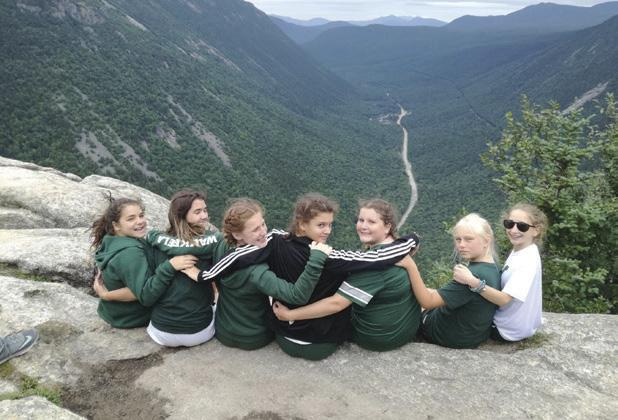



Camp Waukeela is located in an area of outstanding natural beauty where girls come to disconnect from electronics and discover their true selves. We offer a wide range of activities from arts and crafts, lake swimming, boating, tennis, horse-back riding, ropes, drama, and so much more!
2024 DATES & SESSIONS
For girls completing 1st – 10th grade (ages 7-15)
3 ½ WEEK SESSIONS
Session 1: 6/22 – 7/16
Session 2: 7/19 – 8/11
2-WEEK SESSIONS
(first-time campers only)
Session A: 6/22 – 7/6
Session B: 7/19 – 8/2
FULL SUMMER – 7 WEEKS 6/22 – 8/11
For rates and dates plus camp information videos, scan with your phone’s camera

Spring 2024 7
1922!
NH!
Since
Located on beautiful Crystal Lake on Route 153 in Eaton,
> (603) 447-2260 • Route 153, Eaton, NH • www.waukeela.com
RESIDENTS
NEW HAMPSHIRE
GET 10% OFF!
SMALL BUSINESS SPOTLIGHT
The businesses below are members of White Mountain Independents! Learn more at www.whitemountainindependents.com.
THE ROOT CELLAR

Located in an historic building in North Conway Village, the Root Cellar is a high-quality hair salon, day spa, and barber shop. Owned and operated by Andrea LaRusso for almost 16 years, the salon also offers a boutique of quality bags, scarves, and jewelry. Seven talented stylists specializing in precision haircuts, plus creative color and texture services, are joined by a barber who offers the latest trends in men’s and youths’ cutting, along with hot-lather, straight-razor shaves.
All invest time and care into listening to what you want to achieve, offering proven professional advice, and tailoring their services accordingly. Education is critical to their success, so they engage in ongoing professional development and training to keep pace with the latest trends and hair fashions. Their upstairs spa offers massage, nail, and skin treatments. Inhale peace, exhale stress and tension when you enter their space. The entire salon and spa prioritize exceptional sanitation and the optimization of your overall wellness. Whether you are new to the Valley or a local resident, you will be welcomed with open arms. This is a destination you want to create time for.
For more information, call (603) 356-6995 or visit www.therootcellarnh.com.
LEAGUE OF NH CRAFTSMEN – FINE CRAFT GALLERY

If you’re looking for someplace to buy local artisan-made works, this historical fine craft gallery will have you swooning in delight. The League of NH Craftsmen features stunning displays of juried NH fine craft in a beautifully lit, post-andbeam gallery with cathedral ceilings and granite floors. The two major showrooms are elegantly curated with colorful pottery, handblown glass, framed artworks, sculptures, and fine furniture. Browse handmade jewelry, sumptuous fiber arts, turned wood bowls, stained glass, home decor, and handmade gifts of all shapes and sizes.
In addition to locally crafted works by over 250 craftsmen, the gallery also hosts regular classes in the pottery studio onsite. Learn to throw pottery on a pottery wheel or take a hand-building class and let your creativity flow!
The League of NH Craftsmen is a nonprofit organization that began during the great depression in 1932, and is now one of the oldest craftsmen organizations in the country. There are currently seven League galleries statewide, but this particular gallery has operated in North Conway since the beginning. Now in its 92nd year, the North Conway League Gallery continues to fulfill its mission to nurture and promote fine craft, encouraging an appreciation for authentic New Hampshire culture, and celebrating the talents of its local artists and craftsmen.



HIGHLIGHTS:
• An Aveda salon and boutique
• Full-service nail salon
• On-site esthetician
• On-site spa with restorative skin treatments





HIGHLIGHTS:
• Historical gallery
• Locally made artworks
• Authentic NH fine craft
• Pottery classes onsite
For more info, call (603) 356-2441, or visit www.nhcraftsmen.com.
8 MWVvibe.com
therootcellarnh therootcellarsalon nhcraftsmengallery leagueofnhcraftsmen_n.conway
SPRING INTO SUMMER
a comprehensive Medical Spa with two locations; North Conway & Gorham, NH.
Dr. Edwin Giron and Caitlin Behr, RN offer stateof-the-art therapeutic and esthetic treatments using a broad range of products, procedures, and technologies including injectables, energy based cleansing and resurfacing treatments, medical-grade skin care products.
 Edwin Giron, DDS, DAAFE and Caitlin Behr, RN, BSN
Edwin Giron, DDS, DAAFE and Caitlin Behr, RN, BSN
All of our clients start with a comprehensive evaluation in which we will listen to your concerns and work with you to achieve an authentic, fresh, and rejuvenated look. Visit our website or call to schedule a consultation ... you’ll see why so many people have chosen us as their provider for their skin care needs!



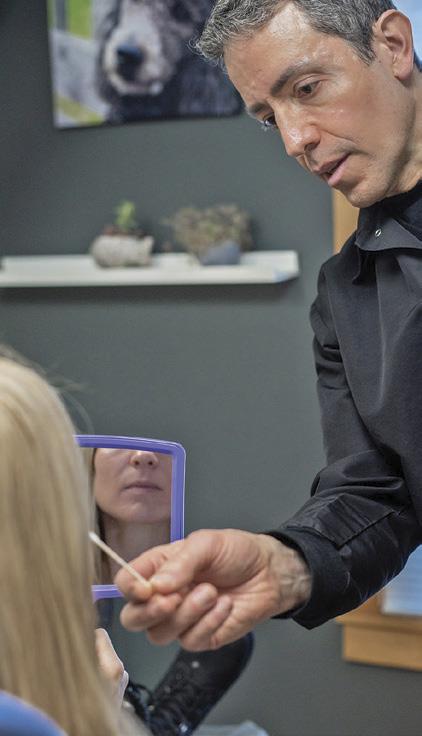

Spring 2024 9
WITH FRESH FACE STUDIO
MEMBERSHIP PACKAGES Platinum/$1,100 4 Ultimate Preime Derma Facials per year Gold/$600 2 Ultimate Preime DermaFacials per year Plus MEMBERS SAVE 10% off all products & services for the year. 603-466-2323 www.freshfacestudio.com 2506 White Mt Hwy, No Conway 18 Park Street, Gorham
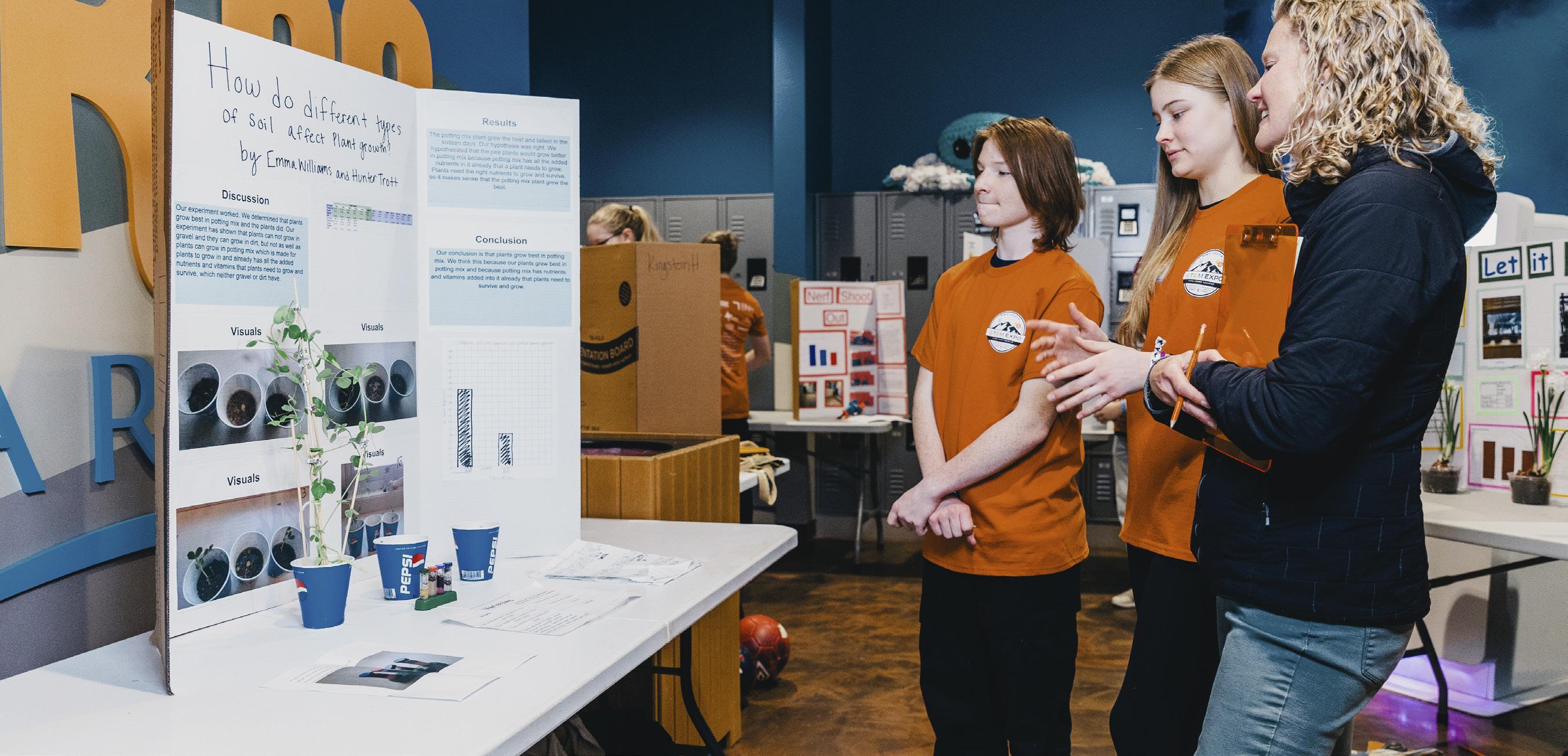
Fostering Future Innovators
By Emily Calderwood
Inspiring Student Excellence in STEM
Local students excitedly gathered at the Living Shores Aquarium in Bartlett on March 20, 2024, to participate in the second annual MWV Youth STEM Expo. STEM stands for science, technology, engineering, and math. This year 103 students climbed off buses and out of cars carrying poster boards, models, and equipment. They had been tasked with designing and executing a basic research project, or a design and engineering project, which they were to present to judges on the day of the expo. Students had dedicated the past two to three months to their work and were eagerly looking forward to showcasing their projects.
The MWV Youth STEM Expo began in 2023 as a small event, with just 22 students presenting 16 projects. The event aimed to bring back a science fair to the Valley after several years’ absence, largely caused by the COVID-19 pandemic. The
Jackson, and two students traveled from Molly Ockett School in Fryeburg, ME. Many students had worked with volunteer mentors after school, or on their own at home. Others worked on projects at school, as their teachers skillfully integrated their project work into classroom time.
Before any visitors or public arrived at Living Shores Aquarium, 37 volunteer judges carrying clipboards and pens spread out through the exhibits to talk to the students and learn about their work. The judges saw a wide range of projects covering diverse areas such as water filtration, sports science, crystal growth, and bioluminescence. Students had prepared poster boards, and many brought small demonstrations to exemplify their work.
As judges tallied their scores, 4th- and 5th-grade students from Conway, Jackson, and Bartlett arrived. The student
The expo presented the opportunity for students to learn about the scientific research process while enhancing their communication and presentation skills through research and inquiry-based learning.
expo presented the opportunity for students to learn about the scientific research process while enhancing their communication and presentation skills through research and inquiry-based learning. The expo aimed to keep STEM relevant and exciting for students by allowing them to explore their own ideas, and present alongside their peers.
The organizers were delighted that the 2024 MWV Youth STEM Expo showed such growth in participation from the previous year. This year’s expo showcased 77 projects in three age categories: elementary school (4th and 5th grade), middle school (6th to 8th grade), and high school (9th to 12th grade). Students came from schools in Conway, Bartlett, and
presenters were able to switch from talking to judges to engaging the younger visitors. Visitors enjoyed the Living Shores Aquarium exhibits and also experienced demonstrations from the Kennett High School Robotic Club. Additionally, Kennett High School aviation students assisted the visitors in trying out a flight simulator. To add to the excitement, White Mountain Science Inc. (WMSI) and 4-H organized fun and interactive sessions for the visitors to participate in hands-on investigations.
After the competition, participants, judges, and parents gathered in the aquarium cafeteria where they were treated to a keynote presentation by the Mount Washington Observatory weather observers Alex Branton and Francis Tarasiewicz, who
10 MWVvibe.com
Photos by DivisionMedia (Abbey Donolson)
2024 Elementary School Winners
1st Place: Jeremy LeFebvre (4th grade, Jackson Grammar School)
“How Does the Temperature of a Magnet Affect its Strength?”
2nd Place: Nora Darak and Lily Waterhouse (5th grade at Josiah Bartlett Elementary)
“How Do Different Liquids Affect Basil Growth?”
3rd Place: Vivian Klein (4th grade, Jackson Grammar School)
“How Different Types of Music Affect the Growth of Plants”
2024 Middle School Winners
1st Place: Addy Jaus (6th grade, Josiah Bartlett Elementary School)
“Does Sand and Salt from Roads Affect the Water Quality of the Saco?”
2nd Place: Kaelan Leathem and Emmett O’Brian (6th grade, John H. Fuller Elementary School and Josiah Bartlett Elementary School)
“Do Different Balls Bounce Higher Off Different Bats?”
3rd Place: Emily Fields (8th grade, Josiah Bartlett Elementary School)
“Aspect Vs. Snow Stability”
2024 High School Winners
1st Place: Zoe Groves (11th grade, Kennett High School)
“Color Vision Under Different Light.”
2nd Place: Tucker Laughland (9th grade at Kennett High School)
“Mind Altering Herbs and their Effect on Ants,”
3rd Place: Nia Lajoie and Adelyn McAllister
“How Erosion and Drought Make Your Crops Pout.”
2024 Mt. Washington Observatory Emerging Scientist Awards
Award 1: Katie Laracy (8th grade, A. Crosby Kennett Middle School)
“Decomposing Plastic”
Award 2: Camilla Leiser (5th grade, John H. Fuller Elementary School)
“What Type of Water is Best for Plants?”
were broadcasting live from the summit of Mount Washington. The two weather observers emphasized the importance of STEM education in their careers and talked about the extreme weather conditions found at the summit of New England’s highest mountain.
As the awards presentation began, the room fell silent in anticipation. Kevin Richard, superintendent of SAU #9 schools, announced the judges’ decisions. The winners would receive cash prizes: $300 for first place, $200 for second place, and $100 for third place.
Each winner also went home with a backpack from the Mount Washington Observatory, which was crammed with Observatory gifts, and gift cards from local businesses. Emily Fields, third place Middle School winner was excited at the honor of winning, “I’m so proud of what I’ve done,” she enthused, “I had such a great day talking with judges and presenting my project.”
The MWV Youth STEM Expo is a collaboration between the SAU#9 school district and dedicated local volunteers. Volunteers play pivotal roles, from guiding and mentoring students in
schools to diligently overseeing judging, student check-ins, and the meticulous setup and teardown of the event venue.
Funding for the expo hinges on grants and sponsorship. The MWV Youth STEM Expo uses grant funding from the New Hampshire Out-ofSchool-Time Career Pathways Initiative. The organizers also express deep appreciation to their major sponsors in 2024: Foxfire Property Management of Concord, NH, and the Bank of New Hampshire. Furthermore, the generous support of key sponsors such as Ambix Manufacturing, The New Hampshire Charitable Foundation, and Northeast Delta Dental significantly bolstered the event’s success.
As chattering students and parents happily collected poster boards, jackets, and bags and filtered away, numerous students were already buzzing with ideas for next year’s projects. The organizers are looking forward to an even larger and more successful event in 2025, allowing more students to imagine themselves as future innovators and scientists.

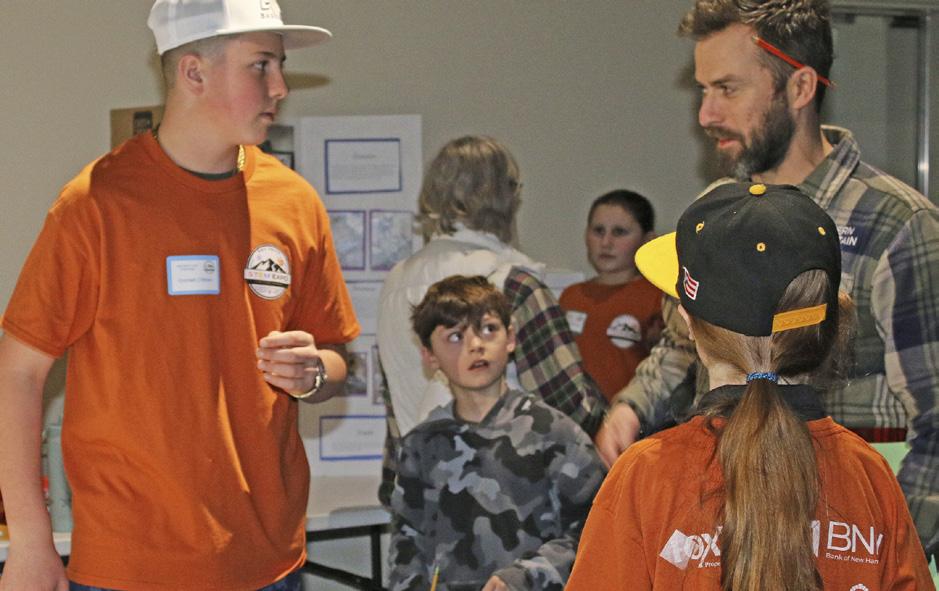

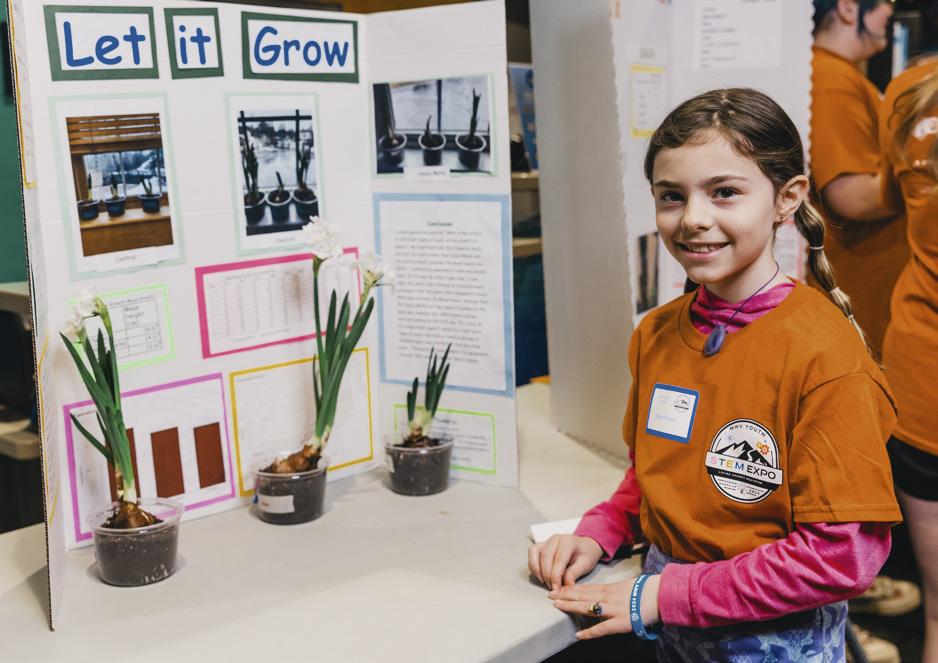

Spring 2024
Lisa DuFault photo
HIKING FOR A LIFETIME Staying Fit after 40
By Dr. Trish Murray

Are you over 40 with children that are grown and have moved out … and you are starting to dream about travelling? Or you may be even closer to retirement age and longing to explore new things and exciting places. So many of us get caught up in our daily routines and just dream about all the things we want to do when we retire. Have you done enough to keep your body in step—literally—with your dreams? Now is always a good time to get moving—and keep moving.
In most cases, if we start to plan and work toward our goals early and focus on some basic concepts of physical health, we can reach our retirement dreams. And one way to help stay consistent is to go on some exciting trips now, and along the way, so that you learn how amazing life can be. For example, in my 20s and early 30s, I ran an outdoor adventure business that led canoeing and hiking trips in the U.S. and Canada; now that I am older, I long to be out on the land travelling even more so.
So, connecting with my friend, Brenda Donnelly, who is a local massage therapist that also has guided hiking trips for 30 years, we decided not to put off our adventures any longer.
In September 2023, we led our first group to the Pembrokeshire Coastal Path in Wales, UK, had nine participants that ranged in age from 60 to 86 years old, and everyone enjoyed a hiking experience of a lifetime.
We combined efforts and talents and started running guided hiking trips to the UK and parts of the U.S. In September 2023, we led our first group to the Pembrokeshire Coastal Path in Wales, UK, had nine participants that ranged in age from 60 to 86 years old, and everyone enjoyed a hiking experience of a lifetime. Not only did we walk on plateaus 50 to 60 feet above the ocean with spectacular views of amazing landscapes, but September is also the time for grey seals to birth their pups. We got to see and hear hundreds of bay seals on the rocky beaches below the cliffs.
During the trips, we stay in one inn for the six nights of the trip, travel by van or car to each days walking/hiking destination, and hike between 4 to 6 miles per day. There are options
provided during each hike for a person that wants more hiking , and another option to slow things down after lunchtime for those who want to commune with nature more. But whether you are a peak bagger or just enjoy walking the land at a slower pace, you still need to be in physical and metabolic shape to handle any trip and achieve your dreams.
There are four concepts of physical health that need to be focused on to age well and make it possible for anyone to reach their retirement goals: aerobic fitness, strength, flexibility, and balance.
Aerobic Fitness
Aerobic fitness involves stamina and cardiovascular health. Can your heart and lungs keep up with what you want to do? The only way to make this better is to take the time to be physically active. If you want to be able to hike, then you need to get out and walk or hike during the off-seasons. In mud season, you may need to stick to dirt roads or Forest Service roads to safely travel the distance that you’ll need for training. Even with getting out in any weather, you’ll need to work on remaining consistent with aerobic exercise. This is when exercise equipment such as a stationary bike, rowing machine, or elliptical machine can be very helpful—providing you actually get on it and do the exercise consistently, and it does not simply become an extension of your closet to use as a clothes hanger.
Strength
Sarcopenia is the concept of losing muscle tissue as we age; this is why strength is the second thing to work on to help you reach your dreams of retirement. Exercises to maintain or increase strength are accessible and typically are essentially simple. Lifting weights and doing basic movements such as bicep curls, the shoulder press and chest press, or even squats are repetitive movements that are very effective. Keep in mind that push-ups, sit-ups, lunges, and squats with one’s own body weight are also great for you. Making the movements more three dimensional by combining movements can be even more effective.
In the Discover Health Movement Membership course, “Movement for Longevity,” one exercise done regularly is getting
12 MWVvibe.com
up and down from the floor in all different directions—forward, backward and to either side. Once you can get down to the floor and back up 10 or more times in a row, then you know you are getting stronger and building up more endurance, and are able to handle a day of walking/hiking.
Flexibility
Most Americans understand the workout concepts of pushing themselves to build strength and aerobic fitness, because these are very ingrained in Western culture; but the next two concepts of flexibility and balance are emphasized more in Eastern culture. Even though they are not as emphasized here, they are no less important, particularly as one ages and wants to remain active and avoid injury. A basic stretching routine should be done every day that loosens up the neck, spine, pelvis, chest, shoulders, and extremities. This does not have to take a long time, and typically is completed in 15 minutes or so. No stretch needs to be extreme, no stretch should cause pain, and no one needs to tie themselves up like a pretzel to be successful. Yoga is wonderful for flexibility, strength, and balance; but if yoga is not your thing, more basic stretching routines are perfectly fine. If you are looking for demonstrations of exercises, there are free exercise videos in the shop of discoverhealthfmc.com.
Balance
The fourth concept to optimize your physical health is balance. This is extremely important as we age. Proprioception is the ability of the nervous system to know where the different parts of the body are in space at all times. Some of us are born with a better sense of balance than others, but the proprioceptive system will become more dysfunctional with age if it is not exercised. When we leave the typical movements of our daily lives and get out on the trail on uneven footing, falling can become a much higher risk for those not working on their proprioception. Standing on one foot, for example, is one way to work on your proprioception; but now stand on one foot and close your eyes and see how difficult this can be. To work the proprioceptive system in the most optimal way, full-body three-dimensional movements in a safe environment with eyes closed is a great goal.
Make a decision today to start improving your physical health, so that you can accomplish your dreams in retirement. Make time in your life to optimize your aerobic fitness, strength, flexibility, and balance—and within a few months, you will see improvements and feel so much better.
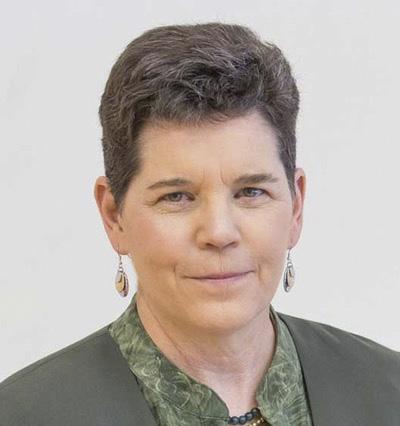
Dr. Trish Murray is a Doctor of Osteopathic Medicine and a specialist in functional medicine. She has served the MWV community for over 18 years and has helped thousands of patients optimize their quality of health with her holistic health and movement programs, including the Discover Health Movement Membership that provides online and live instructor-led classes to optimize one’s strength, balance, and flexibility. Dr. Murray is also a hiking guide with Holidays Afoot, a hiking and walking through history company, offering senior-friendly trips in the U.S. and the UK. Check out Holidays Afoot on Facebook, or to transform your health, contact Dr. Murray at discoverhealthfmc.com.
Space is limited! Book your spot today!

LETS GO FOR A HIKE!
June 7-13, 2024 (6 days, 6 nights)
North Devon, England South West Coast Path
This amazing hiking adventure will travel along England’s South West Peninsula on the North Devon coast. This charming section reaches from Lynmouth, which is affectionately called “Little Switzerland,” through a series of picturesque harbor-side villages, taking in the towering cliffs and rock formations of the North Exmoor Coast.
Explore the sandy beaches, fossil cliffs, medieval towns, and a moorland national park on this splendid scenic coastline!
For more info, visit www.bit.ly/3T85N98, or email brenda.holidaysafoot@gmail.com.
SCAN FOR MORE INFO!





Spring 2024 13 Furniture & Mattresses For Lake & Mountain Living Email us: cozycabinrustics@gmail.com Visit our website: www.cozycabinrustics.com 599 Tenney Mtn. Hwy Plymouth, NH 03264 603-238-3250

FROM SURGERY TO SUMMIT
Joint Replacement and the Renewal of Outdoor Spirit
By Dr. Joshua Knowles
Recently, I found myself on a chairlift, sharing the ride with a seasoned skier whose weathered jacket proudly declared his membership in the 80-year-old-plus club. Intrigued by his boundless energy, I asked him about his secret to staying so vibrant. With a gleam in his eye, he shared a revelation that changed my forever perspective on aging. “My knees used to hold me back,” he chuckled, “But after joint replacement surgery, they’re the strongest part of me!”
In the heart of the Mt. Washington Valley, amidst the breathtaking scenery, there’s a quiet revolution happening in joint replacement surgeries. Modern medical techniques have shifted the focus of surgery from solely relieving pain—it’s now about restoring the zest for life that defines our mountain community.
Recent advancements in joint replacement surgery have not only transformed implant design but also revolutionized surgical techniques.
Amidst this community, a recurring story has begun to resonate: the patients from our orthopedic clinic are shattering our expectations, and their own, as to how far they can go with a new knee, hip, or shoulder.
This story is one that Chris, a local real estate agent, knows all too well. Chris’s journey began with relentless hip pain that threatened to steal his love for hiking, biking, and skiing. Determined to reclaim his freedom, he embarked on a path that led him to total hip arthroplasty—a decision that would redefine his life’s trajectory.
Arthroplasty, the medical term for joint replacement, became Chris’s ticket to a pain-free existence. With a new hip joint crafted from cutting-edge materials, and implanted using minimally invasive techniques, Chris found himself on a swift path to recovery. Between his hip operation and his return to the trails, he experienced less pain, faster healing, and a quicker
return to the activities he loved. With renewed vigor, Chris set himself a goal: to ski 70 days out of the year—a testament to both his determination and the effectiveness of modern joint replacement techniques.
But Chris’s story is just one chapter in the saga of joint replacement’s evolution. Advances in implant design, same-day discharge protocols, and breakthroughs in pain management have transformed the patient experience. No longer confined to hospital beds, patients are returning home on the same day as their surgeries, surrounded by the comfort of their homes.
Brian, a local snowboard and ski instructor at Cranmore Mountain, underwent knee replacement over 20 years ago after a bad accident. He was in his late 30s when he injured his knee and had undergone eight surgeries. Since he decided to have his knee replaced, he has been teaching snowboarding and skiing. He says that he is immensely grateful that his initial injury did not hinder him from spending the next 20 years on the mountain.
There have been several notably spectacular technical and medical advancements that have propelled hip and knee arthroplasty into the modern era, giving people like Brian and Chris longevity in their active lifestyles.
Let’s follow the journey of a hypothetical patient, Nancy. Nancy’s story began with a history of injury, or possibly years of worsening arthritis, leading to persistent pain and limitations in her daily activities. Despite trying physical therapy, injections, and other treatments, her condition continued to deteriorate. Eventually, Nancy and her healthcare team decided that surgery was the best option. Prior to the procedure, Nancy had appointments with the physical therapy and preoperative teams to prepare for surgery and ensure her medical conditions were optimized.
Nancy’s pain was managed with long-term nerve blocks, special shots that stop pain signals in specific areas. Prior to the surgery these shots are given near the nerves using ultrasound, which helps the doctor put them in exactly the right spot. During surgery, Nancy also got injections directly into the joint, which helped ease her pain right away. Newer medications that last longer have improved these treatments, making them more effective.
14 MWVvibe.com
This comprehensive pain management approach motivated Nancy to actively participate in rehabilitation, accelerating her recovery and enabling her to regain mobility and satisfaction more swiftly. All of these techniques allowed Nancy to return home much sooner after her surgery than would have been possible in the past, facilitating her transition to a supportive environment for continued healing.
Recent advancements in joint replacement surgery have not only transformed implant design but also revolutionized surgical techniques. Modern implants, made from durable materials such as titanium, cobalt-chromium alloys, and high-density polyethylene, offer enhanced durability and wear resistance. For patients like Nancy, these advancements mean receiving implants engineered with advanced materials and precision design, providing improved function and stability. Additionally, the emergence of press-fit implants, which securely fit into the bone without the need for cement, offers surgeons a versatile alternative to traditional cemented implants, allowing for greater customization and potentially better outcomes.
Nancy also benefited from minimally invasive techniques in her joint replacement surgery, resulting in a quicker recovery. These approaches involve smaller incisions, sparing surrounding tissues and muscles from unnecessary trauma. As a result, Nancy experienced less post-operative pain and faster healing, allowing her to resume her normal activities sooner than anticipated. In addition to these technical advancements, personalized physical therapy regimens and comprehensive follow-up care further optimized Nancy’s outcome, ensuring a smooth transition back to her active lifestyle.
Looking ahead, the future of hip and knee arthroplasty is filled with promise and potential. With ongoing research and development efforts focused on enhancing implant design, surgical techniques, and post-operative care, the field continues to evolve at a rapid pace. From personalized implants tailored to individual patient anatomy to innovative therapies that promote tissue healing and regeneration, the possibilities are endless.
As we celebrate stories like Chris and Brian’s and marvel at the remarkable progress in joint replacement surgery, we’re reminded of the transformative impact it has on individuals’ lives. In the Mt. Washington Valley and beyond, joint replacement isn’t just about restoring mobility—it’s about empowering individuals to reclaim their independence, pursue their passions, and embrace life’s adventures with renewed vigor and enthusiasm. With each surgical innovation and every patient success story, we move closer to a future where limitations are overcome, and dreams are within reach.

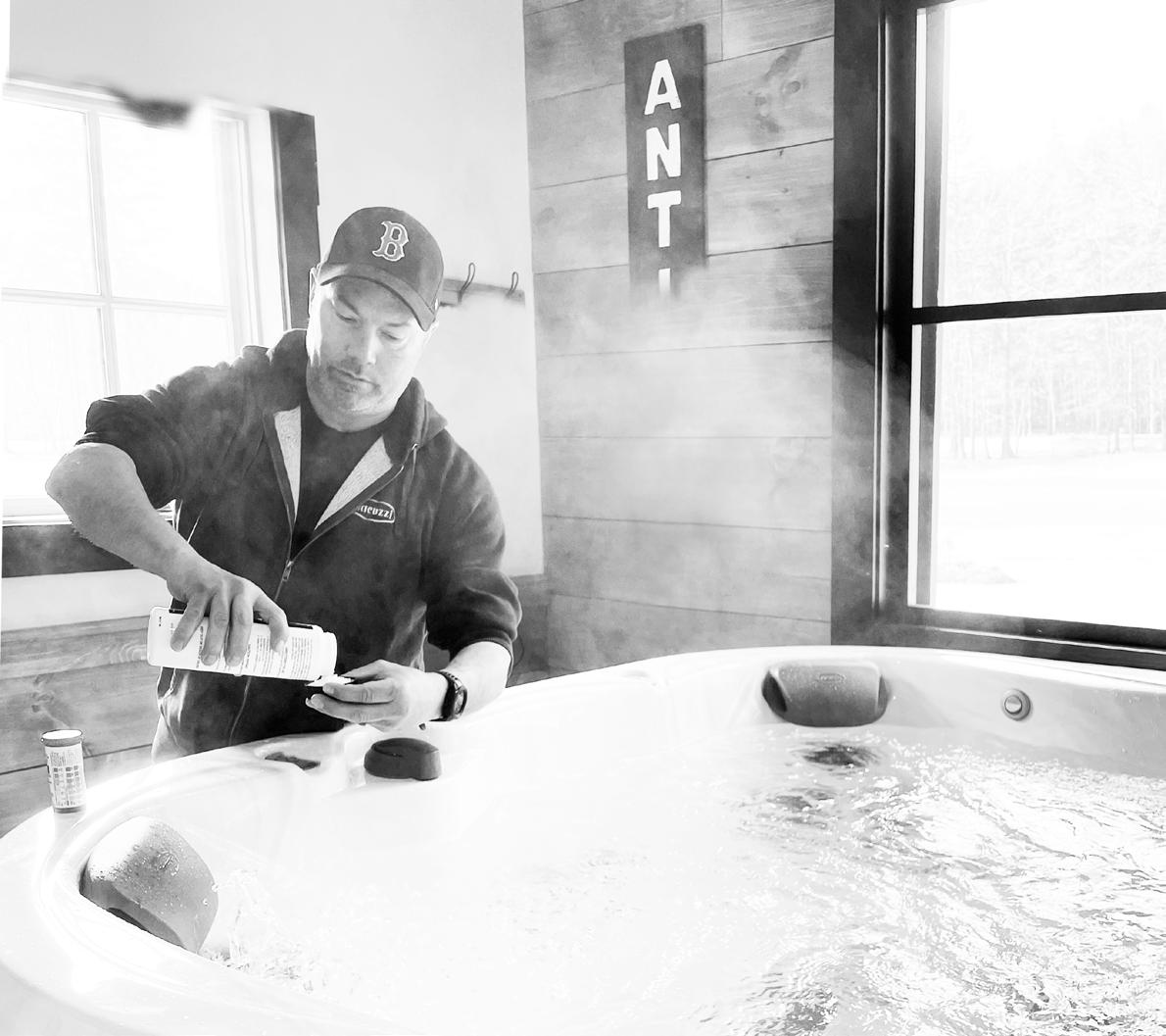
Dr. Joshua Knowles, D.O., is a dual board-certified orthopedic surgeon and sports medicine specialist, serving as medical director at Memorial Hospital’s expanding orthopedics and sports medicine practice in the Mt. Washington Valley. Dr. Knowles is dedicated to expanding a premier orthopedic center focused on top-notch care and community support, empowering patients to lead active lives. For more on Memorial Hospital Orthopedics and Sports Medicine, call call (603) 356-7061. or visit www.memorialhospitalnh.org/orthopedics.

Spring 2024 15
Perform at your peak. Add hydrotherapy to your White Mountain lifestyle with a Jacuzzi. www.WMHotTubShop.com Southside Building at White Mountain Trading Post 15 Town Hall Road, Intervale, New Hampshire The largest Jacuzzi showroom throughout New Hampshire. chemicals and hot tub tools fully stocked regularly scheduled service available covers, stairs and umbrellas displayed in a variety of styles MAINTAIN ACCESSORIZE SERVICE
ART IN THE VALLEY
By Lily Hartman
Plein Air Painting in the Picturesque Whites. What a Canvas it Creates!
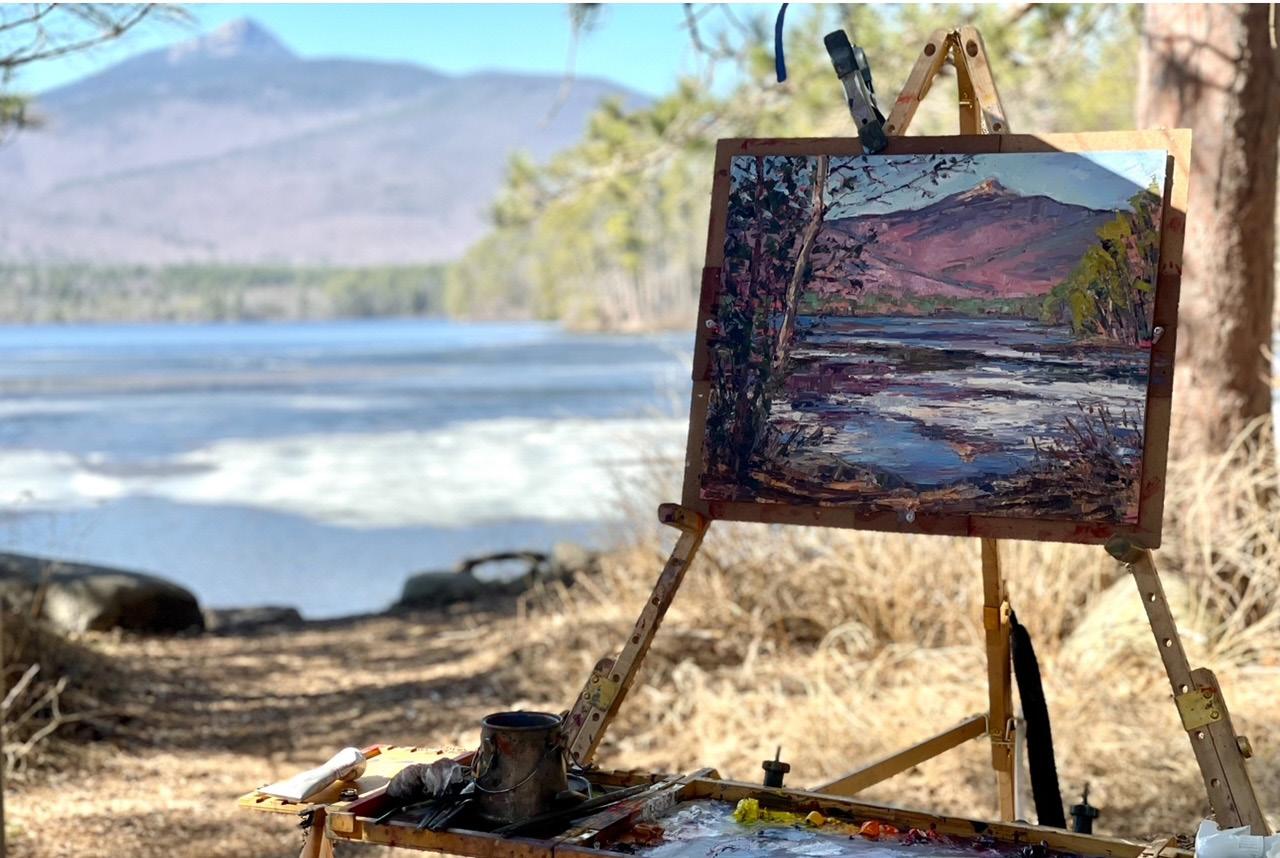
The Mt. Washington Valley is a place that draws outdoor enthusiasts from all over. There’s nothing like catching a glimpse of Mount Chocorua while driving down Route 16, walking
“In this area, because of the mountains and because of where we are, there are so many layers of depth that can be painted,” says Lori Stearns, an artist from the Valley who has been plein air painting
35 professional artists—most from the local area. Oftentimes, Stearns will set up her easel outside with Levitt. They’ll each create everything from vibrant paintings of birch trees and snowy fields to Mount
Plein air painting is from the French term, “painting in the outdoors,” and is “one of the biggest movements of art right now,” says Melanie Levitt, the owner of Jackson Art Studio‚ an art space located off Route 16 in Jackson that is home to 35 professional artists—most from the local area.
along historical bridges, and experiencing the tranquility of flowing rivers. While here, you’ll see skiers crowding Pinkham Notch in the winter and spring, and hikers heading to the trailheads to climb the tallest peaks in the state year round. While this area’s beauty inspires adventure enthusiasts, it’s also a place that sparks creativity.
and taking other painting classes for 20 years, who is now becoming a professional painter.
Plein air painting is from the French term, “painting in the outdoors,” and is “one of the biggest movements of art right now,” says Melanie Levitt, the owner of Jackson Art Studio‚ an art space located off Route 16 in Jackson that is home to
Washington in the distance in different seasons from the Intervale Scenic Vista.
This style of painting is different than painting from a picture because you’re painting from real life. While the wide-open space can make focusing in on something more difficult, Levitt says that it makes you a stronger painter because you are feeling the breeze from the wind,
16 MWVvibe.com
MT. WASHINGTON VALLEY ARTISTS & GALLERIES

Artworks
132 White Mountain Highway, Chocorua, NH • (603) 323-8041
www.chocoruaartworks.com
Bill Fein Gallery
106 Fein Lane, Center Conway, NH (603) 356-7943
Cook Memorial Library
93 Main St, Tamworth, NH (603) 323-8510
www.tamworthlibrary.org
Edge of Maine Art & Framing
182 Main St, Brownfield, ME (207) 935-2817
www.edgeofmaine.com
Erik Koeppel Fine Art Jackson, NH • (603) 383-7062
www.erikkoeppel.com
Fryeburg Harbor Antiques and Fine Art Gallery
506 Harbor Rd, Fryeburg, ME (207) 925-2848
www.fryeburgharbor.com
Gallery 302
112 Main St, Bridgton, ME (207) 647-2787
www.gallery302.com
Gateway Gallery & Gifts
32 Exchange St, Gorham, NH (603) 466-9900
www.gatewaygallery.biz
Harvest Gold Gallery
1082 Main St, Center Lovell, ME (207) 925-6502
www.harvestgoldgallery.com
Jesse Mixer Metalsmith North Conway, NH
www.jessemixer.com
Jackson Art Studio & Gallery
155 Ridge Rd, Jackson, NH (603) 387-3463
www.jacksonartnh.com
Karen Eisenberg Designs North Conway, NH • (603) 662-9887
www.kareneisenberg.com
League of NH Craftsmen
North Conway
2526 White Mountain Highway, North Conway, NH • (603) 356-2441
www.northconway.nhcrafts.org
Linda Gray
Intervale, NH • (603) 986-1028
www.lindagrayartwork.com
Louise Perry of Vintage Frameworks
28 Norcross Circle, North Conway, NH (603) 356-7711
www.vintageframeworks.com
Main Street Gallery/MWVArts
16 Norcross Circle, North Conway, NH (603) 356-2787 • www.mwvarts.org
Molly Mundy Art and Illustration Jackson, NH
www.mollymundy.com
Nathan Macomber Glass Studio 480 Eaton Rd, Conway, NH (603) 447-1825
www.macomberglass.com
NW Cassidy Fine Art (603) 662-2074
nwcassidy@earthlink.net
Patricia Ladd Carega Gallery
69 Maple St, Center Sandwich, NH (603) 284-7728
www.patricialaddcarega.com
continued on next page

Spring 2024 17
Nathan Macomber Glass Studio, Conway, NH
Spring Plein Air Classes and Supply List for Oil Painting
In the spring, plein air painters will be dealing with different elements, such as bugs, mud, and rain. Participants will need to arrive at classes prepared with the right supplies and gear.
Here is a list of everything painters typically need to take plein air classes.
• Portable plein air easel and palette (French easel or pochade box with tripod)
• Small sketch pad & drawing pencils
• Solvent container with clamping lid
• Gamsol oderless mineral (solvent)
• Limited palette of oil paints (a warm and cool of each primary, plus white)
• Brushes: filberts, flats, rounds
• Medium to mix into your paints with a small container
• Panels or canvases
• Paper towels & grocery bags for trash
• Painting clothes (dress in layers)
• Bug spray
• Sunscreen
• Wide-brimmed hat
• Food and water
Optional items include disposable gloves, wet paint carrier, plein air umbrella, baby wipes (to get paint off your hands), clamps or bungee cords.
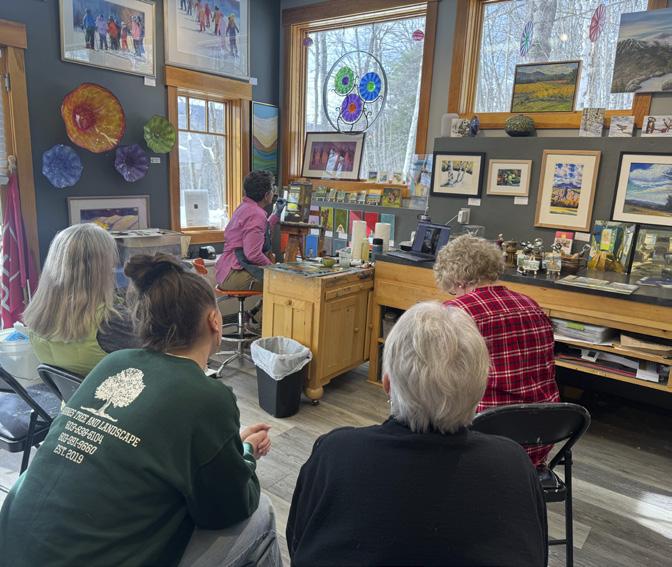
If you are interested in taking a plein air painting workshop at Jackson Art Studio this spring or summer, visit the studio’s website at www.jacksonartnh.com. Private and semi-private plein air painting classes are also available.
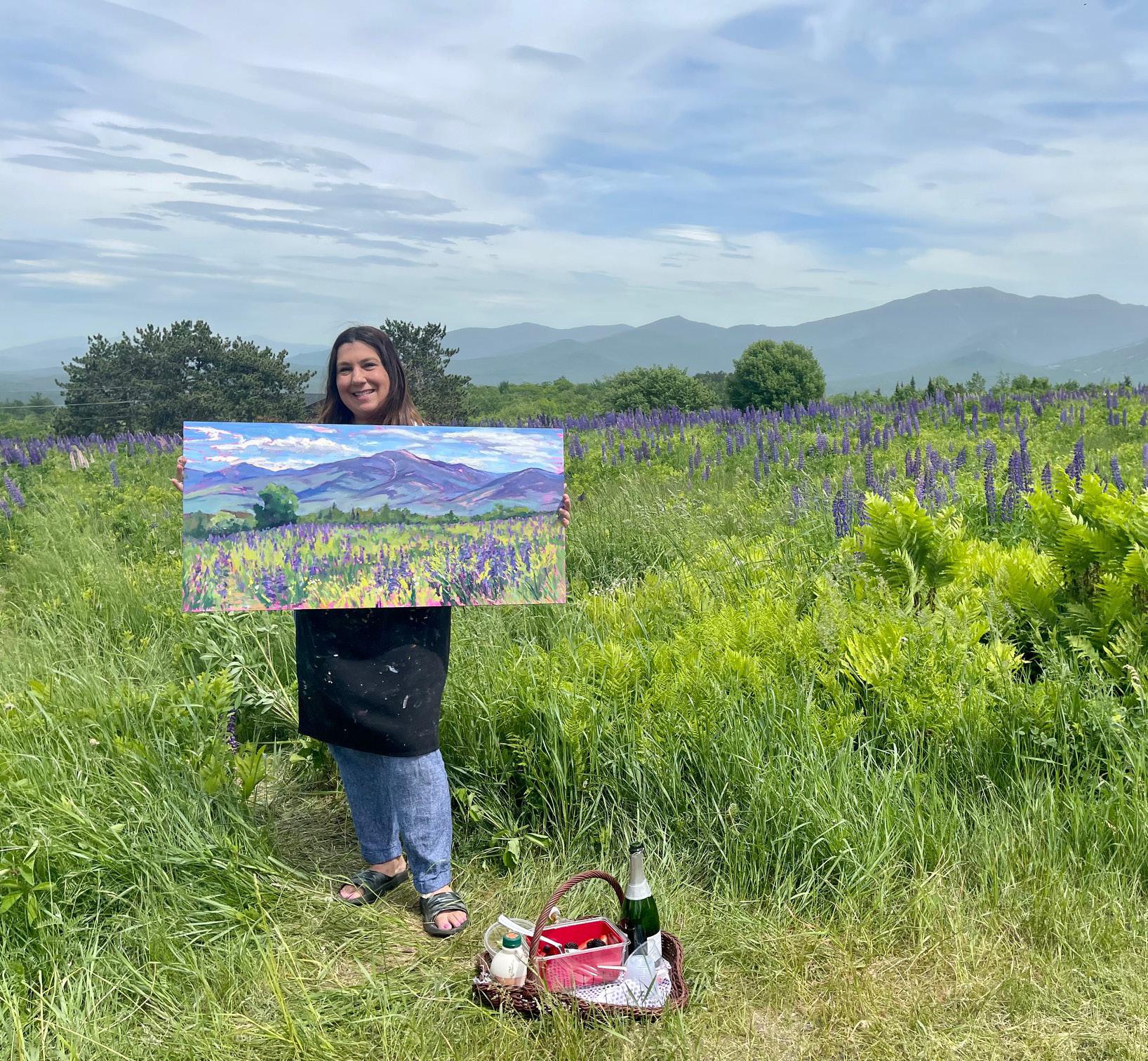
seeing the light and true color through your own eyes, and painting something from the landscape that inspires you.
“For me, it’s like, ‘Wow, look at those birch trees and look at that light hitting the edge,’” says Levitt. Because of the deep shadows of the Valley, light can change quickly, so plein air painters have to create their paintings within a three-
“Each painting is like a story, and it’s kind of like a dance with the palette knife back and forth,” says Levitt, who teaches this method in beginner classes at the studio. “People like it because it’s something different.”
Described by Kobilansky as a place with “good energy,” Jackson Art Studio is just a mile away from Jackson Village
Each painting is like a story, and it’s kind of like a dance with the palette knife back and forth,” says Levitt, who teaches this method in beginner classes at the studio.
hour window—usually in the morning or evening.
“Every spot [in the Valley] is just asking to be painted—everywhere you turn,” says Valentina Kobilansky, a professional plein air and studio painter, who has work displayed in the studio.
Levitt uses an impressionist style to plein air paint, meaning she’s not looking to recreate landscapes exactly as she sees them, but instead feels the landscape and uses a palette knife to stay loose, layer, and create color on top of color.
and offers a warm and welcoming environment as soon as you walk in the door. The natural sunlight beams over the brown wooden floor and bright orange couch, while diverse art covers the walls. Walking through the studio, you’ll be immersed in art by local artists in the Valley—you’ll experience pottery, photography, hand-blown glass, and paintings of local mountain scenes and wild animals. The studio is also a place where extraordinary artists are teaching you to paint in “one of the most beautiful places in the
18 MWVvibe.com
MWV ARTISTS & GALLERIES continued
Robert Gordon Gallery
Kancamagus Highway, Conway, NH • (603) 356-7943
Roger C. Williams Fine Art
125 Main St, Lovell, ME (207) 925-3380
www.rogerwilliamsfineart.com
Skyforest Gallery
407 White Mountain Highway, Conway, NH • (760) 770-3777
Surroundings Art Gallery
12 Main St, Sandwich, NH (603) 284-6888
www.surroundingsart.com
Stained Glass Shack Studio
63 West Main St, Conway, NH (603) 447-4949
www.stainedglassshack.com
The Rustic Pyro
28 Main St, Conway Village (978) 387-8030
Three Sisters Gallery Studio 36 Exchange St, Gorham, NH (603) 915-2175
www.the3sistersgallery.com
Virginia Moore Pet
Portraits & Fine Art
83 Crossover Rd, Albany, NH (603) 520-8230
www.vmooreportraits.com
White Mountain Artisans Gallery 3358 Route 16, No. Conway, NH (603) 356-6546
White Mountain Photography
95 Main St, Jackson, NH (603) 374-6050
www.whitemountainphoto.com
With These Hands Pottery
397 Tasker Hill Rd, Conway, NH (207) 256-2522
www.withthesehands pottery.com
Please report corrections or additions to info@mwvvibe.com.
world,” says Stearns.
The studio hosts beginner-friendly plein air workshops, where participants set up at a beautiful spot outside and learn the basic skills of plein air painting. Levitt says that these classes are all about taking in what you see, learning composition, and getting paint onto the canvas. While many participants come into classes nervous to paint for the first time, Levitt says that it’s important to relax into it and not be super stressed about the outcome.
Stearns says that each of us has an inner critic, and being able to recognize that and let it go is an important step in unlocking our creativity—whether that is while writing, hiking, or painting the landscapes of the Mt. Washington Valley.
“I go to another place [when I paint],” says Levitt. “It’s really a meditation.”
Although the experience of plein air painting is individual, there’s no denying the bond between painters in the Mt. Washington Valley. Levitt says that they are a tight-knit group because they all share that love of being an artist. It’s common for artists who take classes at the studio to get together on their own, head out on a hike, and plein air paint the breathtaking scenery in front of them while forming lifelong friendships.
“People are coming from all over to take classes at Melanie’s gallery,” says Stearns. “They say, ‘Wow, this is the place to come.’”

Spring 2024 19
By Bernadette Donohue

I’ve been thinking a lot lately about my dad and the many blessings and life lessons received from his good nature and unpretentious intellect.
The kitchen table was always our gathering place, providing nourishment of body, mind, and soul. While feasting on delicious meals prepared by mom, dinner conversations ensued about all of life’s ups and downs. With an 11-year span between oldest and youngest, the seven of us kids would constantly be vying for attention and a voice at the crowded table. It’s no wonder that our noisy and nosey discussions were sometimes sidetracked with Dad’s frequent reminder to “MYOB” (mind your own business).
Another treasured phrase was, “If you can’t say something nice, don’t say anything at all.” This quote, often credited to the adorable Thumper from the 1942 animated Disney film Bambi, echoed as a reminder of important family values to put forth our thoughts and feelings more mindfully. We were coached from an early age to include kindness, objectivity, and patience with the understanding that everyone has their own valid opinions, which will often differ from our own.
The intentional parenting received from both dad and mom imparted much wisdom for overcoming unexpected adversities and for leaning into what makes us authentically happy people. I’m guessing there were some “extra bene-
Transforming Your House to a Home
fits” bestowed on us from dad’s career as a doctor, specializing in child psychiatry. Family activities, yard work, and household chores were filled with silliness and song, while grounded in the ethics of hard work, persistence, and determination with an emphasis on integrity, loyalty, and honesty. Loving guidance helped us to understand that there were always repercussions for our choices, and that thinking ahead would (usually) help us to
Owning a home gives individuals and families a deeper feeling of stability, safety, and security over their personal space and belongings, and contributes to less stress and a greater sense of autonomy over one’s destiny.
make better ones. Taking full responsibility for our actions as well as our happiness was often the underlying theme.
Zen Master Thich Nhat Hanh said, “There is no way to happiness, happiness is the way.” Indeed, if this is true, then finding and embracing joy as the journey and not the destination is the essence of a lifetime of happiness. Life continues to offer us all the ability to make vital lifestyle choices that will ultimately bring us closer to fulfillment. One of those major life choices is where we choose to reside.
Where we call “home,” and who we decide to share that home with, becomes a significant source of our psychological well-being.
There are many published research articles written about the benefits of homeownership being much more than just financial. As reported in the National Library of Medicine, “We find that home ownership improves both physical and psychological health.” A 2021 study by the National Health & Medical Research Council reports higher levels of well-being based on the many emotional benefits of ownership. Amongst the reasons listed is “a deeper sense of stability and belonging and an emotional connection to community.” A Harvard study in 2001, with Joint Venture Housing, supports this opinion in saying that “social status and personal freedom associated with homeownership leads to higher levels of self-esteem and a perceived control over ones’ life.”
Owning a home gives individuals and families a deeper feeling of stability, safety, and security over their personal space and belongings, and contributes to less stress and a greater sense of autonomy over one’s destiny. Being able to share your space with those you love creates incredible bonds, as well as memories. Whether you are part of a family, neighborhood, community, or town, there are many ways to engage and feel connected
20 MWVvibe.com
REAL ESTATE CORNER


as a homeowner. Developing supportive relationships and having a voice on matters that matter … matters!
What is true about homeownership in general is also true about the location you choose to call home. Here in the White Mountains and Lakes Regions of NH and ME, we enjoy the opportunity to indulge and soak in some of the many psychological benefits of nature’s beauty and adventure because of its rich and diverse terrain. Conservation lands surround our communities with the dichotomy of gentle hillsides and steep peaks, rushing rivers and slow meandering streams, serene ponds, and action-packed lakes, green meadows, and heavily wooded forests. It is easy to choose to relax and de-stress or adventure for exhilaration, as nature provides a plethora of daily choices with essential health advantages.
Many people have already recognized the importance of living—or vacationing—in a place they love, as shown by the significant increase in property ownership demands for the more sublime areas of our nation. I have met many people in my 40-year real estate career who have admitted that they “should have” moved to the Mt.
TUCKERMAN ON THE COVER
Deidre Noreen Blair is an oil painter living in the White Mountains of New Hampshire. She grew up in a military family and considers many parts of the country and world her home. Deidre has a degree in studio arts from Portland State University in Portland, Oregon. Her work is known for its bold use of color and whimsy, and is greatly influenced by the natural world and by the works of fellow artists, both near and far.
Deidre owns The Three Sisters Gallery in Gorham, NH, where she has a working studio. The gallery’s name drew inspiration from the “three sisters garden,” a planting technique where corn, beans, and squash are grown together. Each crop supports and nurtures the growth of its fellow plants. The gallery strives to be a gathering place where artists, their crafts, and the community find a mutually supportive and nurturing space. Deidre feels very fortunate to promote and sell the works of over 20 fellow local artists at The Three Sisters Gallery.
The gallery has a current “Call for Art,” for the 2nd Annual Tuckerman Ravine Group Show. Artists of all mediums are encouraged to submit work for consideration for this Tuckerman Ravine inspired show. Submissions are due on July 1, 2024. Opening night of the show is August 3, 2024. For complete information and submission, visit www.3sistersgallery.com. You’ll also find information about other upcoming events.
If you have any questions, email the3sistersgallery@gmail.com.
Washington Valley or Lake Region much sooner. It becomes apparent that once people prioritize health and wellness, their moving decisions become easier, and logistics work themselves out, with the help of some insightful real estate guidance. With an intentional measure of thoughtful planning, families can make decisions that will positively impact their overall well-being. Prioritizing mental, physical, and spiritual health was the transformative fatherly guidance I received and continue to cherish from my late, great dad. As my thoughts turn towards my own life lessons, I sincerely hope that you, too, allow the joy of nature’s embrace to welcome you home to a happy and healthy lifestyle.
PROFESSIONAL SUMMER THEATRE

Camelot June 27- July 6
Lerner & Loewe
Educating Rita July 11 - 20
Willy Russell
Into the Breeches July 25 - August 3
George Brant
Go Back for Murder August 8 - 17
Agatha Christie
Bernadette Donohue, REALTOR & Certified Residential Specialist, CRS. Serving the real estate needs of NH and ME, since 1985. Contact Bernie at Badger Peabody & Smith Realty, BernieD@BadgerPeabodySmith.com, (603) 356-5757 x 310 or cell(207) 542-9967
Pride and Prejudice August 22 - 31
Kate Hamill, adapted from the novel by Jane Austen

104 Main Street, Tamworth
Tickets: 603-323-8500 barnstormertheatre.org
Spring 2024 21
SUMMER 2024
By Clem McAuliffe
In Search of the Summer Suds Scene
Alas, my parched compadres of après, come hither, come fro, come Heather, come Joe. Grab your flagon or stein, if naught, you can borrow one of mine. For the time is nigh for me to quell your queries of beeries. There are tales of ales to be told! Sit as I sate your unsatiable taste boldly unthwarted, knowing once started there are few who departed. Our local brew masters bestowed upon me upcoming news of their mind-numbing brews, so soak in another of my signature sesquipedalian synopses of said suds. Enough panache—let’s pull some pints!
Starting off with the Lukr Side Pull used at Saco River Brewing in Fryeburg, Maine. Newly invented in the 1990s, this unique beer tap uses a micro screen to aerate the beer, creating a creamy wet foam with a smooth texture packed with flavor and aroma from the hops. Owner and head brewer Mason Irish, has his Munich Style Helles pumping out the said pull for a perfect spring beer. This 5% light-bodied lager sports a honey-like light malt character and pops delicate floral hop notes from the soft head of the side pull. Saco River Brewing will roll out a Raspberry Gose

(still unnamed) brewed with seal salt, coriander, and over one pound per gallon of raspberry puree added after fermentation. With a bright red hue and flavors of summertime fresh berries, this 4.5% tart German-style ale is pretty enough to wear as a hat, or a beret.
For those of you who haven’t ventured ALL the way to Fryeburg, your prayers have been answered. Saco River Brewing is opening a second location in North Conway at the old Olympia Sports/Carroll Reed building. It will have 3,500 square feet of inside space, street-side seating,
Photo work by WiseguyCreative.com
and a 1,200-square-foot rooftop deck. As if that wasn’t enough, they will be joined by two other local favorites, Sap House Meadery and Cheese Louise.
Let’s truck on over to Tuckerman Brewery to check on their ever-expanding selection and space. The fan-favorite Summer Pils will be back with a vengeance. This Pilsner is brewed with Citra hops, German Weyermann® malts, and real orange zest prepped by hand at the brewery. It’s a 4.5% lawn beer that’s light with citrus aromatics and a subtle, almost bready, malt body.
As the days get longer, my beers get

packaging; in simpler terms, cans. The outdoor Biergarten is being revamped to add even more room to an already spacious, comfy lawn. So there’s plenty of space for the whole family, and your neighbors too.
Making my way through town, let’s hop into the Moat Mountain Smokehouse and Brewery to hear their latest. A dank offering of left coast lupulin legends Amarillo, Columbus, and Simcoe are teamed up for their Cali 1 IPA. This 6.8% O.G. brings you back to days of beers in bottles. It’s true, they used to bottle beer. Cali’s chewy citrus and resinous pine notes flow fluidly with a thin
For those of you who haven’t ventured ALL the way to Fryeburg, your prayers have been answered. Saco River Brewing is opening a second location in North Conway at the old Olympia Sports/Carroll Reed building.
lighter, and this beaut is always on my mind. Also always on my mind is Saint Patrick’s Day, and Tuckerman celebrated by introducing us to their Irish Red ale. A 4.6% traditional style red ale with a slight amber body, toffee aromas, and a smooth malt finish. This brewer special sold out crazy fast last year, so a larger batch this year means more beer at the tap house and enough for retail
hint of malt to keep this brew balanced like a ballerina on a surfboard. Mad props to this old-school classic. Next, Moat brings in the freshies with their Kearsarge Kolch. Much like Stoßlüften, the age-old German tradition of letting fresh air into the house, this 4.9% clean, subtle cruiser clears the cobwebs of winter. Kearsarge Kolsch is named with fond memories of Ludwig W. Schiessal,




Hobo Joe has been a long-time local favorite and best of all its infused with medium-roast Columbian bean cold brew coffee from local favs Frontside Coffee Roasters! Smooth and light, yet bold in flavor, Hobo Joe is coffee-forward with a bakers-chocolate finish, sitting at an easy 5.3% ABV. Stop in and give this one a try if you’re new to this Ledge classic.

in honor of his daily hikes up North Kearsarge. Próst!
Whether you pronounce it Kancamagus, Kancamangus, or Cucamonga, a road by any other name is still a road. This particular road takes you to North Woodstock, NH, home of the Woodstock Inn Brewery. Aesop would also tell you that a beer by any other name is still a beer, but for the sake of clarity, let’s call this one Burst of Green. This 8.4% DIPA features Citra, Nectaron, and Bru-1 hops to bring out a big hazy brew bursting like the first buds. In this rotating IPA series, every batch will star a different hop combo, so don’t dilly because it’s one and done for a Burst of Green fun. Now, how about a Honey Lemon Blonde Ale to put some spring in your step? Brewed with real New Hampshire-made honey and lemon drop hops, this 4.5% invigorating brew keeps the bees swarming to the hive.
Next out of the “Woods” comes Into the Clouds. This new double hazy IPA manifests a menagerie of candied apricot, pineapple, cantaloupe, and honeydew melon. An 8% powder puff pint that picks you up and
Back from Belize is their Toucan Mango Hefe. Yes, I said Belize! Hobbs also has a sister brewery in Placencia, Belize, that features their tropical take on a German Hefeweizen.
puts you into the clouds. Lastly, is the lovely Lemon Blueberry Pale Ale, a springy thirst quencher with a peck of lemon and blueberry flavor in the finish. This babe can bring fruit to the table and tastes like an ale brewed in a fable.
Spring is the time to come out from our winter recluse and there’s no better place to dust off than rek’•lis brewing company in Bethlehem, NH. Lagers are all the hype, and it’s time for the world to fill their coolers with Premium Lager from rek’•lis. Smooth, with that crispy malty flavor we love from a lager, Premium Lager carries so much flavor through every sip, without being more complex than a lager should be. Weighing in at substantial 6.5% ABV, I can only describe it in one term: liquid gold. Go dig one up and see for yourself.
Another hot beer craze is the Cold IPA. This IPA is made with lager yeast and fermented at ale temperatures, creating a crushable brew that has the easy, nearly bitter-free mouthfeel of a lager, but the hops and flavor of an IPA. Ice Hole Cold IPA by rek’•lis adds heaps of El Dorado and Matueka hops to give this 7.2% hybrid a bright crisp smack to your lips with a lemony finish. I say put an Ice Hole in your pie hole before the lakes thaw.
I’ve been to the Hobbs Tavern + Brewing Co., just 10 miles apart on Route 16 in Ossipee. Both serving up Hobbs Brewing Company beer and dining delectables that filled my face and belly. Now, I’m told they have added The Hayloft to the tavern, with pizza, wings, and of course, their trademark local brews. This spring has stars like Salinity Now!, a 4.7% kettle-soured Gose Ale brewed with Isles of Shoals sea salt, toasted coriander, and aged on a generous dose of raspberries. This sour always puts a smile on my face—and it’s not from the Seinfeld reference. We can’t all have a life on the lake or a lady in the lake like King Arthur, but we can all have a Lake Life Pale Ale. A classic 5.9% ale built on a solid, slightly soft malt foundation with hops of Citra and Simcoe, shooting arrows of citrus and pine at your taste buds, and you don’t have to pull it from a stone.
Back from Belize is their Toucan Mango Hefe. Yes, I said Belize! Hobbs also has a sister brewery in Placencia, Belize, that features their tropical take on a German Hefeweizen. Only available seasonally in the states, primarily New Hampshire, Toucan Mango Hefeweizen does what it says. First, fruity mango aromas, followed fast by a mango-forward flavor firmly finishing with traditional Hefe hints of banana and clove. Say that
24 MWVvibe.com
• Over 500 Craft Beers • Make Your Own 6-Pack • Just South of Storyland 779 ROUTE 16, GLEN, NH (603) 383-4800
BOOMER!
COLLABORATES WITH FRONTSIDE
Come by to say hi to
LEDGE
five times fast after five of those five percenters.
Lady Gaga sings about being on “The Edge of Glory.” Well, I’m here to tell of being on the Ledge of glory. Glorious beers at Ledge Brewing Company, on Town Hall Road in Intervale are worthy of singing about. But you don’t want my tone-deaf wailings, believe you me! What you do want is the spot-on brewing from brewmaster, Cody Floyd. Whether it’s juicy hazy IPAs like As You Wish or dark smooth stouts like Hobo Joe, Ledge always plays their hits. The lager programming is strong all year long, using traditional techniques and modern ingredients. Spring brings Slow Train, a dry-hopped Pilsner with Mosaic and Hallertau Blanc hops. This crisp Pils takes you to the edge of the hop ledge and keeps you safely cliffside without hurling you into the lupalin abyss. Their classic German Afternoons will be back and stay all summer long like a child back from college, except this beer will actually spend time with you.
Ledge enjoys spending time wisely with their barrel-aging program being in full swing, thanks to local distilleries, Tamworth and Cathedral Ledge. The next pint of patience will be Country Mile, a 9% Baltic Porter aged in apple brandy barrels from Tamworth Distillery. A rich jet-black lager that’s full-bodied and smooth with notes of semi-sweet chocolate and brandy. These small-batch beauties are limited, so if you find one, buy one. Or, get a couple and store them safely to see for yourself how they mature year to year.
Just before the landmark wooden moose at the end of Route 16 through Pinkham Notch is Big Day Brewing in Gorham, NH. The atmosphere at Big Day is anything but wooden. A fun pick-and-choose food menu that pairs perfectly with their local brews keeps me coming back for more. This spring will feature a couple of cuties in cans or daft drafts,
Ledge enjoys spending time wisely with their barrel-aging program being in full swing, thanks to local distilleries, Tamworth and Cathedral Ledge.
if you prefer. Their tart and refreshing Marge Sour mimics a margarita in beer form. This 4.2% kettle sour is brewed with gallons of lime and orange puree, plus a touch of salt. Make mine a double! Keeping things cool and crisp like springtime in the mountains is their Coos Gold Kolsch. The gold rush is on for this light, bright Kolsch-style brew that will clean your palate as you clean your plate. That’s why I say, “Any day I go to Big Day is a good day.”
As always, I would like to thank the brewers for taking the time to fill me in, and all the pint pullers who fill me up. For those who haven’t heard, my wife Sherley and I sold our beer and wine shop, Vista Bev & Market. After 13 years, we are happy to move on to a new chapter and hope to see you all out on the town. And by seeing you all out on the town, I mean seeing you all out at the breweries, in person. To those we didn’t get to say our goodbyes to, thank you so much for all the support and good times.
Cheers! Clem



Spring 2024 25
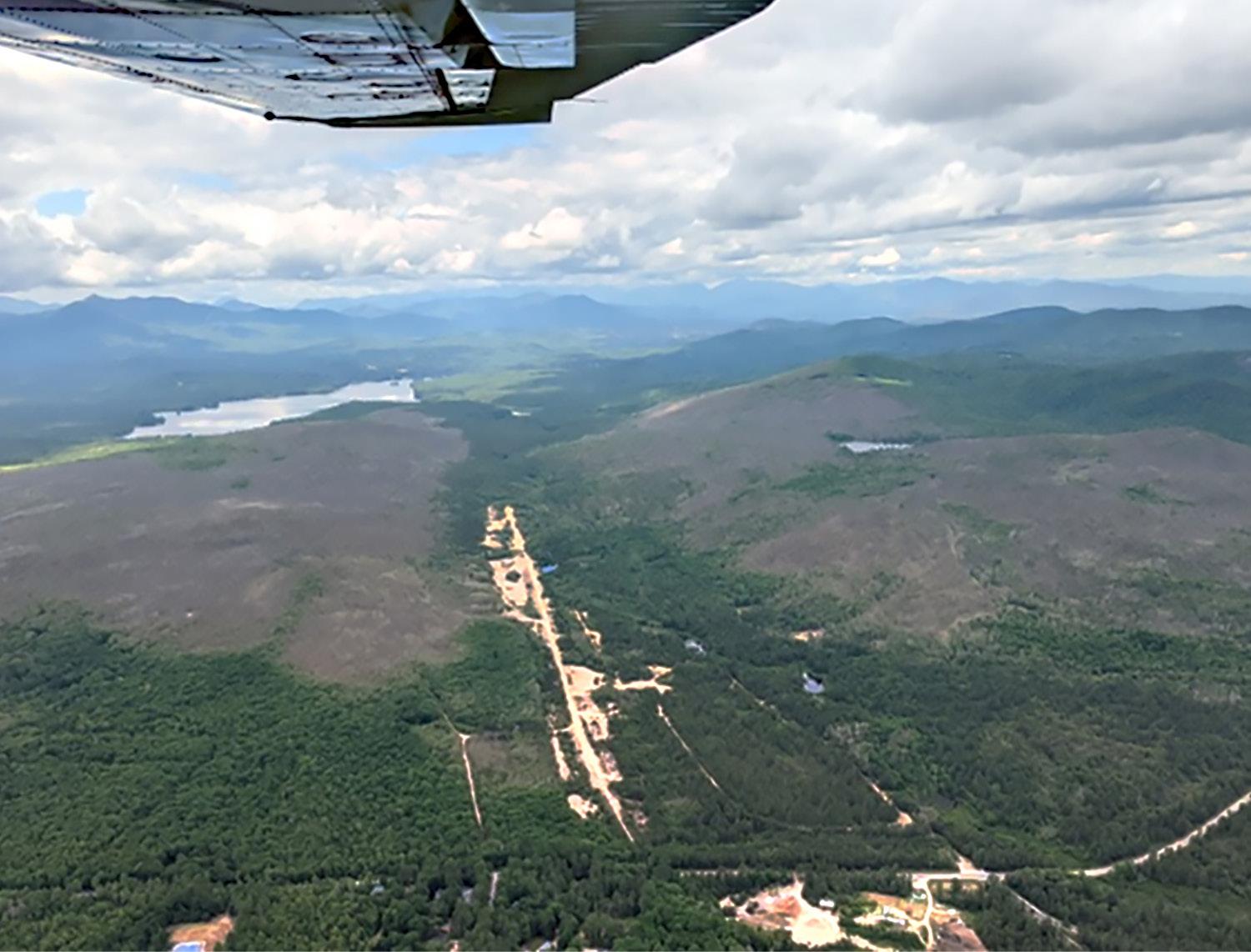
Weather in the Extreme Impacts to the Forests in the Mt. Washington Valley
By Wendy Scribner, UNH Cooperative Extension
Late spring frosts, warmer winters with less snow, summer drought conditions, and heavy rain events— these are just a few of the different weather conditions we have been seeing recently. These changes affect us all in different ways, such as dwindling water in our wells, shorter ice fishing and winter logging seasons, increasing road maintenance, more snowmaking and trail closures at the ski slopes. These changes also affect our trees and forests.
When we talk about weather, we are usually referring to short-term conditions. A particularly cold day, or a rainy week. The National Oceanic and Atmospheric Administration simplifies it to this: Climate is what you expect; weather is what you get.1 Climate often describes seasonal averages over decades, while weather is focused on a much shorter time frame— what’s out there affecting you where you are. Here, I will describe some of the impacts of our weather in the past few years. In a future article, I will focus more on larger climate implications.
Spongy Moth
The summers of 2021 and 2022 brought us over 30,000 acres of defoliation by the spongy moth (Lymantria dispar, formerly known as the gyspy moth) in the MWV area. One likely contributing factor to the large outbreak was drought conditions during the summer of 2020.
A fungus (Entomophaga maimaiga) and the nuclear polyhedrosis virus have been helping to keep the spongy moth populations in check for several decades. However, dry conditions in 2020 impeded the build-up and transmission of the fungus and the virus in the spongy moth populations, allowing their populations to explode during 2021 and 2022.
While spongy moth will consume the leaves of many tree species, they are particularly fond of red oak. Once they
White Pine Needle Disease (WPND)
Have you noticed yellowing pine needles in the spring the past few years? Does the foliage at the top of your tree look rather thin?
Widespread health issues for white pine first developed in 2009. One major stressor is white pine needle disease (WPND). Symptoms include yellowing and browning needles, premature needle shedding, and thinning canopies. While it is normal to see white pine trees lose about one-third of their needles every year, this normally happens in the fall. When we see needles falling in the spring, it is likely due to several fungi that infiltrate the needles of healthy white pine. The fungus then grows inside the needles for a year, eventually causing browning and death of needles. Researchers have found that increases in temperature and precipitation from May through July can fuel the WPND epidemic. In the case of white pine, a dry spring helped to reduce the impacts of this fungal stressor.
Northward Expansion of Hemlock Wooly Adelgid Populations
Cold winter temperatures have helped us to keep some forest insect populations in check. Consider the invasive hemlock woolly adelgid (HWA). These tiny insects, native to China and Japan, feed in the conductive tissue of small hemlock twigs. Populations build quickly, and extensive HWA feeding can kill a tree in four to 10 years. HWA also leaves trees weakened and more susceptible to other stressors. Since it was first found in Virginia in 1950,
The NH Division of Forests and Lands Forest Health Program estimates that these factors have resulted in approximately 16,000 acres of oak decline and mortality here in the Valley.
have eaten their preferred species, they will move on to defoliate others.
While healthy oak trees can usually tolerate a couple of years of defoliation, the oaks in the MWV were additionally stressed from growing-season drought conditions. The NH Division of Forests and Lands Forest Health Program estimates that these factors have resulted in approximately 16,000 acres of oak decline and mortality here in the Valley.
Changes in the timing and amount of precipitation can significantly affect the health of our forests by influencing insect and disease agents.
HWAs have caused considerable mortality to hemlock throughout the mid-Atlantic states.
HWA was first found in NH in Portsmouth in 2000. Since then, it has spread throughout the southern tier of New Hampshire and has advanced along the edges of Lake Winnipesaukee. We had hoped that the colder temperatures in the northern part of the state would slow or stop its spread; however, we have recently found populations in Conway and Jackson.
The good news is that trees that have been infested for years can remain healthy as long as adelgid populations are kept low by consistent cold winters. According to Kyle Lombard, NH Forest
26 MWVvibe.com
William Davidson, NH Division of Forests and Lands.
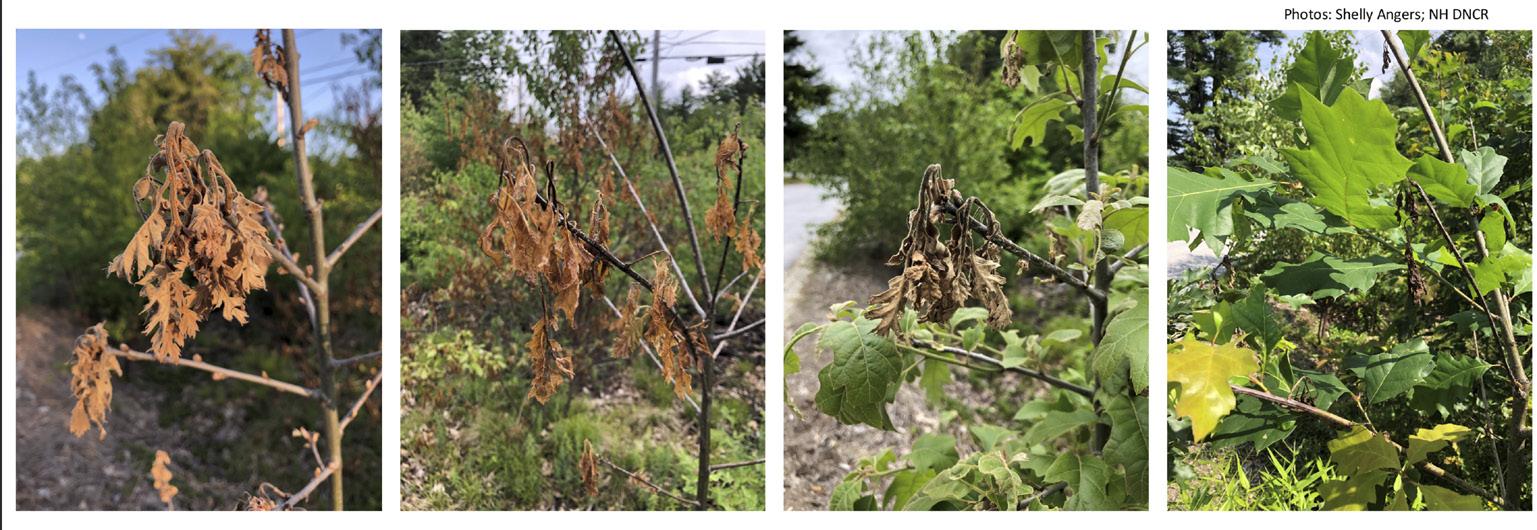
Health Program Coordinator with the NH Division of Forests and Lands, “While HWA populations can grow quickly, really cold temperatures can knock their populations back dramatically. We can see as much as 99% winter kill of HWA when low temperatures reach -20° F, and a little as 40% winter kill when lows only reach around 0° F degrees.”
A series of warm winters from 2019 to 2022 allowed adelgid populations across the state to explode, but last winter offered some reprieve. Although the winter as a whole was not especially cold, a single night reached -15 o F in Concord, which was enough to kill off ~94% of the adelgid population. (Source: 2023 New Hampshire Forest Health Report.)
The cold snap that dispatched many of the HWA in the state had other significant impacts.
Oak and Beech Take a Hit from May 2023 Frost
During the 2023 spring season, you may have noticed dry, shriveled leaves on the oaks and beeches in your area.
On May 18, 2023, we experienced a late spring frost. Some trees (notably beech and red oak) had just begun growing. Their buds had broken open and new leaves had just begun emerging. These leaves were vulnerable to frost, and we saw dieback of these leaves throughout the state. In fact, the NH Division of Forests and Lands Forest Health Program mapped 160,000 acres of damage. Fortunately, most of these trees were able to re-leaf and continue growing, but the event cost them energy reserves to replace those leaves.
Fruit Crops Impacted by Widespread Freeze Events in February and May 2023
According to Jeremy DeLisle, food and agriculture field specialist with UNH Cooperative Extension, “The widespread freeze events in February and May [of 2023] caused the greatest fruit crop loss in over 50 years.” He notes that the freeze
in February (that killed the HWAs) caused losses in peaches, sweet cherries, and plums, while the May frost impacted apple orchards around the state. Many apple trees were in some stage of bloom when the freeze occurred. Based on grower reports and field observations, crop losses ranged from 25 percent to nearly 100 percent. Over 1,000 acres of fruit crops were heavily impacted.
While trees are well-adapted to handle some stressors, as the number of stressors increase, we can see increased mortality. It’s challenging to understand how extremes in weather conditions will stress our forests. While the drought exacerbated the spongy moth infestation and led to red oak mortality, it reduced the fungi responsible for weakening and killing vulnerable white pine trees. And while the extreme cold snap in February 2023 helped to reduce populations of the invasive hemlock woolly adelgid, it also had severe consequences for many of our fruit crops.


Looking at climate predictions, it appears that we may expect higher temperatures, more precipitation, and more extreme precipitation events in the future. Stay tuned for the second part of this article to learn more about how climate changes are expected to influence our fields and forests.
UNH Cooperative Extension natural resources field specialists help people learn about and care for New Hampshire’s forests, trees, wildlife, and habitats. They visit properties free of charge and help you achieve your woodlot objectives—including forestry, recreation, wildlife habitat, water resources, scenic beauty, and income.
Wendy Scribner is a natural resources field specialist with UNH Cooperative Extension. She provides research-based forestry and wildlife assistance to people in Carroll County. Wendy is a licensed forester in both NH and Maine and holds a bachelor’s and master’s degree in forestry from the University of New Hampshire.



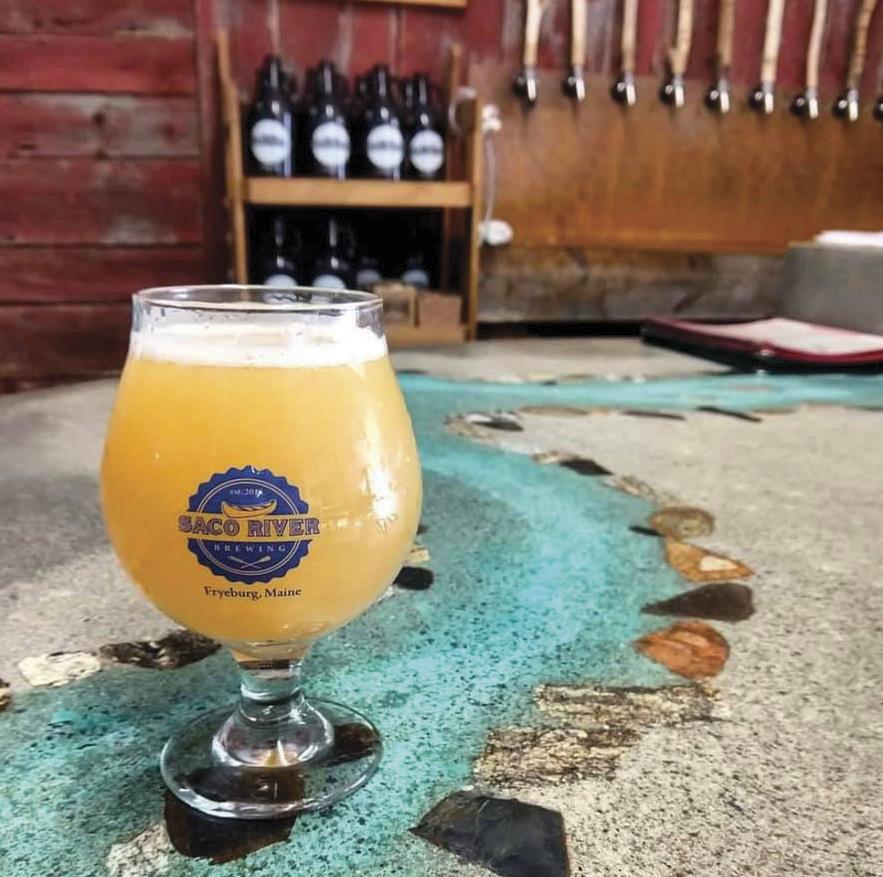

Spring 2024 27
Position yourself for success by partnering with the 2022 & 2021 Realtor® of The Year. Each office is independently owned & operated. tbrealtypartners.com c: 603.986.5286 e: theresa@tbrealtypartners.com o: 603.569.HOME Realtor® in NH & ME THERESA BERNHARDT Enjoy a pint or a flight, and be sure to take some beer to go in growlers or cans! VISIT OUR FRYEBURG TASTING ROOM! VISIT FRYEBURG TASTING ROOM! (207) 256-3028 www.SacoRiverBrewing.com 10 Jockey Cap Lane, Fryeburg, ME Offering a variety of styles focused on high-quality, local brew!
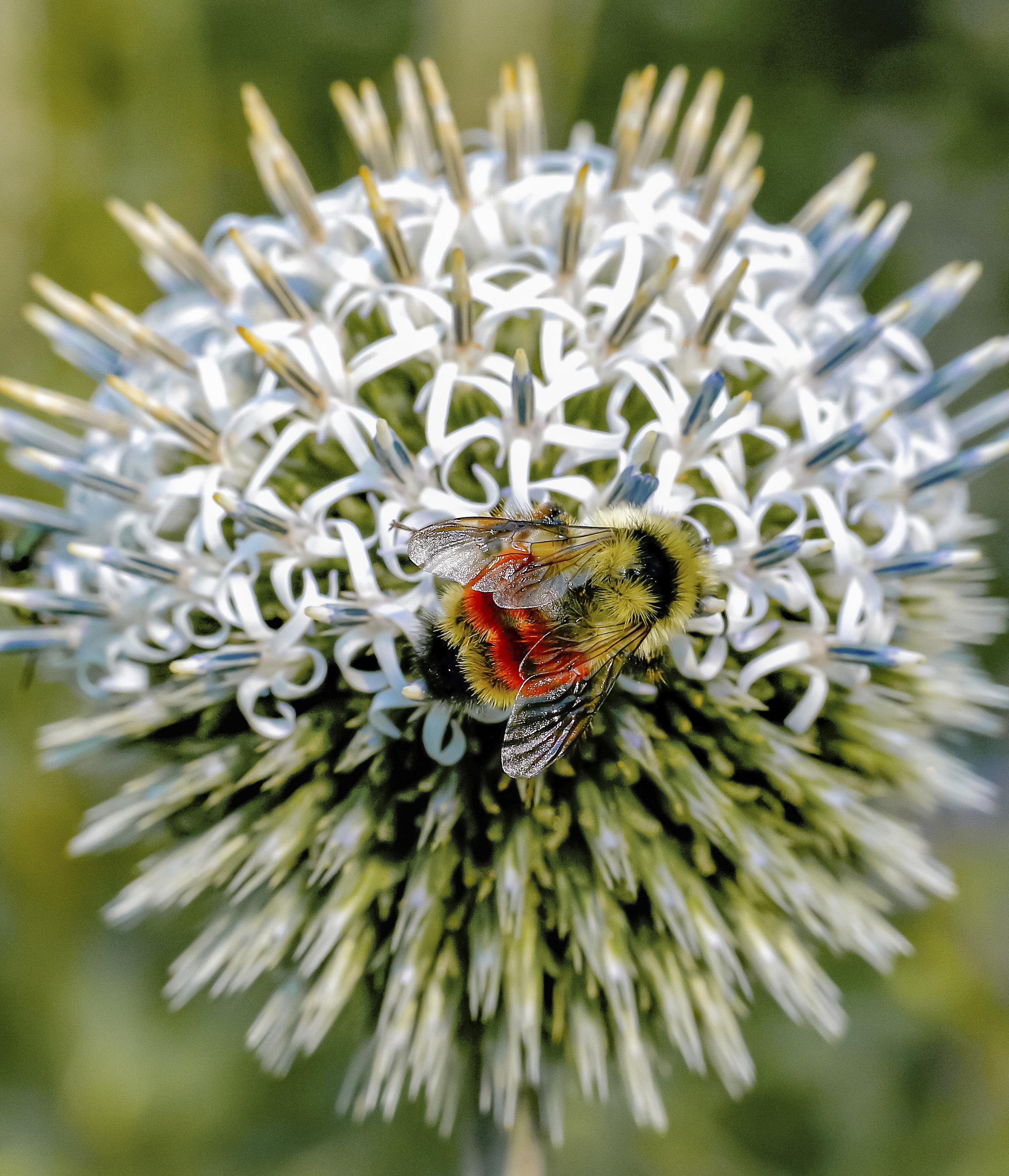 Orange belted bumble bee - Photo by Mike Murphy
Orange belted bumble bee - Photo by Mike Murphy
We all have a role to play in protecting the native pollinators. They are background players working to keep the White Mountain region wild.
Pollinator Ambassadors of the White Mountains
Protecting Benign & Vital Helpers
By Barbara Murphy, Mahoosuc Land Trust
The White Mountains extend from New Hampshire to Maine, encompassing six mountain ranges from the Presidentials to the Carter-Moriah Range to the Mahoosuc Range. Located between Rumford and Bethel, the Mahoosucs are a quick 40-minute drive across Route 2, from Berlin, New Hampshire. Despite being renowned for their natural beauty and recreational opportunities, these areas are also home for many native pollinators, key players in supporting the plants and animals that make the White Mountains so special.
While many know of and support efforts to maintain trails, adhere to Leave No Trace policies, and protect water sources, it’s equally important to invest at home, in our gardens and landscapes, to help combat the decline in many native pollinator populations.
Here are five native pollinators that are easy to identify, fun to watch, and likely to be in your backyard in the White Mountains.
Bumble Bees
If there were ever a contest for “Pollinator Ambassador,” the bumble bee should win. These industrious, hairy, rotund bees are fun to watch—and are fantastic pollinators.
Our native bumble bees are well adapted to pollinate our flowers. The forked hairs on their bodies are good for gathering and carrying pollen, and their use of “buzz pollination” releases otherwise unavailable pollen from flowers. In addition, they are able to fly and forage at lower temperatures and lighter levels than honeybees and other pollinators. They are busy at work in our gardens from April to November.
There are about 50 species of bumble bee in North America. While their biology differs by climate and habitat, generally, their life cycle lasts one year. Each spring, queen bumble bees emerge from their winter nests—abandoned rodent burrows, bunch grasses, even man-made bird
Spring 2024 29
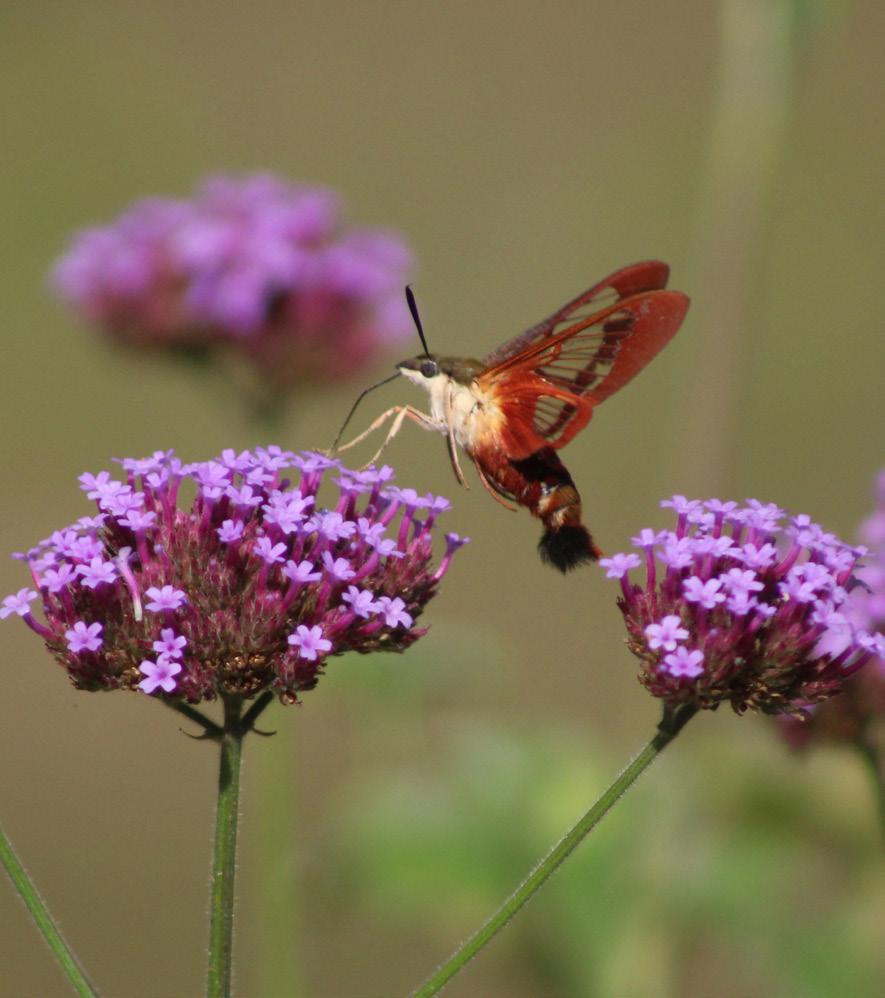

houses—and spend a few weeks feeding and looking for a nest site for that year’s colony. Once found, she will spend the next 30 days gathering food, building waxen pots, and filling them with pollen where she will lay her eggs. Upon hatching, the larvae will mature into female worker bees in four to five weeks and take over the foraging duties for the expanding nest. The bees we typically see in our gardens are these worker bees. Late in the season, the foundress queen and many workers will die off and the newly mated queen will forage to build up fat reserves for the winter, locate a suitable overwintering site, and re-emerge in the spring.
Hummingbird Clearwing Moth
Hummingbird moths are delightful garden visitors. Native to New England, these small, fast moths produce an audible hum and hover while feeding, making them easily mistaken for hummingbirds. Despite their appearance, clearwing moths are inadvertent pollinators, transferring pollen while feeding on nectar from various flowers. In the Northeast, there is one generation per year. At the Habitat for All Garden (HFA), in Bethel, they feed on the nectar of verbena, honeysuckle, and penstemon. Eggs are laid on host plants such as honeysuckle, dogbane, hawthorn, cherries, and plums. Upon hatching, the larvae eat the leaves until fully grown when they drop to the ground, spin a loose cocoon, and pupate, partially protected by leaf litter for the winter.
Golden Digger Wasps
Mention wasps and you are likely regaled with stories of ruined outdoor gatherings, painful stings, and aggressive behavior. Fortunately, not all wasps pose these threats.

into the nest, and lays one egg on the still-living insect that provides food for the soon-to-hatch egg. The young pass the winter underground appearing as adults the following summer. During their short, one- to-two-month time as adults, these striking wasps pollinate our gardens and help control leaf-eating garden pests. This is a wasp we do not need to fear.
Hoverflies
Have you ever heard of a hoverfly? No? You aren’t alone, but we should know about them. Despite their inconspicuous nature, hoverflies are powerful pollinators, second only to bees. Another benefit of these small flies is that their larvae help control garden pests. There are thousands of species of hoverflies. As their name suggests, they hover, much like hummingbirds, while feeding on nectar and pollen. Their distinctive yellow and black color patterns often lead them to be mistaken for bees and wasps. However, unlike bees and wasps, hoverflies have two—not four—wings, and have stubby—not long—antennae. They also don’t sting or bite. What’s not to love?
By acknowledging and nurturing these essential pollinators, we not only safeguard the breathtaking beauty that captivates us in these mountains but also foster sustainable ecosystems for future generations to enjoy.
Native to New England, the large, red-orange and black golden digger wasps are solitary, and non-aggressive. Multiple wasps are found calmly feeding in groups of flowers in our HFA Garden. After mating, the females create nests by excavating five to six vertical tunnels, each with two to three nest cell chambers. The female captures and paralyzes grasshoppers and crickets, drags them
Hoverflies live for about one month. The female lays eggs on plant leaves or stems to give the newly hatched larvae access to food—initially aphids and leaves; later, leafhoppers, white flies, and scale insects. After a week of feeding, the larvae fall to the ground, pupate, and emerge as adults in about two weeks.
Butterflies
Individually, butterflies are not great pollinators. Flitting from flower to flower they pick up small amounts of pollen on their legs, long mouth parts, and bodies. But, the sheer diversity of butterflies (there are 160,000 species of butterflies and moths, collectively known as Lepidoptera) and the significant number of flowers each visits, make them effective pollinators.
All butterflies (and moths) go through a four-stage lifecycle: egg, larva, pupa, and adult. Eggs are laid on the species’ host plant. While some butterflies have specific host plant needs—think monarchs
30 MWVvibe.com
Clearwing moth - Photo by Marta Opie Hoverfly - Photo by Mike Murphy Golden digger wasp - Photo by Julie Reiff

HOW YOU CAN HELP POLLINATORS
• Plant a diversity of flowers, grasses, trees, and shrubs. Look for different shapes and sizes, colors, and bloom times. More is ALWAYS better.
• Make sure to have flowers in bloom in early spring and late fall when pollinators need the energy, and many native plants are not in bloom.
• Don’t use pesticides on your lawn or garden.
• The larvae of butterflies and moths eat the leaves of our plants. See this as a sign of a healthy landscape and have tolerance for some level of damage.
• Use a gentle touch during fall clean-up. Many pollinators overwinter in leaves and plant debris, especially around trees and shrubs.
• As an extra challenge, try to keep the leaves in place until five fifty-degree days have passed. This gives the overwintering insects time to emerge from their winter homes.
• Remember, over 95 percent of insects are benign or helpful.
and milkweeds—others lay eggs on a wide assortment of trees, shrubs, and flowers. Each egg hatches a tiny, soft-bodied caterpillar that eats foliage and grows to many times the size of the original caterpillar before forming a pupa or chrysalis, the resting stage before emerging as an adult butterfly, a flying jewel in the garden.
We all have a role to play in protecting the native pollinators. They are background players working to keep the White Mountain region wild. By acknowledging and nurturing these essential pollinators, we not only safeguard the breathtaking beauty that captivates us in these mountains but also foster sustainable ecosystems for future generations to enjoy.
About Mahoosuc Land Trust
Established in 1989, Mahoosuc Land Trust has preserved 25,000 acres in the region, offering unparalleled access to open and wild spaces. Featuring 80+ miles of trails, four boat launches, and the Habitat for All Garden, we prioritize free recreational and educational opportunities for all, aiming to inspire the next generation of conservationists. To learn more, visit www.mahoosuc.org.
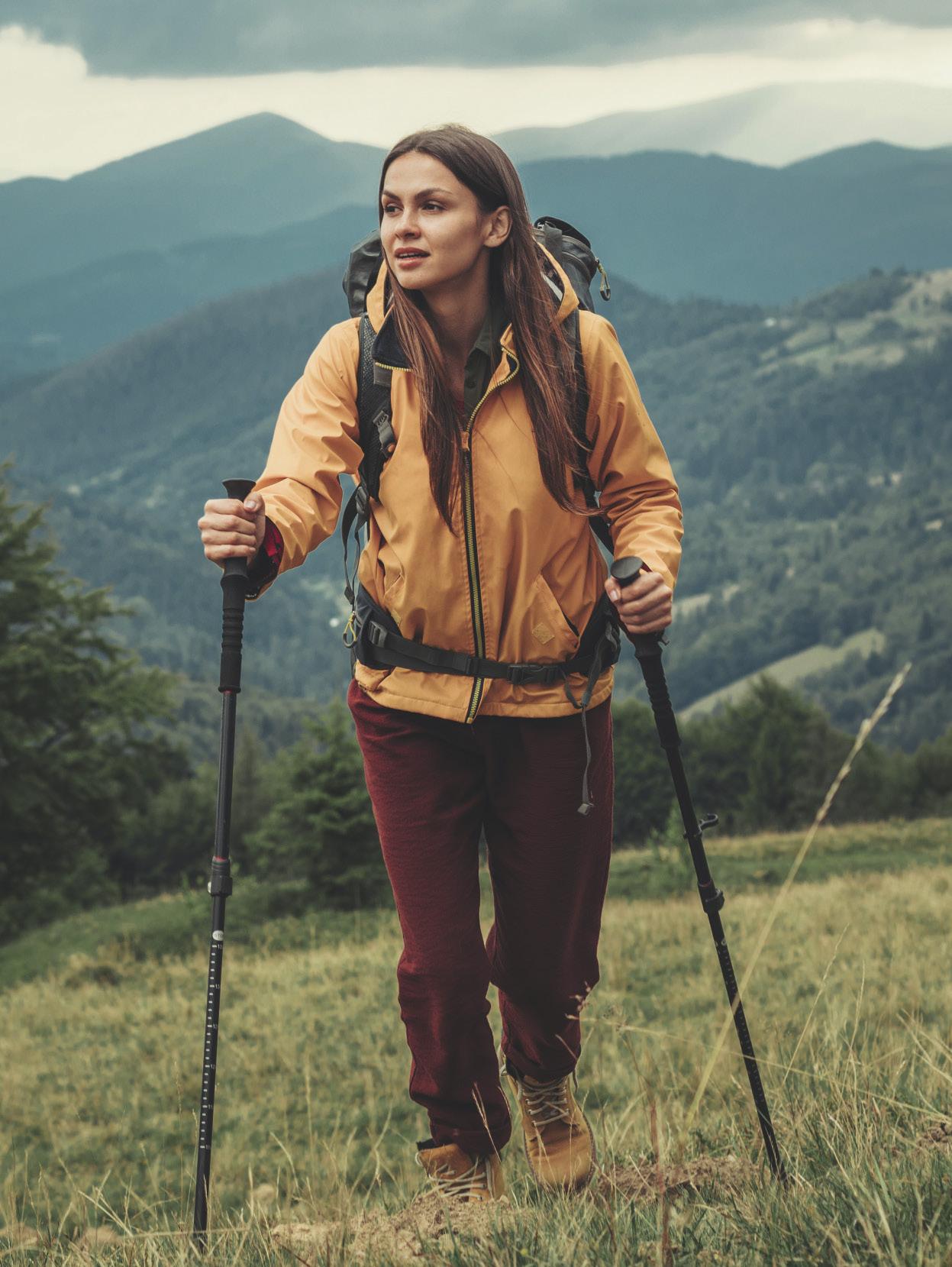
Spring 2024 31
Conquering the outdoors starts with quality gear from the industry’s best brands at Settlers Green, located at the foothills of the White Mountains. Start
settlersgreen.com/outdoors.
nature Reach your peak with the hottest outdoor brands settlersgreen.com | 888-667-9636
planning today at
Force of
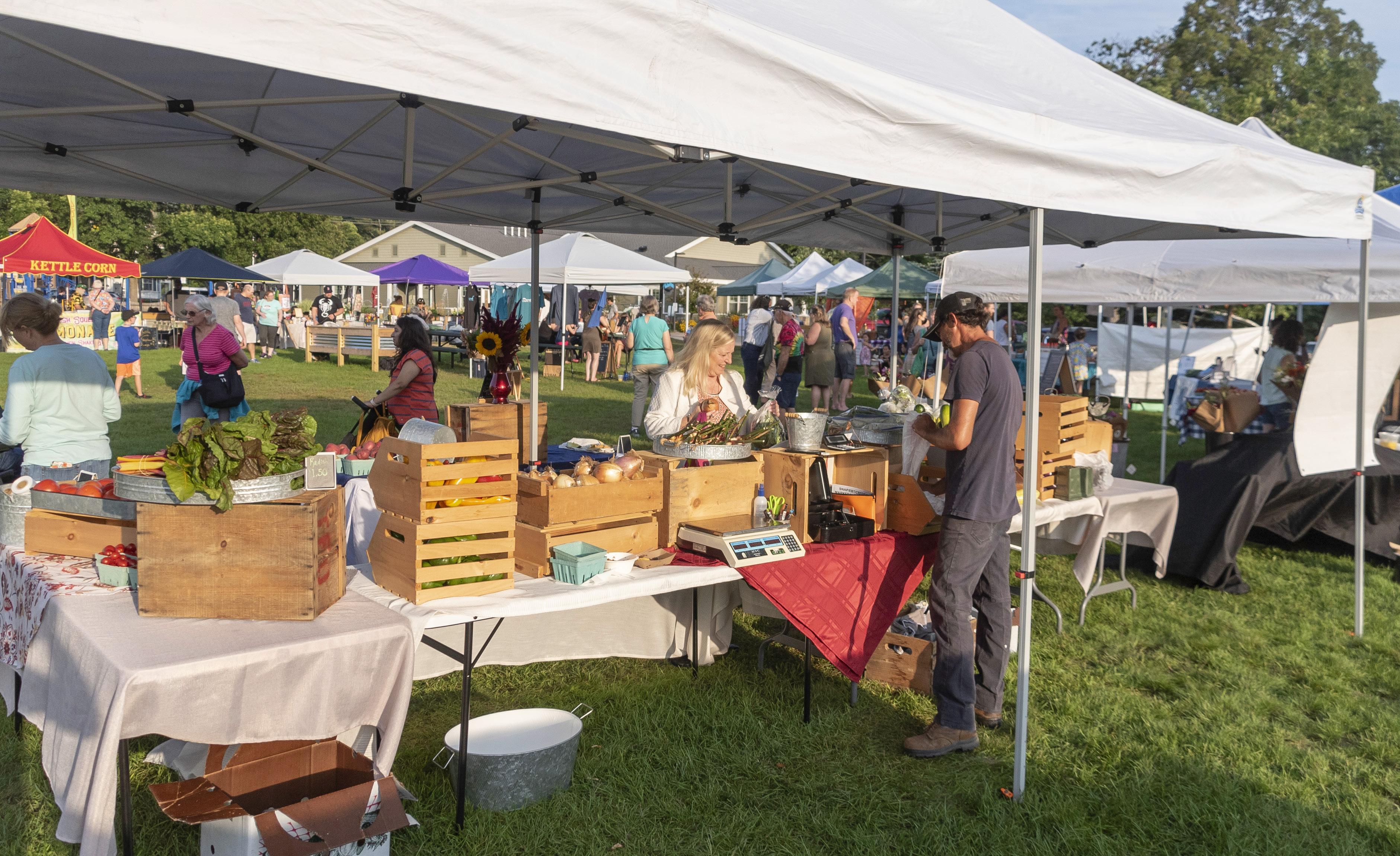 By Lea Camille Smith
By Lea Camille Smith
An Ode to the Mount Washington Valley Farmers’ Market
The MWV Farmers’ Market started in 2020 with the intention of providing the community with nourishing food and a place to gather and celebrate what the Valley has to offer.
Enjoying local produce and products has never been easier, thanks to options like the Mount Washington Valley Farmers’ Market. Meg Willis, market manager, gave us the details for the upcoming market offerings.

The MWV Farmers’ Market will enter their fourth year with a generous grant from The Grassroots Fund, which provides the market with resources to continue growing and innovating the market experience, while making it accessible to all. This coming season, the MWV Farmers’ Market will have a theme for each week, with special activities, deals, and partnerships with local businesses.
The MWV Farmers’ Market will enter their fourth year with a generous grant from The Grassroots Fund, which provides the market with resources to continue growing and innovating the market experience, while making it accessible to all.
The MWV Farmers’ Market started in 2020 when farmers and community members identified a need for a connection between local food and consumers in the Valley. The market was born with the intention of providing the community with nourishing food and a place to gather and celebrate what the Valley has to offer.
The MWV Farmers’ Market brings together purveyors of local products such as produce, fresh bread, honey, alcohol, and handmade crafts. Shoppers can stock their pantries, grab dinner at one of the two onsite food trucks, enjoy the outdoors, and connect with community members all in one place. Each week, the market features a different local nonprofit, providing organizations with a place to get their message out and bridge the gap between community resources and locals. Yoga teachers lead outdoor yoga classes for market-goers to stretch and unwind, and massage therapists and bodyworkers provide demos of their services.
The MWV Farmers’ Market believes in food equity for all, and offers market tokens, which can be purchased with SNAP/EBT dollars. Thanks to a partnership with Granite State Market Match, each market token value will double. Every $1 of SNAP/ EBT redeemed provides shoppers with an extra $1 to be spent on fruits and vegetables at the market.
Why Shop at Farmers’ Markets?
Farmers’ markets are not only convenient, they’re also an important part of local communities. Buying from your farmers’ market is one way to give back to your community and support the environment. Many local businesses, such as restaurants and specialty shops, buy from farmers at farmers’ markets. This system keeps local businesses afloat as agribusiness continues
32 MWVvibe.com

to overtake the production of food. Buying local food is directly investing in your community for years to come. Spending money in your community is often money that stays in your community.
As well, shopping at farmers’ markets contributes to the protection of the natural world. Between unethical farming practices, packaging, and transportation, the environmental footprint of groceries is ever-growing and detrimental. Reducing the length of travel from farm to consumer is one way that farmers’ markets help to minimize the negative impacts of shipping and packaging. Farmers and purveyors often drive
Between unethical farming practices, packaging, and transportation, the environmental footprint of groceries is ever-growing and detrimental. Reducing the length of travel from farm to consumer is one way that farmers’ markets help to minimize the negative impacts of shipping and packaging.
less than a few hours to the market, and many market-goers walk or bike. Shoppers are encouraged to bring their own bags or baskets for produce while most vendors are environmentally savvy, often putting other products in glass jars or paper bags when necessary.
Many local farmers use organic or no spray/low spray farming practices, compost, amend their soils, and rotate


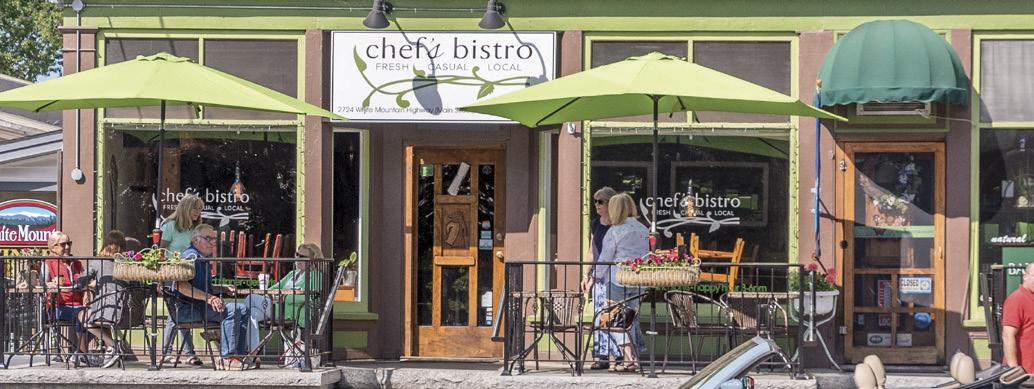



Spring 2024 33
(603) 356-4747 • ChefsBistroNH.com 2724 White Mountain Hwy, No. Conway Village, NH Please check for our latest spring hours! Located on main street in the heart of North Conway village, we are your neighborhood restaurant serving up fresh, local and delicious food in a warm and friendly atmosphere. LOCAL, FRESH, AND FUN FOR EVERYONE!
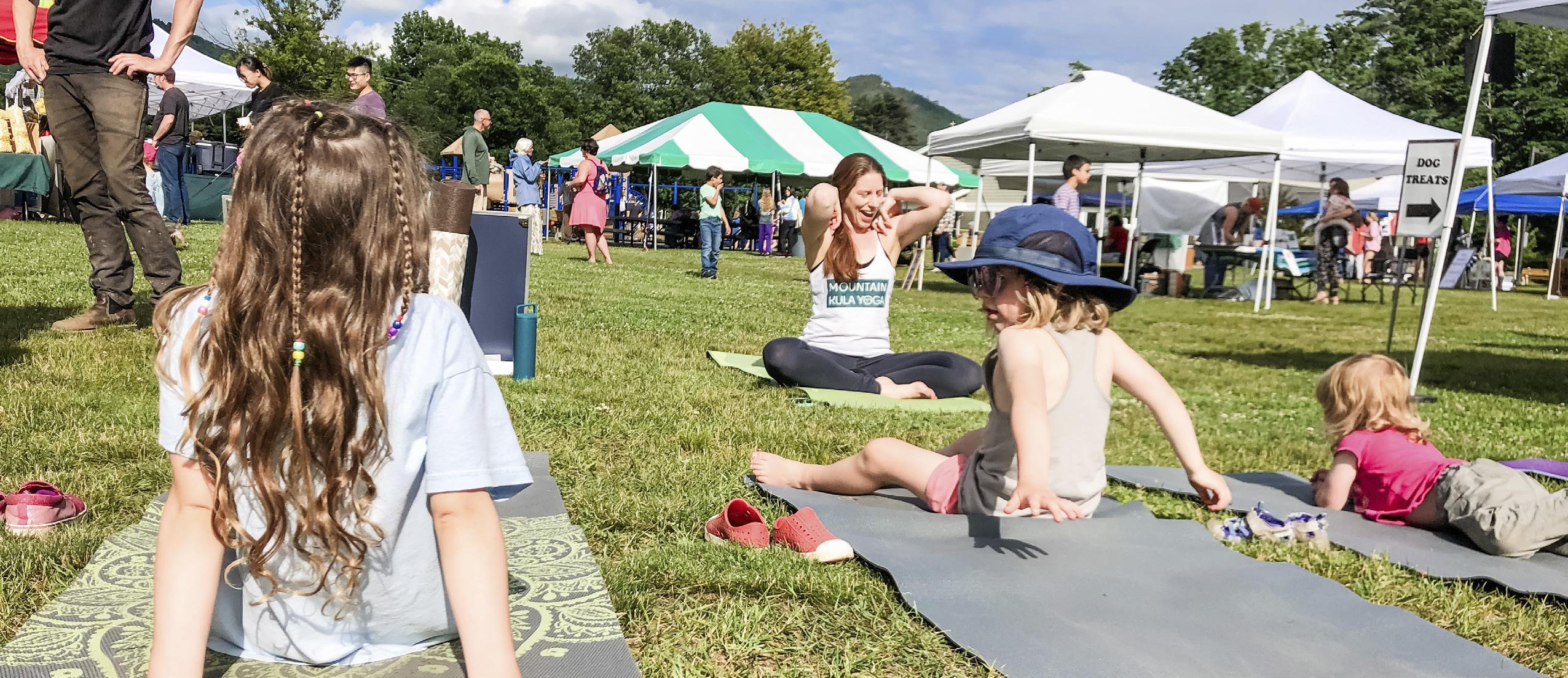
crops each year to attain and maintain soil diversity. Local farms have a much smaller footprint than large-scale conventional farms and are more connected to the needs of their communities. Produce bought at farmers’ markets is usually picked the day of the market to provide shoppers with peak nutritional value and taste. Fresh produce keeps longer, leading to less food waste. Many farms will compost unsold food, which enriches the soil and contributes to future growing seasons. By reducing
Produce bought at farmers’ markets is usually picked the day of the market to provide shoppers with peak nutritional value and taste. Fresh produce keeps longer, leading to less food waste.
food waste, ethically disposing of food, and reducing packaging, many farmers are reducing their contributions to landfills.
Farmers’ markets are community hubs where locals and visitors can connect with each other and with their farmers to learn where their food comes from. Often, purveyors will provide the shopper with information on preparing their products, giving market-goers a chance to learn new skills with less familiar products. Knowing where your food comes from and how to prepare it are great steps toward taking charge of your health.
The well-being of the Valley is important; it’s a place for work and play. By supporting farmers’ markets, which feature ethical farming, community members reduce contributions to growing practices that directly contaminate soils and waterways. By buying locally, you can do your part for the environment while supporting your health. Plus, by shopping at your local farmers’ market, you can continue enjoying the beautiful outdoors of the Mt. Washington Valley, never stepping foot inside.
Market Information
The Mount Washington Valley Farmers’ Market takes place beside the North Conway Community Center, every Tuesday from 4 to 7 p.m., from June 18 through October 1. Following Labor Day, hours will change to 3 to 6 p.m. to accommodate decreasing daylight.
Need help paying for groceries? SNAP can help.

Food assistance resources such as the Supplemental Nutrition Assistance Program (SNAP) exist to reduce food insecurity.
In Carroll County, one out of every 13 residents reports that, at times, they don’t have access to enough food to live an active, healthy life, according to Feeding America’s 2023 Map the Meal Gap study.
Nearly 18 percent of Carroll County residents who are eligible for SNAP have not applied for benefits. Why? Many report that they don’t think they’re eligible, according to the 2023 Carroll County Food Access Needs Assessment. There are many factors that determine SNAP eligibility, including income, expenses, resources, and more. You won’t know if you’re eligible until you apply!
Additionally, SNAP income eligibility limits increased in 2023, meaning even more people are eligible for benefits. Residents who weren’t eligible for SNAP benefits previously may be eligible now.
To learn more and apply for SNAP, visit: www.dhhs.nh.gov/snap
Need help with the application process? Call the NH Food Bank for application assistance at 1-877-347-SNAP (7627).
Want to get involved with the Mount Washington Valley Farmers’ Market? Join the board to share your innovative ideas and help keep the market running with tasks such as policy-making and day-to-day management.
To access the market’s mission, join the board and get involved, or inquire about vendor applications, head to their website, www.mwvfarmersmarket.com, or contact mwvfarmersmarket@gmail.com for more information.
34 MWVvibe.com




Spring 2024 35 Almost There Sports Tavern & Restaurant (603) 447-2325 • AlmostThereNH.com 1287 Route 16, Albany, NH Just south of the Kancamagus Highway (Route 112) Where Life is Good! OPEN DAILY (EXCEPT WEDNESDAYS) FROM 11:30AM
MWV Farmers’ Markets
A - Bridgton Farmers’ Market
Every Sat 8am-Noon, May-October 151 Main Street, Bridgton, ME www.facebook.com/BridgtonFarmersMarket Bridgtonfarmersmarket.me@gmail.com
B - Gorham Farmers’ Market
Every Thurs 3-6pm, June 8-October 5 69 Main Street, Gorham, NH (603) 466-2101 • www.gorhamnh.org


Community supported agriculture A
CSAs are a relationship between a grower and an eater in which the eater invests early to help with the start-up costs of a new growing season. This investment is paid back throughout the year with weekly shares of the farm’s harvest.
For additional information at www.mwveg.com/csa.
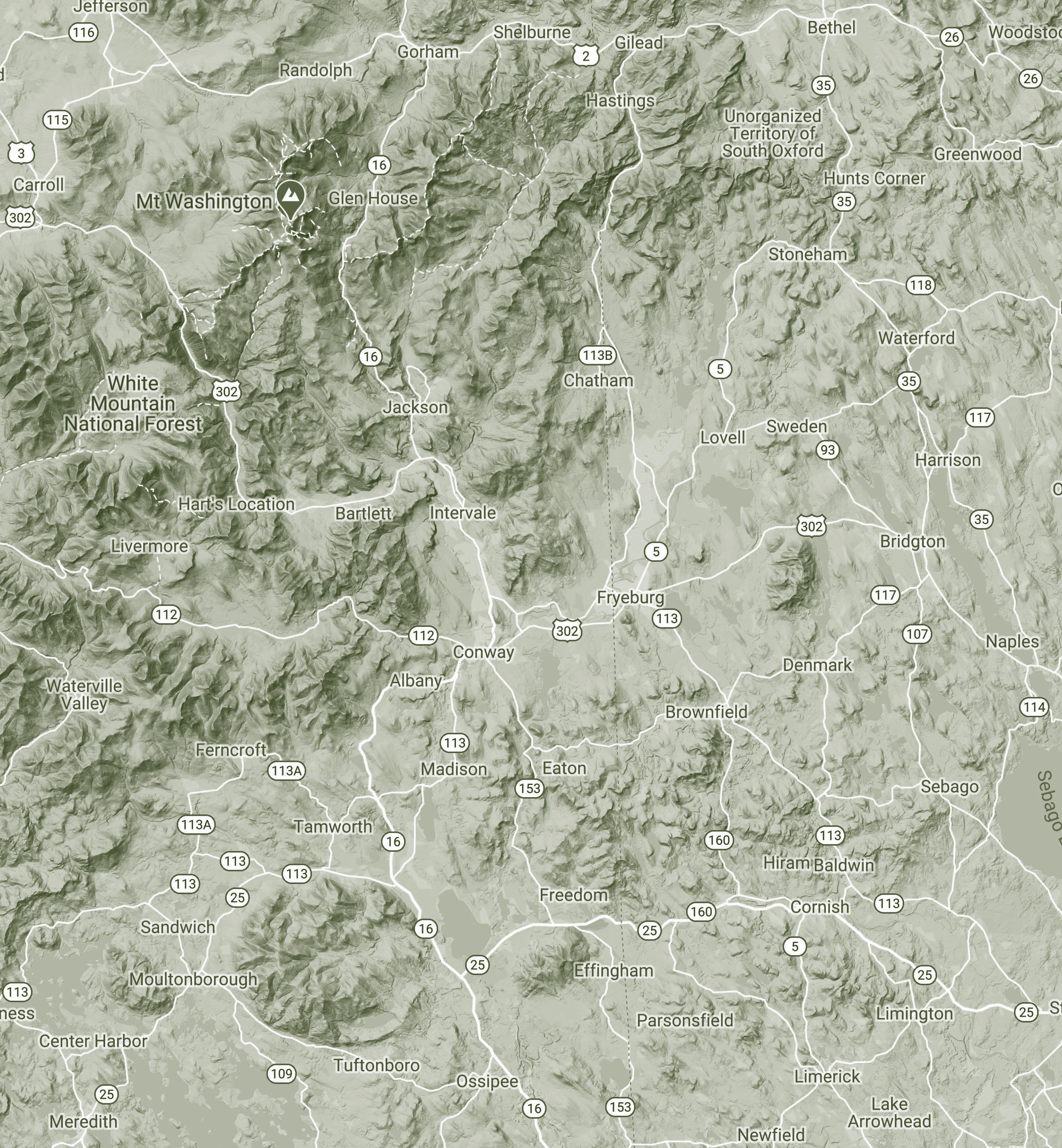
Visit www.mwveg.com for an updated list and dates.
C - Lovell Farmers’ Market
Every Sat, 10am-3pm, year-round 993 Main Street in Center Lovell, ME www.mwveg.com/markets
D - MWV Farmers’ Market
Every Tues 4-7pm, June 18-October 1 78 Norcross Circle, North Conway, NH www.mwvfarmersmarket.org
E - Tamworth Farmers’ Market
Every Sat 9am-Noon, May-October 28 30 Tamworth Road, Tamworth, NH www.tamworthfarmersmarket.org
F - Wolfeboro Farmers’ Market
Every Thursday, Noon-3:30pm, May-October 10 Trotting Track Road, Route 28, Wolfeboro, NH www.wolfeborofarmersmarket.com
Please note that MWV Vibe has created this list with the help of MWVEG. Some farms or markets listed may not be actual members of MWVEG, and therefore, may not be found on the MWVEG website. Please contact MWV Vibe with corrections and/or suggestions.
36 MWVvibe.com AN AG DO RM C B F A D E AB AT ZM BK BK BL DV DR EF FA FM GA GV HO HI HF DN LP MF MB MV MO OW MN MH TR ML SO SC NH PF PH RG SH SF SB MV TO SP TU WF SU TF TH WM WG WE AA AF DR DR GB LH MB WP CH HW WH

MWV Farms

Mt. Washington Valley
AN A New Day Farm Conway, NH
AB Abundant Blessings Brookfield, NH
AA Apple Acres Farm Hiram, ME
AF Avella Farm Hiram, ME
AG Again & Again Farmstead Tamworth, NH
AT Athena’s Bees Apiary Ossipee, NH
BK Berry Knoll Eaton, NH
BF Bly Farm Wolfeboro, NH
CH Chase Hill Farm* Albany, NH
DN Davis Natural Produce Eaton, NH
DO Densmore Orchard Conway, NH
DV DeVylder Farm Wolfeboro, NH
EF Earle Family Farm Conway, NH
FA Fly Away Farm* Stow, ME
FM Full Moon Farm Wolfeboro, NH
GA Gould Acres Farm Stowe, ME
GB Good Buddy Farm E. Hiram, ME
GV Grand View Farm* Conway, NH
HO Hatches’ Orchard* Conway, NH
HI Highwater Farm* Bartlett, NH
HF Hosac Farm Cornish, ME
HW Howlin’ Winds Farm Fryeburg, ME
LH Lily Hill Farm Tamworth, NH
LP Loon’s Point Honey Bees Madison, NH
MF Meadowfall Farm & Forage Porter, ME
MB Merrybrook Farm Tamworth, NH
MV MiVida Gardens Madison, NH
MO Moonset Farm & Floral Porter, ME
MB Mountain Breeze Farm Sandwich, NH
MN Mountain Flower Farm Intervale, NH
MH Mountain Heartbeet Farm Effingham, NH
ML Mountain Laurel Farm Sanbornville, NH
NH NH Mushroom Company* Tamworth, NH
OW Old Wells Farm Limington, ME
PF Patch Farm Denmark, ME
PH Pork Hill Farm Ossipee, NH
RG Red Gables Farm Tamworth, NH
RM Remick Museum & Farm Tamworth, NH
SH Sap Hound Maple Co. Brownfield, ME
SC Schartner Farm North Conway, NH
SF Sherman Farm Conway, NH
SB Snow Brook Farm Eaton, NH
SU Sumner Brook Fish Farm Ossipee, NH
SO The S.o.L Farm No. Conway, NH
SW Spider Web Gardens Tuftonboro, NH
TF The Farmstand Tamworth, NH
TH Thompson House Farm Stand Jackson, NH
TR The Farm by the River Effingham, NH
TO Top of the Hill Farm Wolfeboro, NH
TU Tumbledown Farms Brookfield, NH
WH Walker Hill Farm Stand Fryeburg, ME
WM Waxing Moon Gardens* No. Sandwich, NH
WE Weston’s Farm* Fryeburg, ME
WG White Gates Farm Tamworth, NH
WA White Mountain Apiary Whitefield, NH
WP Whispering Pines Farm Effingham Falls, NH
ZM Zero Mile Farm South Tamworth, NH




37
* Farms that offered wholesale in 2023 Visit www.mwveg.com for a searchable database of farms and local food in the
region.
WHITE MOUNTAIN INDEPENDENTS WhiteMountainIndependents.com Shop Small • Shop Indie Local Shop the Blue Flags! Visit us or shop online! THE WHITE MOUNTAIN INDEPENDENTS Gift-giving made easy! Gift certificates can be redeemed at any of our 20+ member retailers! Purchase certificates in increments of $25 online! • Assets Jean Company • Atlantic Pool & Spa • Bavarian Chocolate Haus • Cathedral Ledge Distillery • The Christmas Loft • Designed Gardens Flower Studio • Discount Beverages • Four Your Paws Only • It’s My Girlfriend’s Boutique Consignment • Jewelry by Tim & Friends • League of NH Craftsmen • The Local Grocer • North Conway Olive Oil Co. • North Country Fair Jewelers • The Penguin Gallery • Poppy & Vale • Ragged Mountain Equipment • RavenWood Curio Shoppe • The Root Cellar: an Aveda Salon & Boutique • The Rugged Mill • Soyfire Candle Bath & Body • Spruce Hurricane • Valley Artisans & Vintage Market • Veno’s Specialty Foods & Meats • White Birch Books • White Mountain Winery
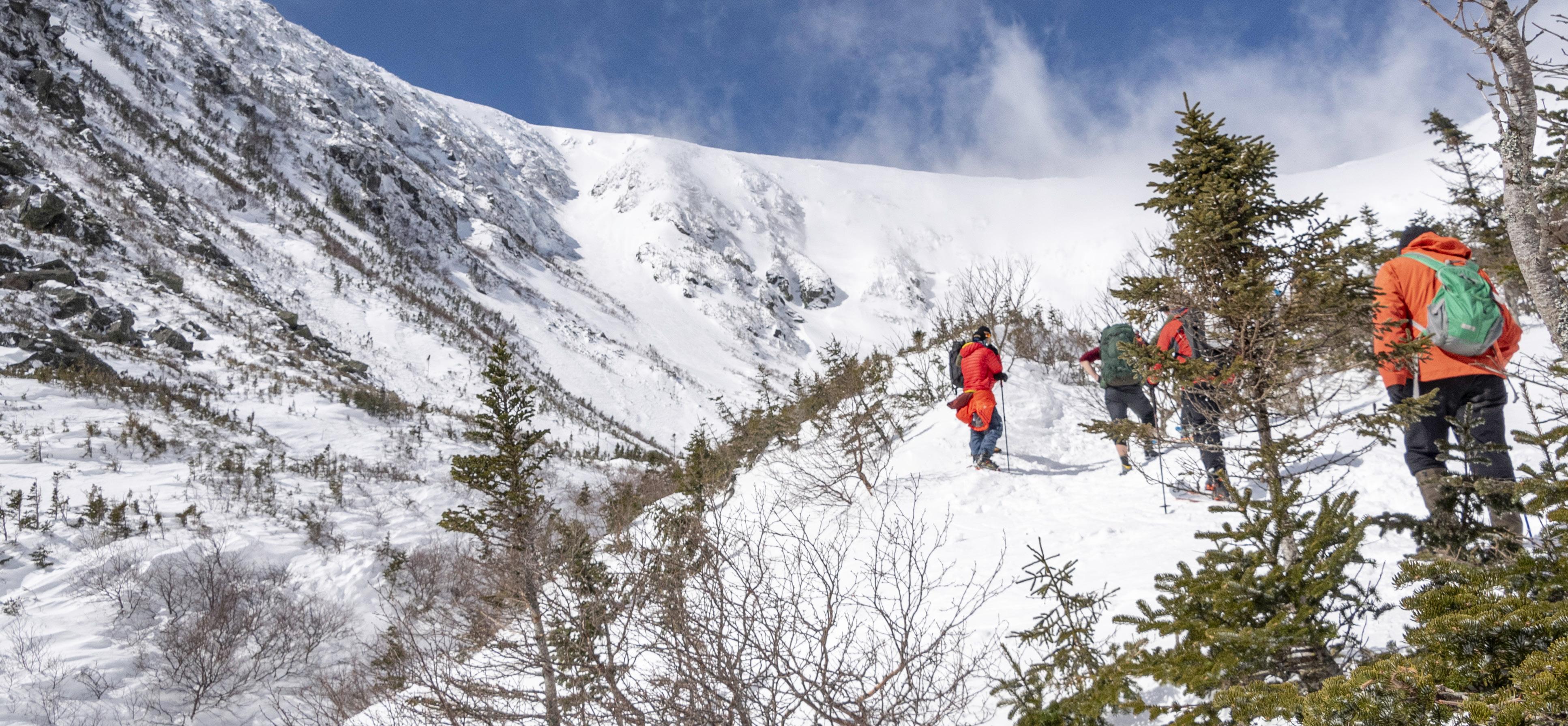
Spring Layering Essentials Before Hitting the Trail TUCKERMAN-READY
There’s no better time for outdoor enthusiasts to ascend one of the most famous routes in the Whites: Tuckerman Ravine. By springtime, the snowpack is more stable, the weather is (hopefully) more conducive to using your fingers and toes, and the skiing can be prime.
Whether you’re skinning up to the ravine or hiking down low in the valleys, springtime in the White Mountains can be warm, sunny, and green one moment and chilly, windy, with white-out conditions the next. While spring skiing and hiking in the Whites can be so rewarding, being prepared for inconsistent weather conditions is essential. Properly identifying versatility with layering can be the difference between a good and bad day on the mountain.
Luckily, here in the Valley, we have experts who can keep us outfitted with the right clothes and wise advice on what we will need where and when. Ragged Mountain Equipment in Intervale, an institution in the outdoor gear realm since their doors opened in 1985, is known for providing both. Rob Nadler’s Ragged Mountain team of Mt. Washington Valley locals has helped create the layers we love and use today by partnering with Polartec™ on Washington-tested Windbloc™ and Power Stretch™ fabrics. Each piece is hand-stitched, from start to finish, by one rugged stitcher to give the outdoor community the quality it craves. Here are a few of our tested-and-true picks from Ragged Mountain—and why we love them.
Stretch Grid Hoody
Start from the skin: you need good layers to keep you warm on cool, windy days, such as the Stretch Grid Hoody. Whether you wear this over a thinner base layer or as your only base layer, the Stretch Grid Hoody utilizes Polartec™ Power Stretch™ fabric to wick away sweat and keep you thermo-regulated. The microgrid inner layer allows for breathability (and comfort with its wicked softness), while the exterior provides abrasion resistance and
LAYERING
By Josette Deschambeault
quick-drying capabilities. This hoody gives you lightweight, full-coverage stretch that can be worn as a standalone layer while trekking uphill, or snug underneath another warm layer as you’re slashing turns back down the ravine.

What we love about the Stretch Grid Hoody are the little details: the deep chest zipper for bonus ventilation, thumbholes for wrist coverage, and the three-paneled hood that replaces the need to pack an extra hat. These details make this layer versatile, which is what an outdoor go-getter in the Mt. Washington Valley needs in spring weather: the deep zipper allows you to zip up tight when the wind picks up, but let the breeze in when the sun pops out and you’re working up a sweat. The thumbholes also allow for zero bunching under other layers, keeps the sun and wind off of the tops of your hands, and seamlessly integrates with gloves to keep snow from climbing up your arms. Saving space and weight in your pack speaks for itself when you can leave more hats at home and pack an extra summit snack.
Saco Sun Hoody
Sun is no joke when it comes to spring skiing. “The worst sunburn I’ve seen in my life was from spring skiing,” said Cort Hansen from Ragged Mountain Equipment. “I helped rescue a man after he took off his boots and socks during lunch, and he couldn’t make it back down the trail that afternoon due to the burns on his feet!” Wearing a sun hoody as a base layer covers two useful bases—it wicks away moisture, keeping you drier and better thermoregulated, and protects you from the sun’s UV rays.
38 MWVvibe.com

Ragged Mountain Equipment’s Saco Sun Hoody sports UPF 50 material blocks out a whopping 98% of harmful UVA and UVB rays. The hood shields your neck, scalp, and ears when pulled overhead, while thumbholes help protect your wrists and hands from the sun, as well. (We still highly recommend wearing sunscreen anywhere that could be exposed to the sun, such as your hands, neck, face, and ears.) This sun hoody is light enough to be worn on the warmest spring skiing days, or even in the middle of a summer hike to protect your skin.
Mountain Stretch Jacket
If we could recommend just one warm top layer, this would be the one. Ragged Mountain’s Mountain Stretch Jacket was designed for folks who like to linger outdoors, no matter how dramatically the weather turns. No wonder mountain guides wear it everywhere from the trailhead to the summit and back down at the pub. They used Polartec® Power Stretch® fabric for this layer, which utilizes four-way stretch, along with a wicked soft interior and no-pill exterior. This means that wherever you scrape, bump, or scratch against, your jacket will stay tough and warm.

What we appreciate the most about this jacket, apart from its overall warmth and durability, are the details in the design that will keep you protected in harsh White Mountain conditions. The full-length zipper is backed with fleece up and over your chin, so you won’t lose warmth from the zipper and the plastic zipper won’t irritate your face and neck. A fitted hood keeps both your head and your neck protected from wind and cold, and also fits well under a ski helmet. Keep your phone or avalanche beacon warm and close with an easily accessed and zippered chest pocket. The thumbholes aid you in layering without wrinkling your layers, and sealing your layers from wind and moisture when you’re putting on your gloves. But the most ingenious aspect of this layer comes from the elastic under-harness strap that keeps this jacket from creeping up when you’re climbing. If you prefer not to rock the strap, it is removable, but we’ve found it works well to keep your jacket from sliding upwards underneath ski bibs, too.
Talus Pants
Softshell pants are an amazing addition to your spring skiing gear collection; be sure to find a pair that breathes just as well as it re pels water. Ragged Mountain’s Talus Pants use a 90% nylon/10% Spandex blend to give you quick-drying, abrasion-resistant pants that are just thick enough to insulate, but a wool or fleece base layer isn’t a bad idea for colder days. These pants help block both moisture and wind while you’re at the top of the Head Wall, so you can cross hypothermia off your list of worries. Worried about
being too warm, though? Ankle zippers allow for aeration, as well as easy on and off with boots strapped to your feet. These pants also feature three zippered pockets, so your valuables and snacks are secure: two on the sides and one on the back. They’re also good for holding onto your car keys and debit card when you’re jaunting around town aprés ski.

Why choose softshell pants over hardshell pants? Spring weather usually brings warmth, even though snow still abounds. Softshell pants allow for more airflow, or breathability, which means your sweat and excess body heat have more of a chance to escape, keeping you drier and ultimately more comfortable. Hardshell materials (like most rain shells) are waterproof and don’t allow for air to move as well, which helps retain heat, but keeps moisture locked in closer to your body. These materials are good for a blizzard or a downpour, but not so much for warming weather.
Whatever trail your springtime adventures bring you, preparing before you go is key. While you can find almost everything you need at Ragged Mountain, the Mt. Washington Valley holds many fine outdoor shops offering all-season gear, such as International Mountain Equipment, Sun & Ski, Eastern Mountain Sports, and REI.






Spring 2024 39
DISCOVE DVENTURE 11 BOULDER CAVES LOSTRIVERGORGE.COM 603.745.8031 OPEN MAY - OCTOBER 1712 LOST RIVER ROAD NORTH WOODSTOCK, NH GORGE-OUS NATURAL BEAUTY! 1-MILE BOARDWALK TRAIL. Scan to book now!
28 Little-Known Facts
About Tuckerman Ravine & the Mount Washington area

Since the late 1800s, thousands have made the trek up to the Tuckerman Ravine area on Mount Washington. The gullies, chutes, and snowfields on the eastern flank are hallowed ground, a sanctuary of steep, where legends are born and history made. The mystery and enticement of the region have created enough history to fill the many books written throughout the years. We have gathered togther some of the most notable facts, and dug a bit deeper to find a few lesser-known tidbits that otherwise may be lost in time. Please let us know about potential corrections or if you have some of your own information to share. Enjoy!
1 Tuckerman Ravine is actually a glacial cirque (from the Latin word circus), which is an amphitheater-like valley formed by glacial erosion. Sloping eastward on the southeast face of Mount Washington, an enormous amount of snow (at times reaching 40-50 feet deep) is carried from the west side of the mountain to the east side, filling the major ravines, notably Tuckerman and Huntington ravines. Geologists actually recognize 13 glacial cirques in the Presidential Range.
2 There is evidence that a local glacier existed in the Great Gulf, north of Tuckerman Ravine, after the meltdown of the last continental ice sheet.
3 Tuckerman Ravine is named after botanist Edward Tuckerman, who studied alpine plants and lichens during the summers from 1837 to 1853. Tuckerman’s name was linked to the ravine around 1848, when artist Godfrey Frankenstein produced a painting titled, Mount Washington, Over Tuckerman’s Ravine.
4 Naturalist Henry David Thoreau visited Tuckerman Ravine in 1858, and sprained his ankle slipping from the infamous snow arch, an annual remnant of melting deep winter snowfileds. Thoreau suffered intense embarrassment when his guide started a small forest fire that swept the floor of the ravine.
5 The summit of Washington was home to a daily newspaper named Among the Clouds, which existed from 1885-1917.
6 The first person to ski on Mount Washington was Dr. Wiskott from Breslau, Germany, in 1899. The first known ascent on skis came in 1913, when three members of a large party of the newly formed Dartmouth Outing Club (DOC) skied all the way up the carriage road. DOC skiers would go on to pioneer new ski routes on Mount Washington for the next 35 years.
7 The first person to ski Tuckerman is believed to be John S. Apperson of Schenectady, New York. Apperson was an accomplished climber, skier, and environmentalist from the Adirondack Mountains who visited the ravine in March of 1914.
8 The road through Pinkham Notch was first plowed in 1928, allowing skiers to reach the trail to the ravine without first traveling the 9 miles from Jackson or Gorham.
9 Forester Henry Ives Baldwin was among the first to publicize Tuckerman Ravine as a spring skiing destination when he wrote an article about a June 1926 trip in an AMC journal. The snow that winter would not completely melt away before the first snowfalls of the winter of 1927 arrived, a phenomenon not observed since then.
10 In 1931, Dartmouth skiers, John Carleton and Charley Proctor, who skied for the U.S. in the winter Olympics, were the first to ski the headwall. They climbed up the route, now
40 MWVvibe.com
called the Lip, to the top of the headwall, and then making jump turns in breakable crust, skied down over the 45-degree snow wall. Carleton fell high up on the run but recovered, while Proctor stayed upright for the entire run. They returned for a second run that same day.
11 A week later, Harvard skiers Robert Livermore, Brad Trafford, and Robert Balch, became the first to ski from the summit of Washington down over the headwall. This group and others would go on to found the Hochgebirge Ski Club of Franconia, the oldest continuously operating downhill ski club in the United States.
12 Tradition says a woman named Mary Bird is likely the first woman to ski over the headwall in 1936. Bird was one of the best female racers of the day, who had learned to ski from Hannes Schneider’s ski school in St. Anton, and who was the first American woman ski instructor.
13 On April 16, 1933, the first Inferno was run from the summit down Right Gully through the ravine and down the hiking trail to Pinkham Notch. Hollis Philips won with a time of 14:41.3.
14 The second Inferno was held in 1934, with young racing sensation Dick Durrance, who had learned to ski in Europe, the winner in 12:35.0. This time, the race entered the ravine over the precipitous Lip of the Headwall. Durrance, like most of the racers in 1933, had never skied the Headwall before the race.
15 On April 4, 1937, the first giant slolom race in the U.S., the Franklin Edson Memorial Race, was held. Intended to begin at the summit, the race began halfway up Right Gully as two recent surface avalanches hinted to potential trouble on the headwall. This race has been well-documented, thanks to the infamous photograph by Harold Orne (photo next page).
16 The interest surrounding the 1937 race is multifaceted. Swiss-born Dartmouth coach and coursesetter Watler Prager and his team, attempted to trigger additional slides on the headwall with dynamite charges just before the race. This is likely the earliest use of explosives for avalanche control in the East. Though unsuccessful in their attempts, not a single injury was incurred during the race, an impressive feat, especially at the time.
17 The third American Inferno was held on April 16, 1939, with 42 skiers participating. To reach the start of the race, they had to hike 4 miles and 4,000 vertical feet up the course. Among the racers was Toni Matt, a young Austrian ski instructor who had spent the winter working for the Eastern Slope Ski School at Mount Cranmore. Though he had bib number four, Matt ran third, ahead of Dick Durrance, who had to adjust his equipment at the last moment.
On his hike up, Matt decided he would make three turns over the steepest part of the Headwall, then straighten out for the outrun. He made his three turns and then straightened, only to discover that he had no chance to turn, riding the wall down, shooting across the ravine floor, down the Little Headwall, to the Sherburne Ski Trail, finishing in 6:29.2, cutting the old record almost in half. Recalling the event in later years, Matt stated he felt lucky to be “19, stupid, and have strong legs.”

Spring 2024 41
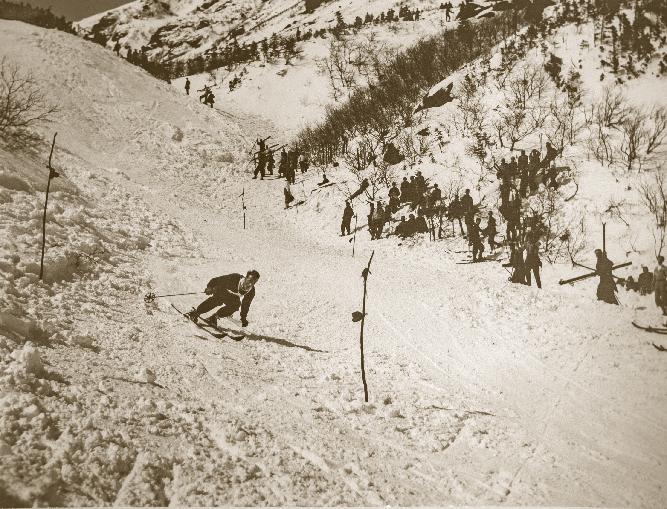
18 The Mount Washington Observatory was founded in 1932 (though the history of weather observation on Mount Washington goes back to the winter of 1870-1871). Joseph B. Dodge, who served as hutmaster for the Appalachian Mountain Club (AMC) and three others, started the Mount Washington Observatory. The Observatory’s first home, the 1908-built stage office of the Mount Washington Summit Road Company. On April 12, 1934, the Observatory recorded a wind speed record of 231 miles per hour. Used by skiers and hikers regularly, the Observatory continues to post the “Higher Summits” forecasts daily.
19 The Cutler River drains Tuckerman Ravine, which would typically freeze solid enough to provide an easier route into and out of the ravine area. In 1932, a nearby summer footpath, initially known as the Fire Trail, was rerouted with switchbacks and widened.
20 In 1934, uphill traffic and downhill skiing could finally be separated when an even wider trail was cut by the Civilian Conservation Corps (CCC), specifically for downhill skiing. The Fire Trail would eventually be named The Tuckerman Ravine Trail, and the downhill run would be

named after John H. Sherburne, Jr.; racer of two Tuckerman Infernos and instrumental in developing the 2.5-mile classic New England ski trail, which runs from the Hermit Lake cabin down to the AMC Pinkham Notch Visitor Center.
21 How did “HoJo’s” get its name? The Hermit Lake cabin at the base of the ravine had a roofline similar to Howard Johnson’s roadside restaurants, which were then springing up throughout New England.
22 Brooks Dodge, son of Joseph B, Dodge, grew up in the 1940s and felt there was a need for a ski technique that would allow for shorter, more precise turns. He perfected a two-pole turn in which he planted both poles, jumped his tails off the snow while keeping his tips brushing the surface and his upper body facing downhill, then pivoted his skis into an edge-set and prepared for a new turn. This turn allowed Dodge to ski in a narrow corridor while maintaining tight control of the vertical drop of each turn in the steep gullies of the ravine. Through the late 1940s and early 1950s, Dodge pioneered a dozen new routes and would do much to develop ski racing. He remained an active skier into the 1980s.
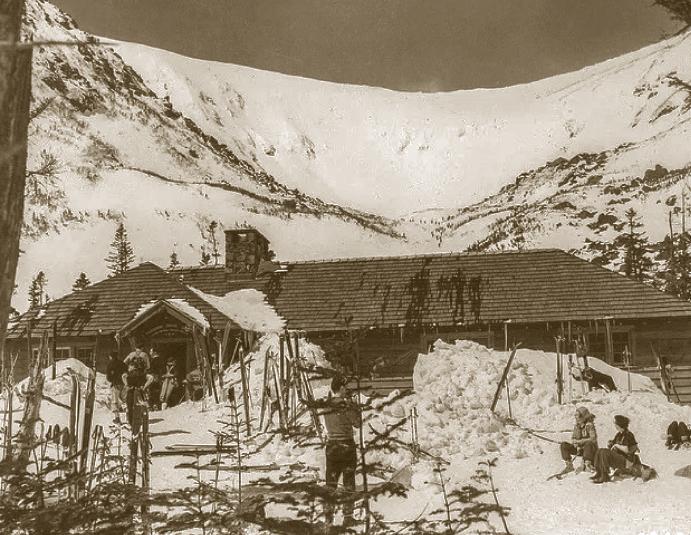
23 The Mount Washington Volunteer Ski Patrol (MWVSP) is among the oldest and most history-rich Ski Patrols in the United States. It was founded in 1939 by Henry “Swampy” Paris, originally as the “Mount Washington Safety Patrol.” Now part of the National Ski Patrol – Eastern Division, the MWVSP proudly serves as part of the NSP New Hampshire Region, patrolling Tuckerman and Huntington ravines from late winter through the end of May for each spring skiing season.
24 In 1950, the United States Forest Service (USFS) built a cabin at Hermit Lake at the base of the ravine, and avalanche “forecasting” officially began for Tuckerman Ravine. The Mount Washington Avalanche Center now publishes a daily avalanche forecast, usually by 7 a.m., from late October until the end of
MWVvibe.com
Dick Durrance races through gates on the Little Headwall on his way to winning the 2nd American Inferno, 1934. Brooks Dodge collection.
The first Giant Slalom race in the U.S., April 4, 1937 in Tuckerman Ravine. Photo by Harold Orne, New England Ski Museum collection.
May. The forecast provides avalanche safety information for people recreating, working, or traveling in the Presidential Range.
25 In 1966 a US Forest Service Avalauncher misfired, causing an explosive round to ignite in the device’s barrel, injuring two snow rangers. Officials of the White Mountain National Forest experimented with avalanche-control methods ranging from explosives to area closures from the 1950s into the 1980s, before adopting an advisory approach that relies on daily condition and hazard reports prepared by on-site rangers trained in snow science.
26 Well-known ski movie producer Warren Miller climbed Tuckerman Ravine in 1984 to film extreme skier Greg Smith, who owns one of the most insane cliff jumps in Tuckerman history, for his movie Ski Country. Miller would later quote, “Skiing down Tuckerman Ravine once is a fine experience; skiing it twice is a dumb experience.”
27 Heli-skiing in the East? In the late ‘70s and early ’80s, Al and Alison Risch operated Mt. Washington Summit Trips, the East Coast’s only helicopter ski operation. The trips were a single lift to the summit, taking off and landing on the Auto Road. The early trips were fully guided, and later trips were only offered to vetted experienced “Mount. Washington Skiers.” The USFS initiated a closure on mechanized access to skiing in the Cutler River drainage in 1987 when the Cog Railway announced they were also going to start offering weekend ski trains to the summit.
28 Ski racing returned to Tuckerman Ravine for the 1969 Inferno and 1984 Tuckerman Ravine Classic. When long-time
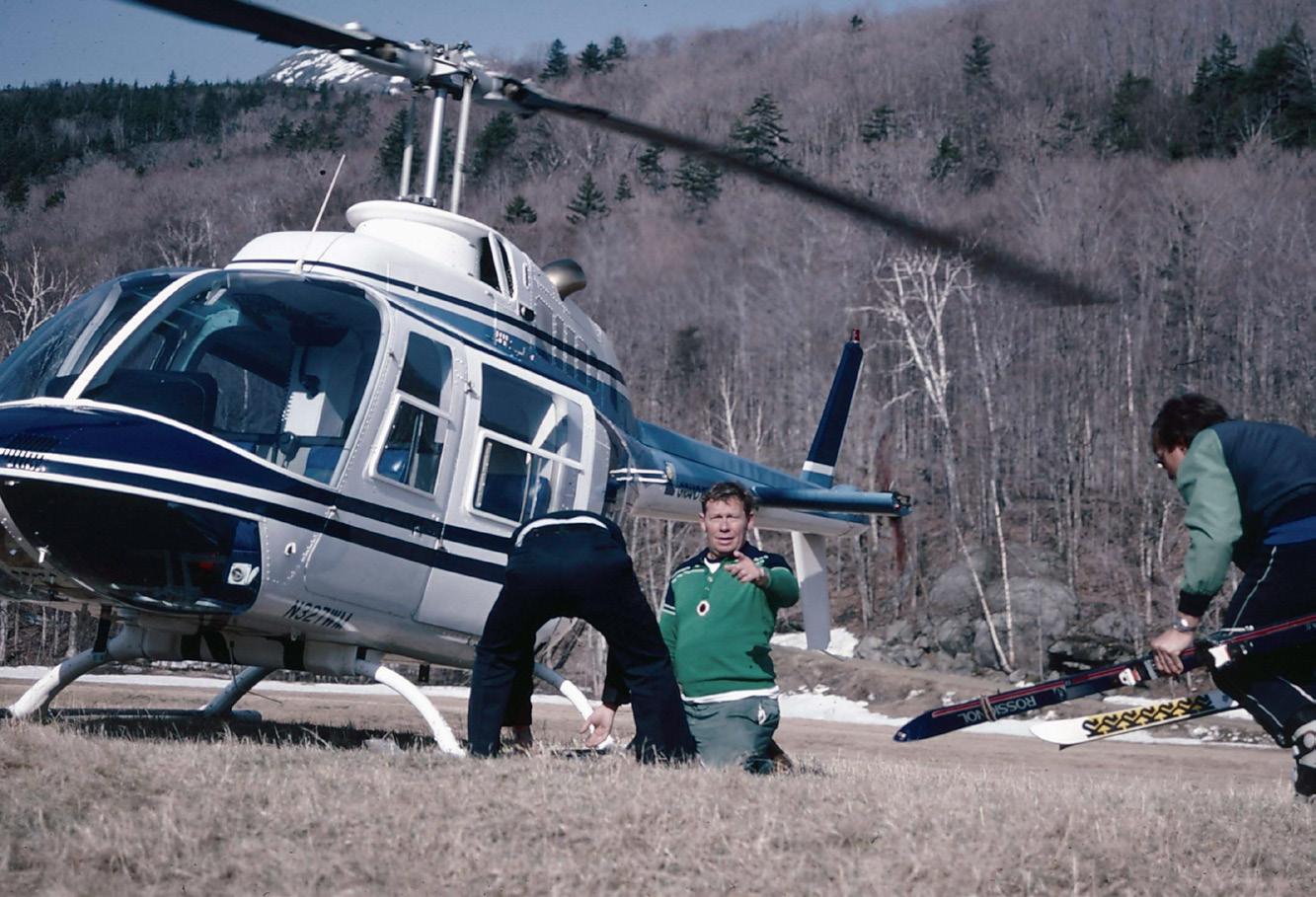
snow ranger Brad Ray and Mount Washington fixture Al Risch founded the Friends of Tuckerman Ravine in 2000, the Inferno was reimagined as a five-event adventure pentathlon that included a Giant Slalom ski race on Mount Washington as one of its stages. This new Inferno has been run since 2001, and will return with a new and exciting format in 2025. The Friends of Tuckerman Ravine has recently merged with the White Mountain Avalanche Education Foundation to form the Mount Washington Avalanche Center Foundation, providing direct support for avalanche forecasting and the snow ranger program.
SOURCES: New England Ski Museum, Friends of Tuckerman Ravine, Mount Washington Avavalnche center

Spring 2024 43
Al Risch directs a skier into an awaiting copter for a guided trip to the summit of Washington in 1979. Jake Risch collection.

RIDING THE WHITES A QUICK LOOK @ 2024
WHITE MOUNTAINS NEMBA
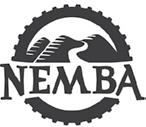
Trails, Advocacy, Community.
There are many trails here in the Mt. Washington Valley and throughout the White Mountains, and they all need a little attention. The group was very fortunate to avoid serious damage from the flooding this winter in North Conway, while others in the area were not so fortunate.
This year, the focus is the completion of the High School trail project on the West Side network. If you helped with the initial corridor cutting on trail-day in November, thank you! Trail-work days typically begin in May and wrap-up in the fall. The high school trail project will create an actual loop that keeps you in the forest rather than on the Forest Service road, with a connector to the Marshall network on the southern end and the rest of the West Side network on the northern end.
Mark your calendar for the annual Fat Tire Fest, September 20 through 22, three days of MTB mayhem in the MWV! Camping, trail shuttles, live music, and beer, located in the spectacular Fields of Attitash. Follow social channels noted below for up-todate info.
www.wmnembachapter.org
www.instagram.com/wmnemba
www.facebook.com/wmnemba
RIDE NOCO

Development and Sustainability in the MWV
The mission of Ride NoCo is to advocate and grow mountain biking in the White Mountains. They maintain—and responsibly build—trails for riding opportunities available to all abilities. Ride NoCo works with the local mountain bike community as the liaison to land managers and owners for continued and future access of public and private lands.
Ride NoCo builds awareness to progress mountain biking responsibly in the region. They do this by promoting sustainable land use, providing educational opportunities, and hosting events for new and experienced riders.
The Ride NoCo board often talks about the “endless potential” of the Hurricane Mountain Zone. That potential fills dreams and
keeps the group energized, and why they are stoked to announce a capital campaign for $100,000 that will fund projects to expand the Hurricane Mountain Zone and maintain and revitalize existing trails over the next couple years.
All membership fees and donations will be counted towards their goals. For 2024, the fundraising goal is $32,000. They hope that the community is as excited as they are about the proposed projects, some of which will occur in 2024. Ride NoCo will undertake the projects with a price tag as soon as funding allows. The riding community can be on the lookout for a GoFundMe to raise money for the first phase of this capital campaign. In the meantime—become a member or donate on the website. All membership fees and donations will be counted towards the capital campaign goal.
www.ridenoco.org
www.facebook.com/ridenoco
www.instagram.com/ride_noco
COÖS CYCLING CLUB
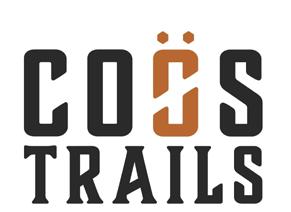
Coös Cycling Club - All Hands On Deck
This year will be an important one for the Coös Cycling Club. The trail network took a tough hit this past December, with extensive flooding and erosion across the entire network. Volunteers will be needed all spring into early summer, so please keep an eye on their social channels and websites for trail days. Trail workdays will also be listed on their events calendar on the Coös Cycling Club website.
Summer trail repair efforts will be fueled financially by the second iteration of the Frost Heave backcountry mountain bike event held on May 18 in beautiful Jericho Mountain State Park. Look online to register at www.bikereg.com/frostheave#Register. This unique early-season event is held on a diverse network of trails often reserved for motorized vehicles. Participants can expect challenging climbs, rugged descents, and a large dose of unexpected mountain bike gnar, all offered up one week before the park opens to motorized users.
www.cooscyclingclub.org
www.facebook.com/p/Coos-cycling-club-100039182903569
www.instagram.com/cooscyclingclub
44 MWVvibe.com
GORHAM Coös Cycling Club * BETHLEHEM Bethlehem Trails Association * NORTH CONWAY RideNoCo • NEMBA *
Johanna
Sorrell Photography
BETHLEHEM TRAILS ASSOCIATION

Check out the gear shed for free outdoor gear rentals!
The first public gear library is part of Bethlehem Trails Association and has been available by free membership since 2022. It offers balance bikes, youth bikes, and baby carriers for the kids, as well as helmets, poles, MICROspikes®, snowshoes, and now even fat bikes! Most of the gear is free to rent, or you can make a rental donation. All paid rentals help maintain and grow the library. The gear shed is funded by generous donations from members, community grants, and local businesses around Bethlehem. Just sign up to become a member (to get access to the lock code) at www.thegearlibrarynh.org, reserve what you need and the date and time that you need it, and then head over to the red shed located behind rek’•lis brewing company! The Gear Shed continues to grow and is always looking for free, high-quality outdoor gear to build the collection. The Gear Library - www.thegearlibrarynh. org 2085 Main St., Bethlehem
www.bethlehemtrails.org
www.facebook.com/bethlehemtrailsassoc
www.instagram.com/bethlehemtrails
SINGLE SPEED NEW ENGLAND

Hits Gorham, NH. June 28-30, 2024. There are people you see only once a year— people whose friendship transcends time and space, people who will help you fix a flat tire or hold your hair back. These people are single speeders. It doesn’t matter when or where, but you know that you will see each other again and that great times will be had. This is where Single Speed New England (SSNE) comes in.
SSNE has traveled the country chasing Single Speed USA as it bounces from one location to another. SSNE has even hosted the notorious event in Carrabasset Valley, Maine. Now, we are bringing it back as Single Speed New England, specifically to Gorham, NH, June 28-30, 2024. SSNE will bring the same energy as SSUSA, but we are keeping it local for those who can’t wander the country.
SSNE is partnering with Hub North and Big Day Brewing to bring you a two-day event steeped in single-speed culture. This event is for fostering lifelong friendships and for wearing your favorite pair of jorts. Friday will be a for-fun ride that ends at Big Day Brewing. Saturday will consist of two categories: Race Pace and Party Pace. Race Pace is for those who can’t stop to smell the roses. Will there be prizes? You’ll have to wait and see. Party Pace is for those who are here for a good time. This is where lasting friendships are made; this is where trailside flasks get passed around. And because SSNE is always looking to drag in newcom ers, there is a Geared category as well. This category is for those that are single-speed curious. There is no plan for this category other than you can join in the fun and be the butt of the jokes. Proceeds for this event will go directly into supporting the local trail system.
www.bikereg.com/ssne2024
www.facebook.com/SingleSpeedNew England
www.instagram.com/singlespeednewengland

GREAT GLEN TRAILS

Celebrating 24 in 24 at the 24 in the Glen: August 3-4, 2024
Moat Mountain 24 Hours of Great Glen, the most beloved and iconic mountain bike race in New England, returns! The course itself is a roughly 9-mile loop that winds its way around the carriage roads, doubletrack, bridges, and technical singletrack at the base of Mt. Washington. The course features challenging segments such as the infamous floating bridge over the Glen Pond. Racers can join in any of the race categories in the 24 or 12 Hour divisions.
www.greatglentrails.com/24-hours
www.instagram.com/greatglentrails
www.facebook.com/greatglentrails

Spring 2024
NORTH COUNTRY Please check with your local fire department if permissible fireworks are allowed in your area. (603) 323-8815 • Route 16, Tamworth, NH
Johanna Sorrell Photography




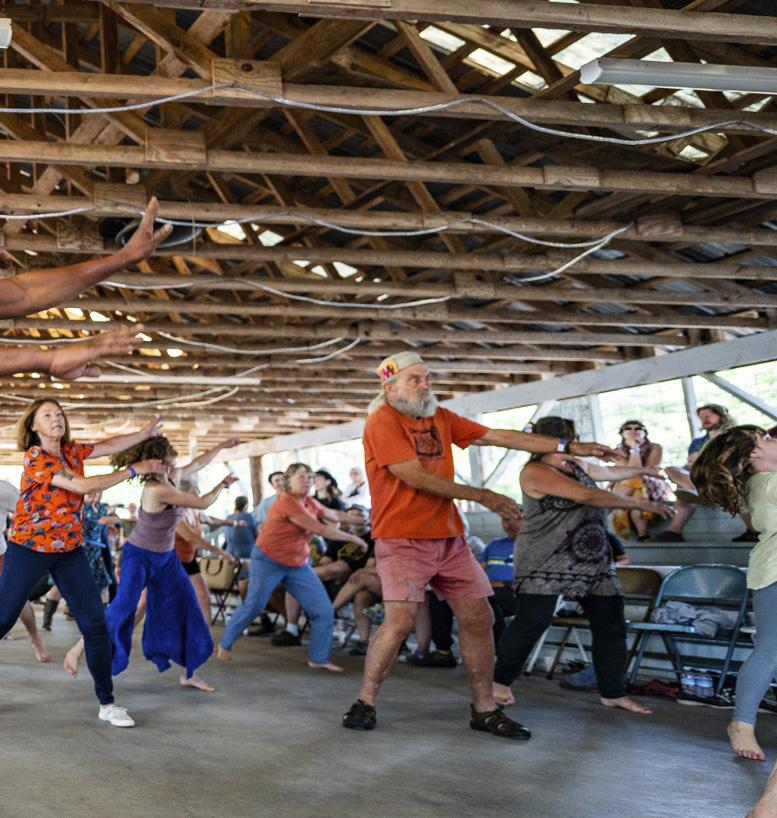

Ossipee Valley Music Festival
The Best Summer String Festival You
Haven’t Met Yet
Words by Ryan St.Onge Photography by Jay Strausser Visuals
For those traveling to and from the Mt. Washington Valley this summer or for those who live and play locally, there is no shortage of things to do and see in our northern neck of the woods. From pristine rivers to rugged mountains to a vibrant downtown, the North Conway and surrounding Valley area is bursting at the seams with potential happenings and adventures to experience.
What some people may not realize is that within a short 40- to 45-minute drive, you can also experience a yearly and week-long rural educational and collaborative string camp and weekend summer music festival that boasts some of the highest-tier bluegrass, folk, jazz, Americana, and international music around! Past national stars have included Billy Strings, Chris Stapleton, and the SteelDrivers, or the Wood Brothers, to regional acts such as The Bagboys, Buffalo Rose, or Uncle Jake & the
This grassroots festival begins with String Camp on July 21 through 25, and transitions to the Ossipee Valley Music Festival on July 25 through 28.
18 Wheel Gang, there is sure to be a style or genre for everyone in your group at the Ossipee Valley Music Festival. Or perhaps you’re more interested in learning a new instrument and want to associate with like-minded individuals? That’s also their “jam!” This grassroots festival begins with String Camp on July 21 through 25, and transitions to the Ossipee Valley Music Festival (OVMF) on July 25 through 28, and is located just a quick drive from downtown North Conway in the beautiful country setting of South Hiram, ME, offering both education and entertainment in one fun-filled week. There is something
47
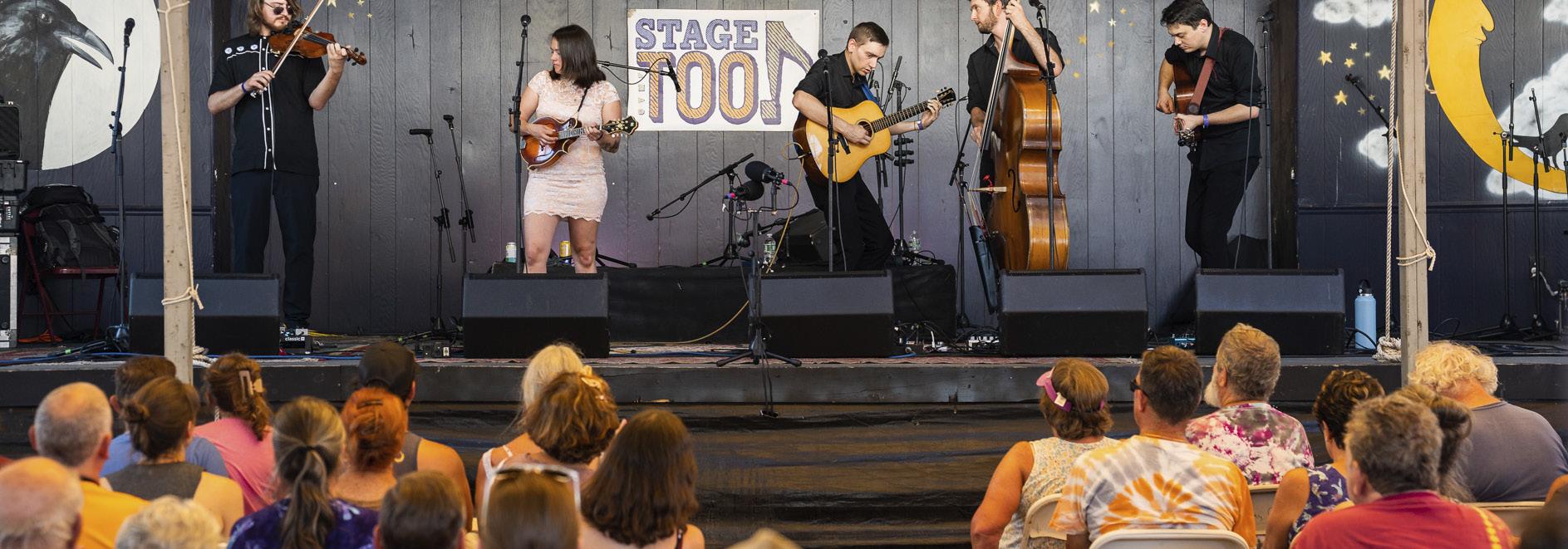
for everyone, and this festival prides itself on being very family-friendly, with a safe and enriching environment.
I took some time to speak with a few of the members of the North Atlantic Arts Alliance, a 501(c)(3) non-profit organization with a nine-person board of directors that organizes and hosts the festival. I spoke firstl with Molly Griffin McKenna, co-executive director. She began volunteering in 2011; she then moved to the area in 2013 to work alongside founder of the festival, Bill Johnson, who is also co-executive director of the Alliance.
According to McKenna, the festival was founded in 1999 by Bill Johnson to give an opportunity for rural Maine residents to experience life-enriching music and music education. Throughout the years, the festival has grown considerably and offers five varying stages of music, as well as week-long string instrument programs and weekend camping, food and merchandise vendors, collaborative music sessions, workshops, access to rural nature, and a swimmable river.

This festival takes place on the Ossipee Valley Fairgrounds and accommodates approximately 5,000 tickets sold, including multi-day, single-day, after dark, camping, and string-camp/festival packages. Many sites include RV hook-ups and are first-come-first-serve, so get your tickets in advance at www.ossipeevalley.com.
Campfires will be allowed in the recently acquired 30-acre expansion campground, known as the Crooked River, which is adjacent to the fairgrounds. However, fire pits on the fairground property are prohibited due to land-use agreements with the fairground owners/operators.
“The Ossipee Festival is the centerpiece of my summer. It’s everything I hope a summer will be. Music, camping, community, and late nights with friends! Happy Ossipee.”
– Gretchen Bowder
Each stage has a different location on the property and offers its own scheduling lineup. Here is a list of the stages and who you may find performing on them.
Main Stage: Offering Grammy-, IBMA-, Juno award-winning, world-renowned and ascending artists. Past performances include Sierra Ferrell, Billy Strings, and The Wood Brothers.
Stage TOO!: Intimate shady grove stage for Original and Local/Regional Showcase. Past performances include The Infamous Stringdusters, The California Honeydrops, and The Bagboys.
Brews and Bluegrass Stage: Offering regional and local acts in a 21+ beer-tent-style stage. Previous performances include various local regional acts.
Dance Barn: Various acts, which are often invited impromptu throughout the week based on collaborations,
The Eagle’s Nest (new this year!): Late night jam/party stage.
Although this festival is rural, the North Atlantic Arts Alliance has anywhere from 60 to 100 members at any given time, and these positions range from paid to volunteer. There are program coordinators, instructors, property management teams, day-to-day operations managers, and more. Gretchen Bowder, from Melrose, MA started her festival experience in 1999 as a performing member of The Bagboys band. Since ’99, The Bagboys have had the undisputed honor of being one of the first bands to perform, as well as participate every year since then. She started performing, then became a judge for the instrument-playing contest, then ran the children’s songwriting workshop, and in the last few years has moved to day-to-day operations manager for faculty of the String Camp. String Camp is a workshop that separates particular instrument-specific students into groups. They learn material throughout the week in their respective groups, then collaborate with the other groups to perform a Thursday afternoon String Camper’s concert, thus kicking off the arrival of the weekend festival goers. How incredible to have these two events so marvelously intertwined!
“The Ossipee Festival is the centerpiece of my summer. It’s everything I hope a summer will be. Music, camping, community, and late nights with friends! Happy Ossipee,” says Gretchen Bowder. Leo Norton, a board member based out of Amesbury, MA, began attending the festival 13 years ago. “We have a cabin in Hiram; we went for my wife’s birthday in 2011, had a blast, and we loved it,” says Norton. He volunteered for a few years following their initial visit as security in the Brews and Bluegrass tent, and was asked to join the board a short time later. Norton is now responsible
48 MWVvibe.com





Hosting national acts in the foothills of the White Mountains in an intimate timber-frame barn. Serving dinner by reservation before concerts. Open year round. Booking weddings and functions, too!
APRIL 2024
5 - Juston McKinney
12 - Cousin Curtiss
13 - The Jacob Jolliff Band
19 - Chris Smither
MAY 2024
4 - Alasdair Fraser and Natalie Haas
8 - The Wood Brothers
10 - Le Vent du Nord
11 - The Weight Band
16 - Bob Marley
JUNE 2024
7 - Kenny White, Carol Noonan & Kevin Barry
8 - Alison Brown
13 - Ricky Skaggs and Kentucky Thunder
14 - Judy Collins
JULY 2024
13 - Freddy and Francine
20 - The Rough and Tumble w. Alice Wallace
AUGUST 2024
2 - Stone Mountain Annual Anniversary Show with Teada
7 - Ladysmith Black Mambazo
8 - Bob Marley-comedian
SEPTEMBER 2024
7 - Tuba Skinny
OCTOBER 2024
11 - Friday - Maia Sharp & Willy Porter -two great songwriters
17 - Bob Marley-comedian
18 - Rickie Lee Jones
20 - Ruthie Foster
26 - Josh Ritter
27 - Barnstar!
17 - Session Americana
18 - Alana MacDonald Band
25 - Louisiana CallingThe Sonny Landreth Band and The Iguanas
31 - John Gorka
15 - Gaelic Storm
20 - Jake Shimabukuro
21 - Nick Lowe & Los Straitjackets
22 - Paula Cole
28 - Iris DeMent
26 - Rhiannon Giddens
27 - Bill Kirchen Band
28 - Lori McKenna
16 - Tom Rush
22 - Dave Alvin & Jimmie Dale Gilmore with The Guilty Ones
23 - Enter the Haggis
NOVEMBER 2024
9 - Ellis Paul
DECEMBER 2024
11 - Bob Marley
13 - Stone Mountain LIVE for Christmas
14 - Stone Mountain LIVE for Christmas
49
StoneMountainArtsCenter.com Just 15 minutes from North Conway (207) 935-7292 • Dugway Road, Brownfield, ME
FOR UPDATES & ADDITIONS 2024!
CHECK ONLINE
for booking StageTOO!, which is the regional showcase stage. He says they initially received approximately 60 band submissions to play, but now they need to sort through 100 to 200 submissions each year. Many bands are independent, yet they do receive submissions from production companies as well.
Next, is the not-so-easy task of narrowing down the plethora of entries to just 12 to 14 bands that will grace the stage. This is done by majority vote and generally occurs around
With so many music stage options, workshops, camping, collaborations, vendors, and incredible summer activities, all in a one-week package, it’s entirely amazing this festival isn’t already on the same playing field as higher profile festivals such as Bonnaroo in Manchester, TN or SXSW in Austin, TX.
April and May before the July festival date. StageTOO! also offers bands that are chosen a unique opportunity to perform on the Main Stage under certain circumstances, allowing for growth and spontaneity for musicians.
With so many music stage options, workshops, camping, collaborations, vendors, and incredible summer activities, all in a one-week package, it’s entirely amazing this festival isn’t already on the same playing field as higher profile festivals such as Bonnaroo in Manchester, TN or SXSW in Austin, TX.
The curators have been so focused on offering high-quality, community and music-based content, that advertising has managed itself—but it’s time to let the cat out of the bag. This festival has what you are looking for. Kids biking around midway while folks hang around the campsite and strum together, old friends reuniting after months apart, stories from the past year of epic jams and immersive storytelling, people gathering and working together to create a welcoming event of strings, friendship, and excitement.
One volunteer, Chris Foster, from Parsonsfield, ME said he’s helped with the festival off and on over the last 15 years, offering trash removal services and anything they need. He, however, has a double interest, as he also performs alongside so many of the musicians in attendance. A fellow musician and upright bass player, Chris has formed a strong bond







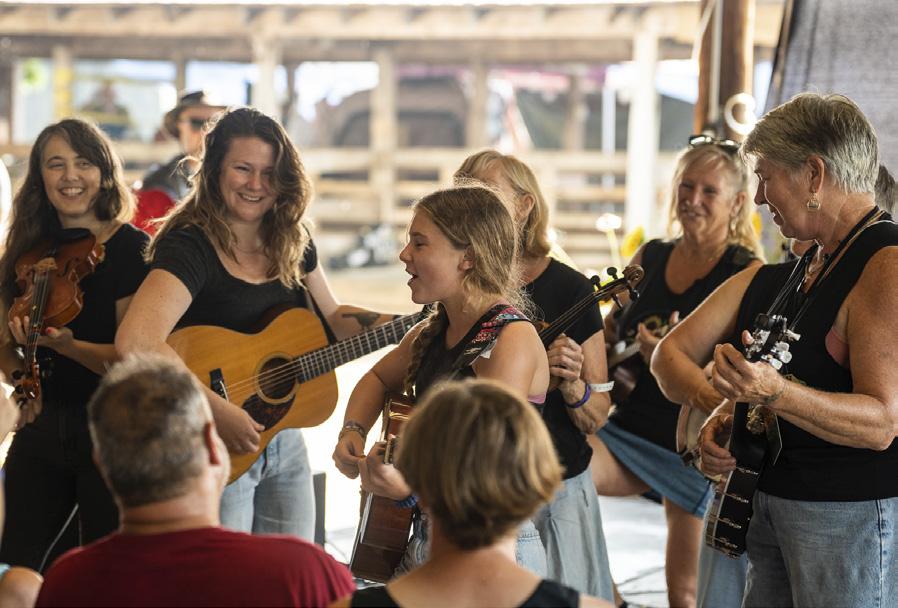


50

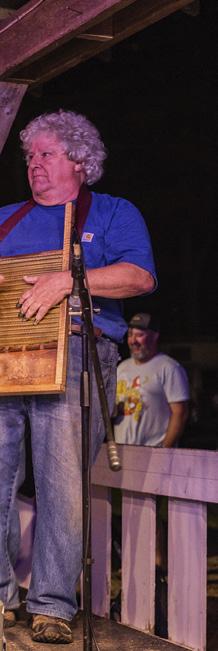



with the OVMF and has made a point of highlighting this event every summer.
“For me, it’s a picker’s paradise. I gotta see these guys [musicians]. Half of what I learn is at the campsite. Everyone’s rippin’.” – Chris Foster We
Ossipee Valley Music Festival
2024 Headliners
SATURDAY NIGHT HEADLINER
Molly Tuttle and Golden Highway
FRIDAY NIGHT HEADLINER Watchhouse
THURSDAY NIGHT HEADLINER
Amythyst Kiah
Sunday headliner (Maine Day) Griffin William Sherry (formerly of Ghost of Paul Revere)
ADDITIONAL HEADLINERS:
Terrance Simien & The Zydeco Experience, Willie Watson, Larry & Joe, Jake Blount, Authentic Unlimited, Twisted Pine, Lonesome Ace Stringband, Two Runner, Maya de Vitry, Rhythm Future Quartet, Samuel Nalangira, Old Hat Stringband, Mamma’s Marmalade, Uncle Jake & the 18 Wheel Gang, Tricky Britches, Blue Hill Brass, The Bagboys, with more to be announced.
Ossipee Valley Fairgrounds
291 South Hiram Road, Hiram, Maine
For additional information about the Ossipee Valley Fairgrounds, tickets, and camping, visit www.ossipeevalley.com.
Tickets prices from $45 to $225 including camping; children 17 and under enter free.
North Atlantic Arts Alliance
The Ossipee Valley Music Festival and the Ossipee Valley String Camp are both presented by our 501(c)(3) nonprofit, the North Atlantic Arts Alliance, based in rural Hiram, Maine. Our mission is to enrich our rural Maine communities by supporting arts performance and education, as well as the values of community, equity, and sustainability.




•
•
•
•
•
•
•
•




Spring 2024 51
specialize in
one-of-a-kind, live-edge furniture, featuring
making
...
custom dining tables
conference tables
high-top tables
coffee
tables
benches
mantles
bar tops
raw, unfinished
We also offer tree removal, lot and view clearing, custom sawing, and wood chips. Call us today and you’ll see ... WE’RE REAL GOOD WITH WOOD ! LOCATED IN INTERVALE, NH, IN THE HEART OF THE WHITE MOUNTAINS East
TIMBERWORKS EastBranchTimber.com (603) 387-4572 • 13 Town Hall Road, Intervale, NH
@EastBranchTimberworks
slabs
Branch
/East_Branch_Timberworks
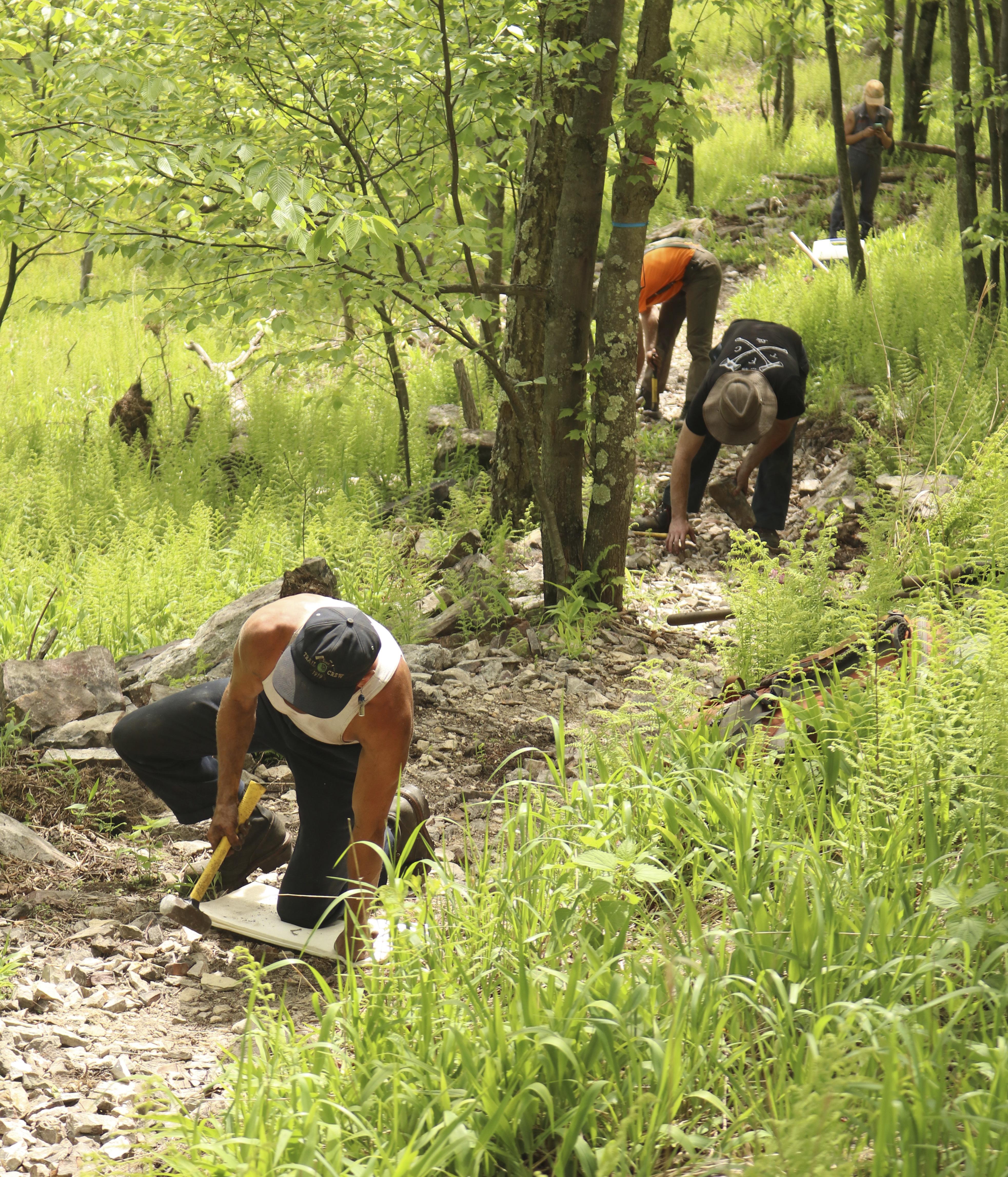
The Trail Fixing COLLECTIVE
Taking the Next Step in Trail Building
By Sam Norton
Members of TFC break stone on a new section of trail near Lehigh Gap in Pennsylvania.
After many seasons spent building trails for other crews, TFC’s founders learned something important: how a company does its work is as important as the physical work it produces.

Aspringtime hiker walking through one of the forested valleys of the White Mountains may look off trail to take in the budding green leaves of the forest canopy. They might gaze upward at craggy alpine peaks set against a milky-blue sky. This scenery has brought visitors to New Hampshire for generations. Continuing up the trail, the hiker may encounter an unexpected wilderness scene: the sound and sight of one of the trail crews at work maintaining the many miles of trail that snake through these mountains.
First, a hiker may hear the echoing boom of an axe swinging into an oak tree that has fallen across the trail. Once in view, the hiker will see chips of wood flying from
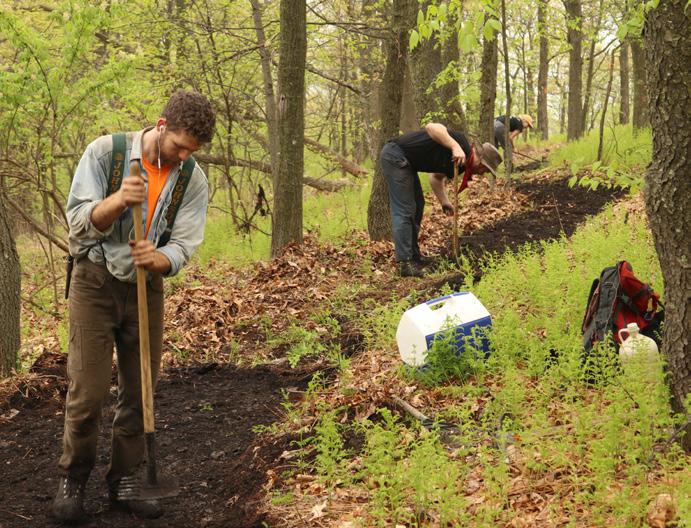
are changing dramatically, as they carry more visitors and endure more rainfall than ever before. This results in one defining symptom: erosion. While the foundation of our trails is threatened by these changes, there are individuals and organizations working to combat the problem.
The Trail Fixing Collective, LLC (TFC) is one local trail crew doing its part. Formed at a time when our deteriorating trails demand more trail builders, TFC also carries a social mission. As one of the smaller trails organizations in the Mt. Washington Valley, this crew has kept its vision simple and guided: to do consistent, professional trail work in an equitable manner. The business was formed by six professional trail builders who had previously worked

the tree before the worker tosses the obstruction aside.
This hiker sees ancient, unwavering peaks, contrasted with aspects of this landscape that are changing constantly. Our natural ecosystems and the ways that people move through them are never static. In 2024, our trails


for other trail organizations in the Valley. They share a vision for a crew that prioritizes the needs of its workers in addition to quality craftsmanship. Since incorporating in 2021, TFC has worked on public trails from New Hampshire and Maine to Pennsylvania.
53
While their business—and its members—are young, TFC’s founders credit their skills to preceding generations of White Mountain trail builders … and even to the loggers of a past era. Evidence of these traditions can be seen through axe-marks left on trees, their lifestyle in the woods, and in the words of local storytellers. No less important, their
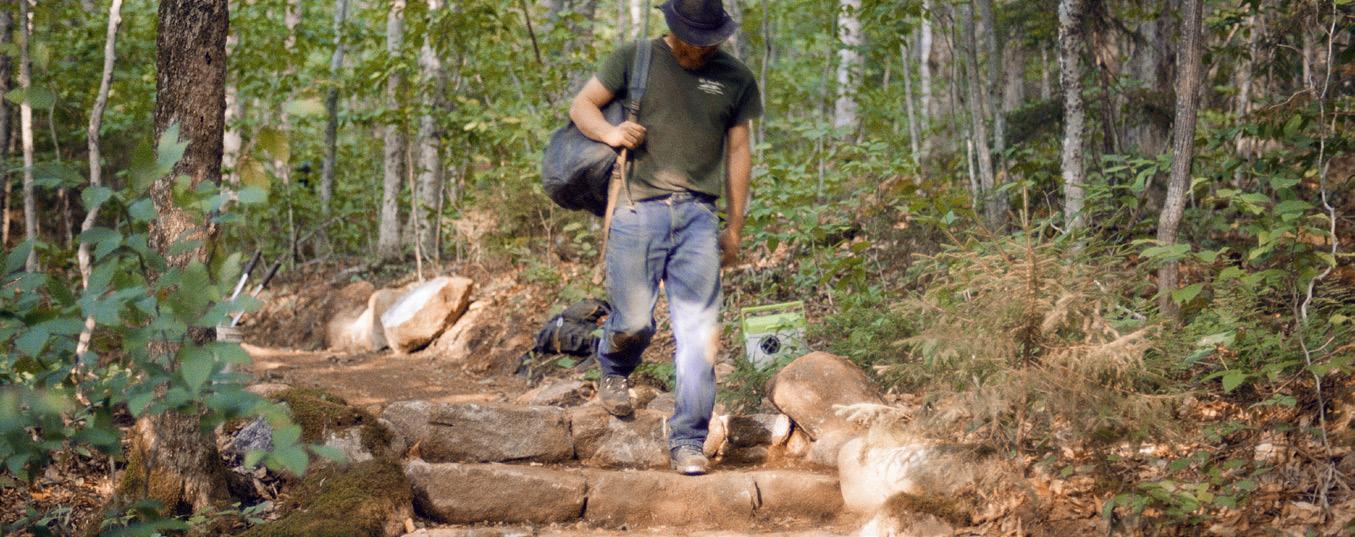
crew’s social structure is inspired by the work of unions and worker-owned cooperatives across the country.
After many seasons spent building trails for other crews, TFC’s founders learned something important: how a company does its work is as important as the physical work it produces. Their crew was created in the belief that trail builders should have the right to direct their own work. The crew knew that this right could be easily overridden in a hierarchy where some have decision-making power over others. TFC is entirely worker-owned; each trail builder holds the same sway in how the business is run and has equal financial ownership. Without administrators, the crew’s work is guided solely by its workers. This democratic structure provides tangible results: their workers ensure they all make a living wage each season, and decide for themselves the places and conditions in which they work. Planning a season of trail work is no easy task. The crew holds weekly business meetings year round—sweating at picnic tables during the heat of the summer, and over Zoom during the colder months.
The Work
After the snow melts and exposes a winter’s worth of downed trees, TFC’s annual trail-clearing work—known as patrolling—begins. When the crew patrols, they traverse the length of a trail, clearing fallen trees with axes or saws, cleaning drainage ditches, and cutting rogue branches that intrude into the path of hikers. This is, perhaps, the oldest and most fundamental form of trail work; it keeps trails from sinking back into nature. It’s also the first line of defense against erosion, because it eliminates obstructions that push people off trail. In the past, TFC has patrolled in the Sandwich Range (for WODC) and will do the same this summer in Waterville Valley (for Waterville Valley Athletic & Improvement Association—WVAIA).
Some of the oldest rules of the woods live on with TFC. The crew members often patrol in quaint wool shirts, and swing heirloom double-bit axes—which, are themselves, left over from the logging era. They prefer axes to chainsaws for clearing trees because of their relative lightness when

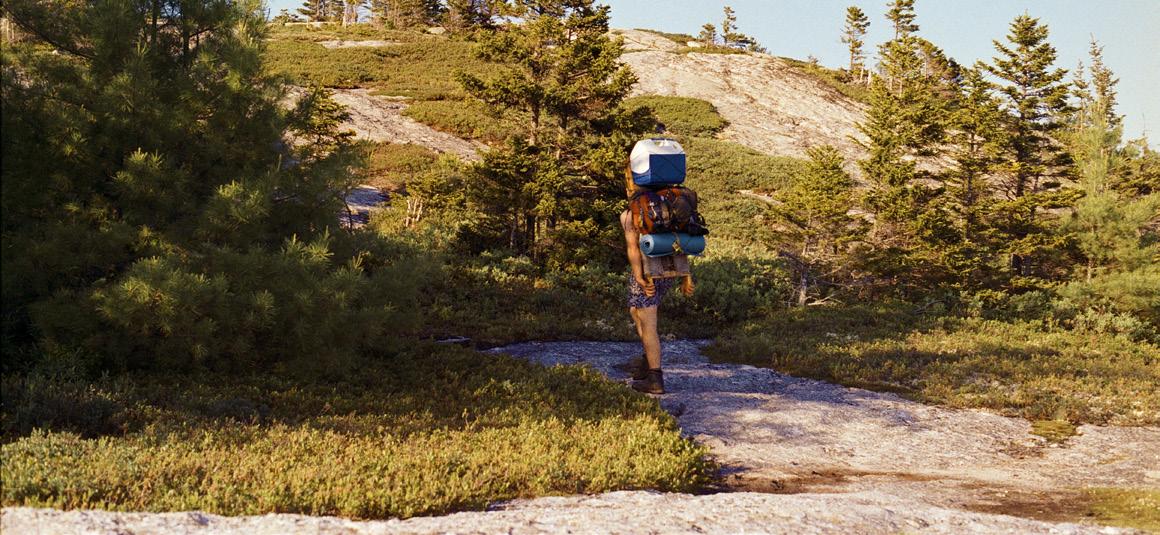
54
LEFT: TFC member Hunter Scott walks down a recently build stone staircase on the Old Bridle Path.
ABOVE: TFC member Colin Pogue uses a packboard during a project in the Mahoosucs of Western Maine.
TFC member Finn Mahoney uses his axe while on patrol.
carried for miles over mountainous terrain. New axes can be bought at a hardware store, however they lack the high-carbon steel of old axes, capable of holding a razor-sharp edge even after hours of chopping wood. While many aspects of backcountry work have changed since heavy-drinking loggers roamed the Whites in
The TFC was formed by six professional trail builders who had previously worked for other trail organizations in the Valley. They share a vision for a crew that prioritizes the needs of its workers in addition to quality craftsmanship.
the early 20th century, axe use has never disappeared. Crewmembers will tell you that it’s a joy not just to own such a historically rich tool, but to actually work with one in the woods as they are meant to be used.
Trail construction and reconstruction projects make up the rest of TFC’s summer season. Some projects involve cutting a new trail, either through previously untrodden terrain or as a relocated route for an existing trail. This work requires digging to remove the soft forest floor and shaping the soil to maintain a gradual elevation gain. As part of a multi-year project, each spring the crew relocates a section of the Appalachian Trail near Lehigh Gap in Pennsylvania.
On other projects the crew rebuilds existing trails where they are, adding stone or timber staircases, drains to divert water, and hardened tread to support greater numbers of hikers. In 2023, TFC rebuilt much of the trail on West Rattlesnake Mountain in Holderness for the Squam Lake Association. The crew spent four weeks installing over 100 wooden steps to retain soil on the eroding trail up the mountain. They used dimensional timber beams pinned into the ground by heavy stones and spikes of rebar. With these steps in
Crewmembers will tell you that it’s a joy not just to own such a historically rich tool, but to actually work with one in the woods as they are meant to be used.
place, the trail will stop deteriorating from rainwater and foot traffic—for now. Despite the onslaughts of black flies, TFC appreciated the friendly hikers and gorgeous views of Squam Lake.
TFC’s largest and most public effort is the Franconia Ridge Restoration Project, which spans State Park and National Forest boundaries. The multi-year goal is to reconstruct the entire Franconia Ridge Loop, which rises up from I-93 on the Old Bridle Path, traverses Fran-

Spring 2024 55
*17048284* CURRENT SALE PRICE OF ONE SINGLE IN-STORE ITEM VALID NOW THRU 7/31/2024 EMS® Rewards Program Membership required for discount. SIGN UP IS EASY & FREE! Visit www.ems.com/coupon-exclusions for details. THIS OFFER CANNOT BE STACKED WITH ADDITIONAL COUPONS OR PROMOTIONAL OFFERS | IN-STORE ONLY 15% OFF Shop & Save at our North Conway Store! 1640 White Mountain Highway Take Us On Your NEXT ADVENTURE! 24-74-009 EMS MWOBS Valley Vibe

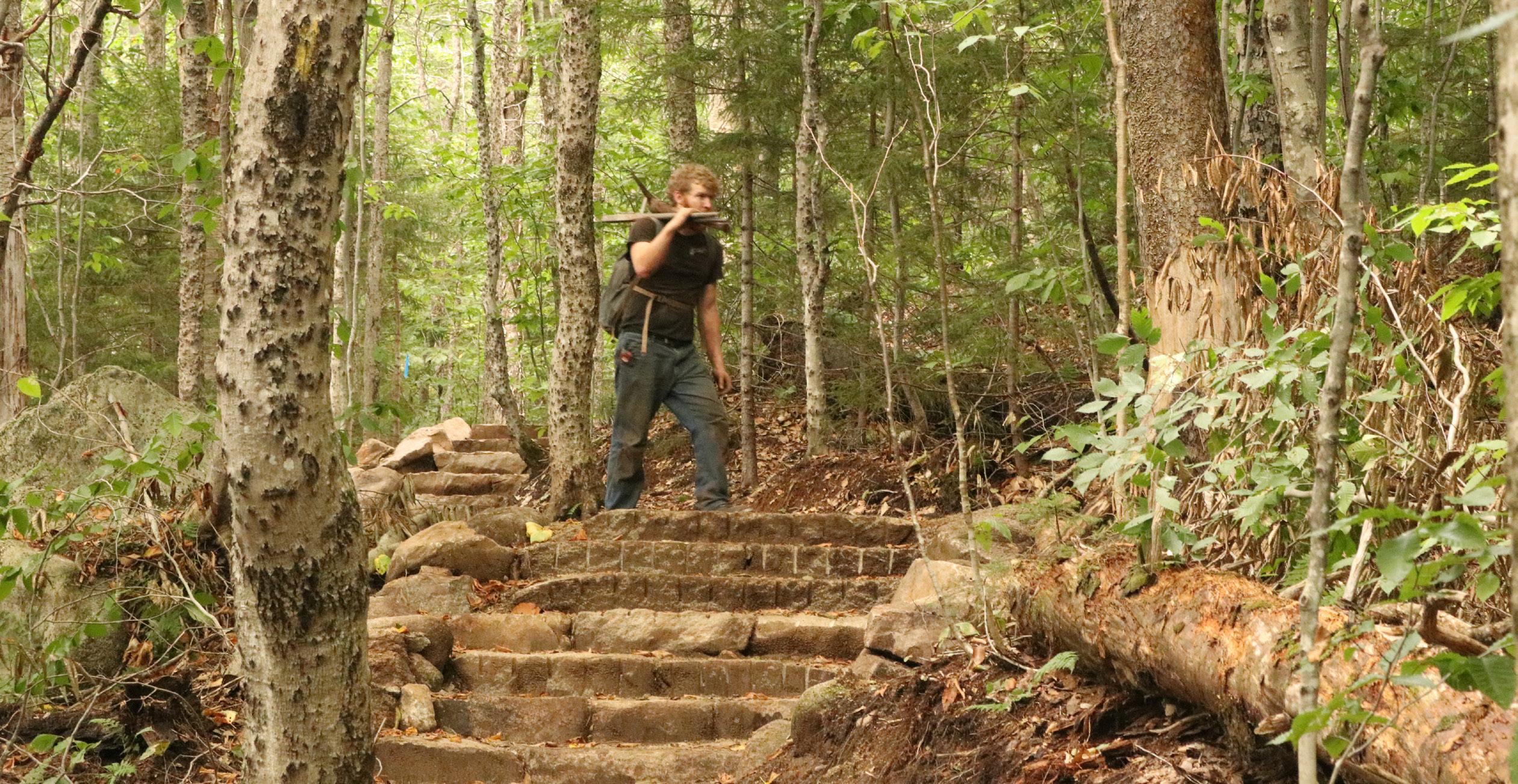
conia Ridge, and descends the Falling Waters Trail. In 2023, work began on the Old Bridle Path segment. A first for trail building in this area, the trail is being rebuilt to exacting standards:
5-foot width, with an incline of no more than 15 percent. With the partnership of trail-design-guru Peter Jensen, TFC’s stonemasons built natural stone staircases designed to ease the hiker experience and protect the trail from erosion. Unlike the classic White Mountains trails built from glacier-rounded stones, these staircases were crafted with rectangular stone split from large boulders. Alongside other local organizations, TFC will continue work on this project in future years, thanks to the efforts of the World Trails Network—Hub for the Americas.
deeper than their work on our trails. It can be seen through the tools they wield, the boots they wear, and the food they eat. They have fostered meaningful partnerships with local businesses and people. Their crew works only in Limmer hiking boots, crafted in Intervale by Peter Limmer & Sons. They are fed by Mountain Heartbeet Farm’s CSA in Effingham.
Having a small crew of worker-owners allows TFC to foster fruitful relationships with project partners and to keep their mission guided by principles, not profits.
Rooted in the Valley, and Looking Ahead
TFC’s connection to the Mt. Washington Valley community runs
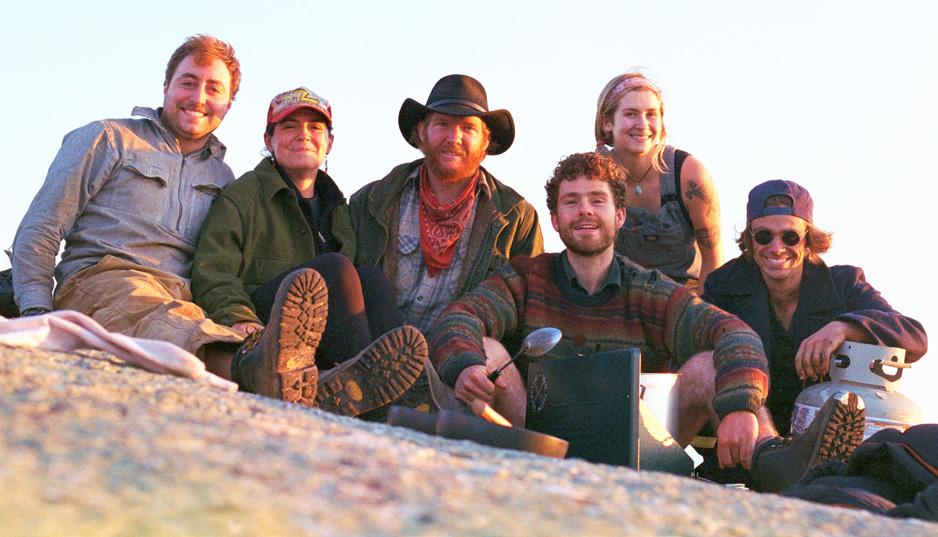
Having a small crew of worker-owners allows TFC to foster fruitful relationships with project partners and to keep their mission guided by principles, not profits. They will have no pompous CEO any time soon. TFC will continue working on public trails, and remain available to both large conservation agencies and smaller trails clubs. It is the physical impact on our shared lands and the human impact of shared management that keeps the crew committed to the White Mountains.
Trail Fixing Collective
Trail Fixing Collective is a worker-owned trail crew based in the Mt. Washington Valley. Their crew is a tool for the transfer of the craft of White Mountain trail building to new generations of craftspeople. They aim to be good neighbors in their community and good stewards in these mountains.
www.trailfixingcollective.com
trailfixingcollective@gmail.com
www.instagram.com/trailfixingcollective
56 MWVvibe.com
ABOVE: TFC member Hunter Scott carries tools over a stone staircase during work on the Old Bridle Path in Franconia Notch.

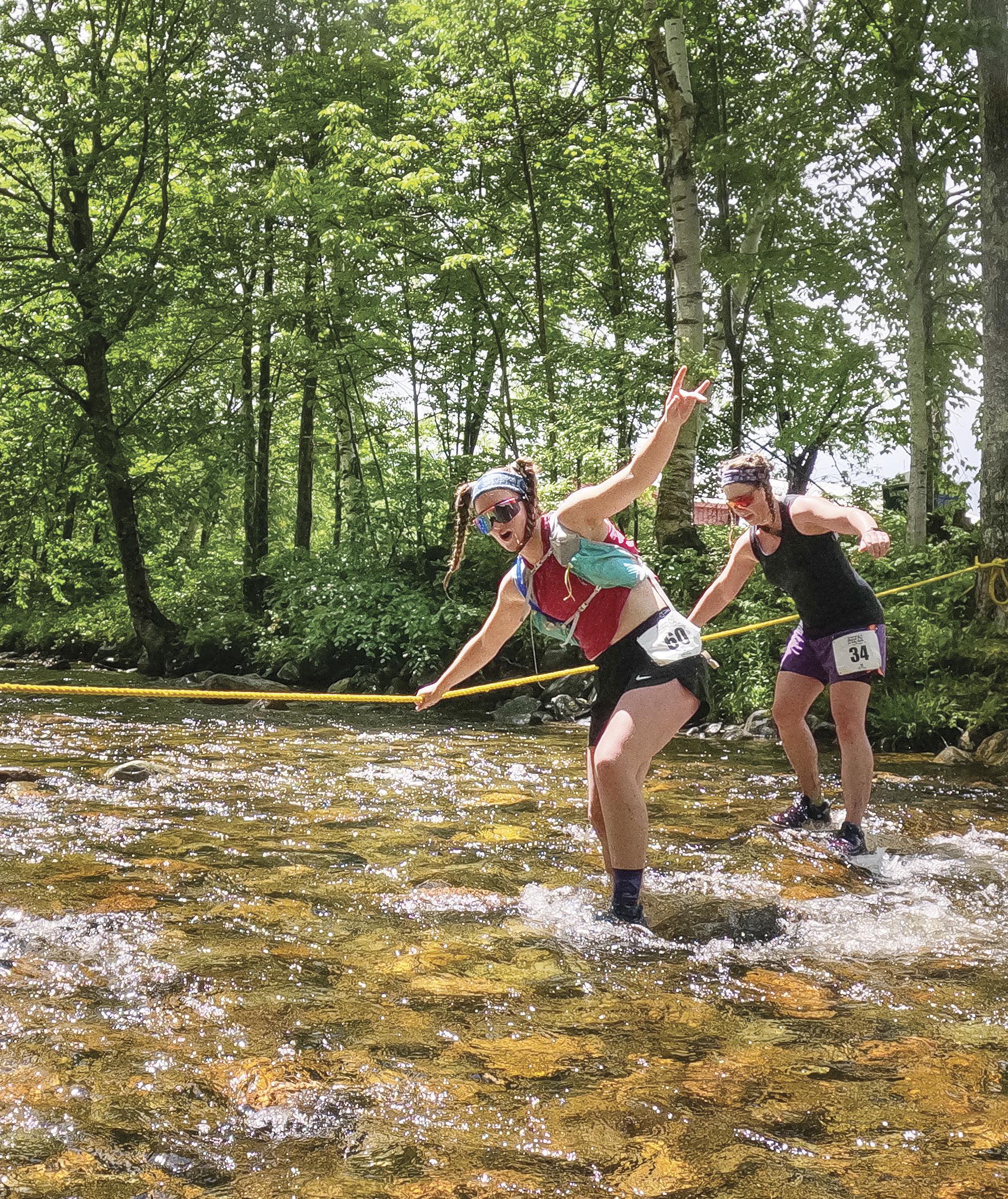

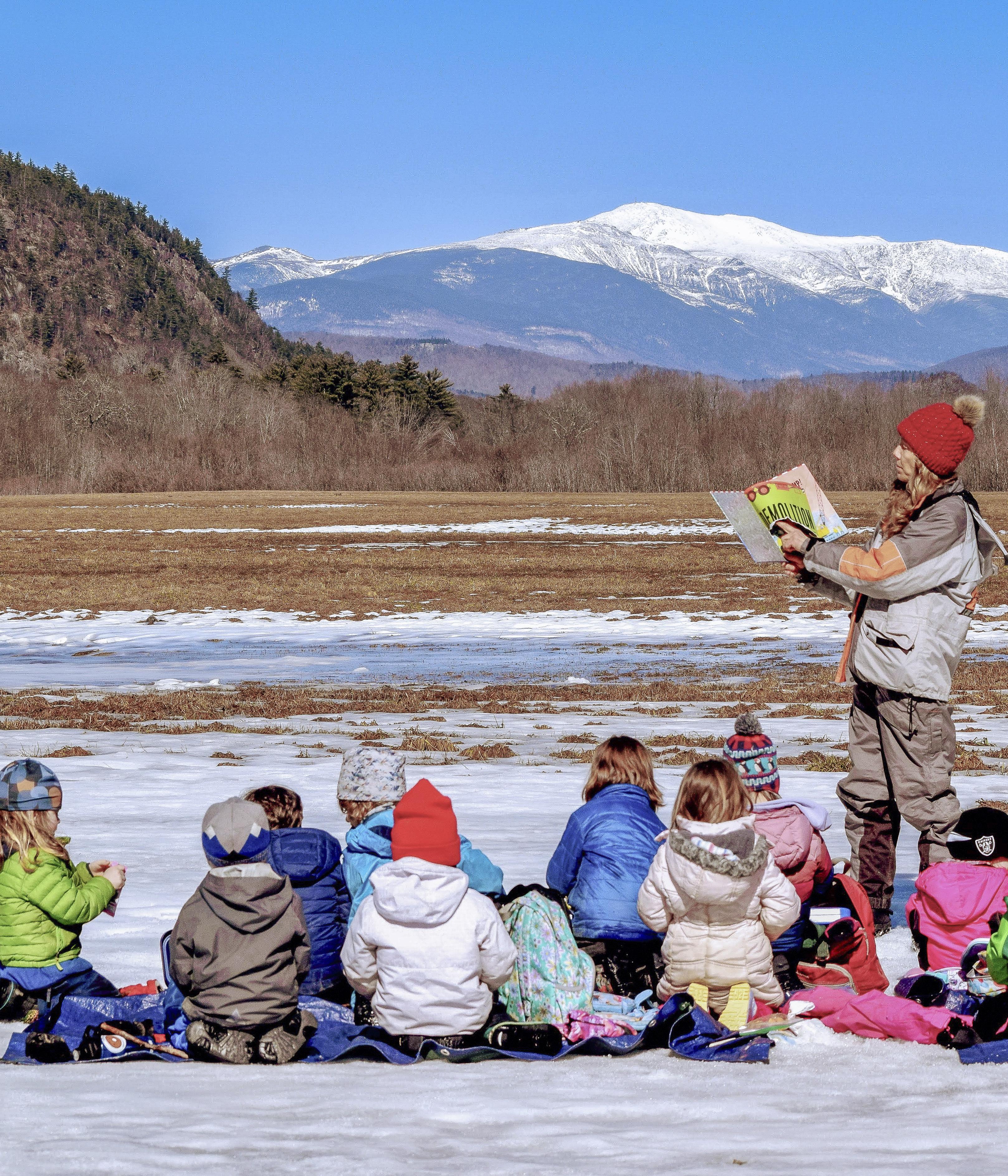
Embracing Child-Led, Outdoor Learning
By Emma Mabel Carlson Risch
Photo by Melissa Jerome
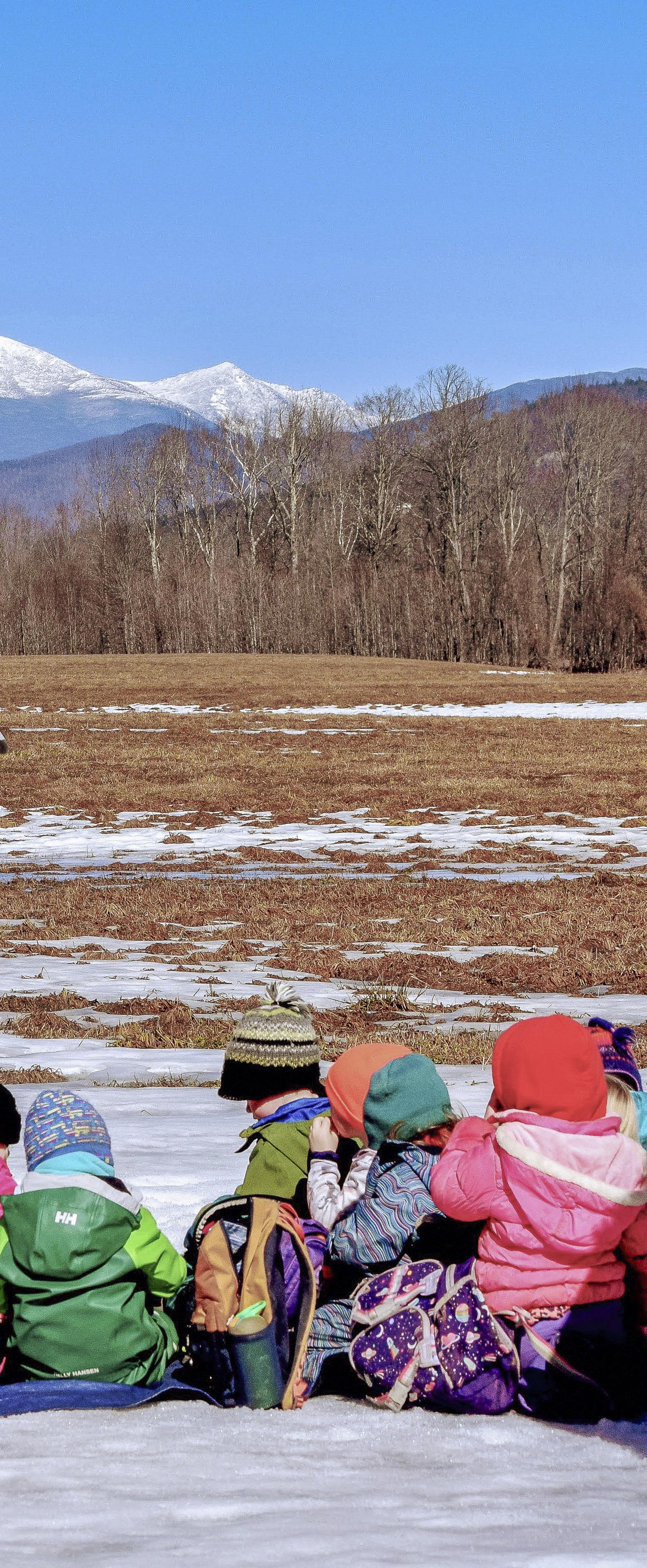
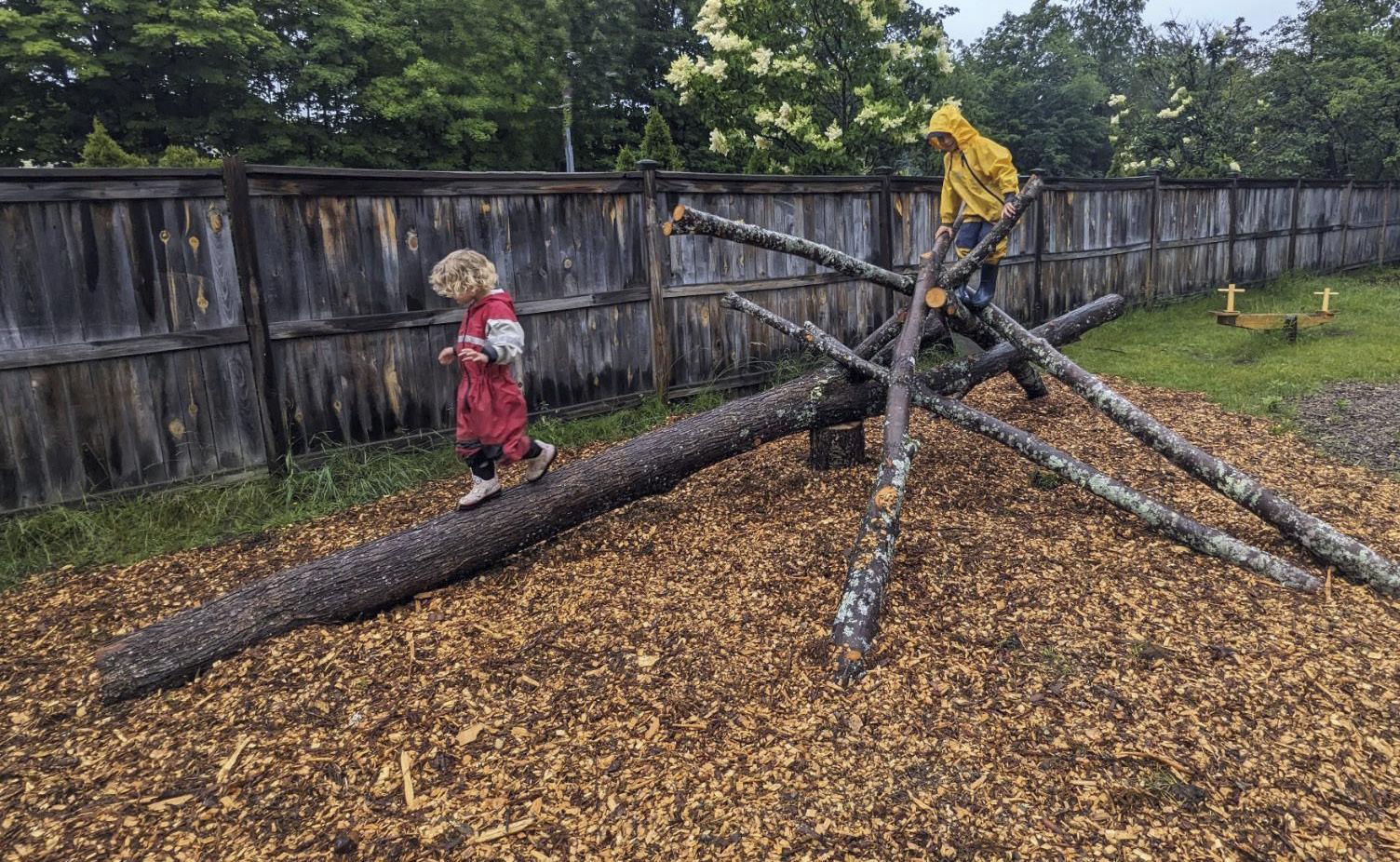
The Lilliputian School, a TimberNookCertified school, invites children to engage with the natural world through play that inspires them to be kind, curious, and resilient community members.
It’s an overcast, chilly spring morning at The Lilliputian School. Kids are lined up at the playground gate, a technicolor rainbow of rain gear and backpacks. Their teacher, Ms. Lauren, calls out, “Who can remind us of the two TimberNook rules?” Almost every hand reaches into the air, and a young student confidently answers:
“Be kind and always see a grown-up!”
And they are off. Ms. Lauren opens the gate, and the kids begin the 1/4-mile trek down the hill through the woods, over a bridge, and across a farm field to Lilliputian’s magical forest classroom—way out of sight of any buildings or roads.
Along the way, some kids stop to throw rocks in the flowing brook under the bridge, others pick dandelions to blow their seeds into the wind, some meander, and all interact with the natural world. The buzz of excitement is palpable as they journey towards their destination: the forest and the imaginative, physical, playful, independent freedom ahead.
In the field, before entering the woods, Ms. Louise gathers the children in the Intervale with sweeping views of Mount Washington and sets the stage for the students’ play by reading Bebé Goes Shopping by Susan Middleton Elya. This week’s theme is the market. Earlier in the week, the kids constructed a market in the forest using pallets, tires, boards, and other “loose parts.”
Today, when the students enter the forest, they discover a special donation of flowers from a local flower shop and other items staged to inspire imaginative market play. Without any prompting or direction from the teachers, the kids quickly get to work, deciding how to buy items, what days they work, and what they will sell in their market. A few break-off and open a butcher shop, finding a large log or “moose” that needs to be butchered. The children stay immersed in this creative storyline for quite a while before one decides she is a dinosaur, and
59
some students follow. Teachers observe that dinosaurs like to make a lot of noise and run and roar and blow off steam after a long intense market play scheme.
After several hours, the teachers call for lunch. The students gather at the stump circle, open their backpacks, and eat their lunches together before heading back across the field, over the bridge, and up the hill to their school building and playground for the afternoon.
Throughout their time in the woods, the children’s play ebbed and flowed
And while the students were playing in the forest classroom, each teacher took a “step back and tune in” approach. They were there, with eyes on the kids and were also intentionally giving students space to work at their own pace, navigate their own social conflicts, and gain independence.
from very still, engrossing play to wild and fast, active play. It almost seemed to echo the breeze blowing through the forest. Some engaged in “market” play while others spun off and created other storylines.
There were opportunities to resolve conflict, check in with peers, and practice empathy. Children communicated their feelings and helped their peers when they were sad. It was their community, their world, and they felt true ownership of it.
So, what were the teachers doing during this child-led play experience?
Earlier that morning, Ms. Melissa staged the play experience by adding the details that give kids the extra invitation to engage in a play scheme. And while the students were playing in the forest classroom, each teacher took a “step back and tune in” approach. They were there, with eyes on the kids and were also intentionally giving students space to work at their own pace, navigate their own social conflicts, and gain independence. If a teacher saw something that needed coaching or redirection, they stepped in; and if a student needed support, they sought out a teacher.


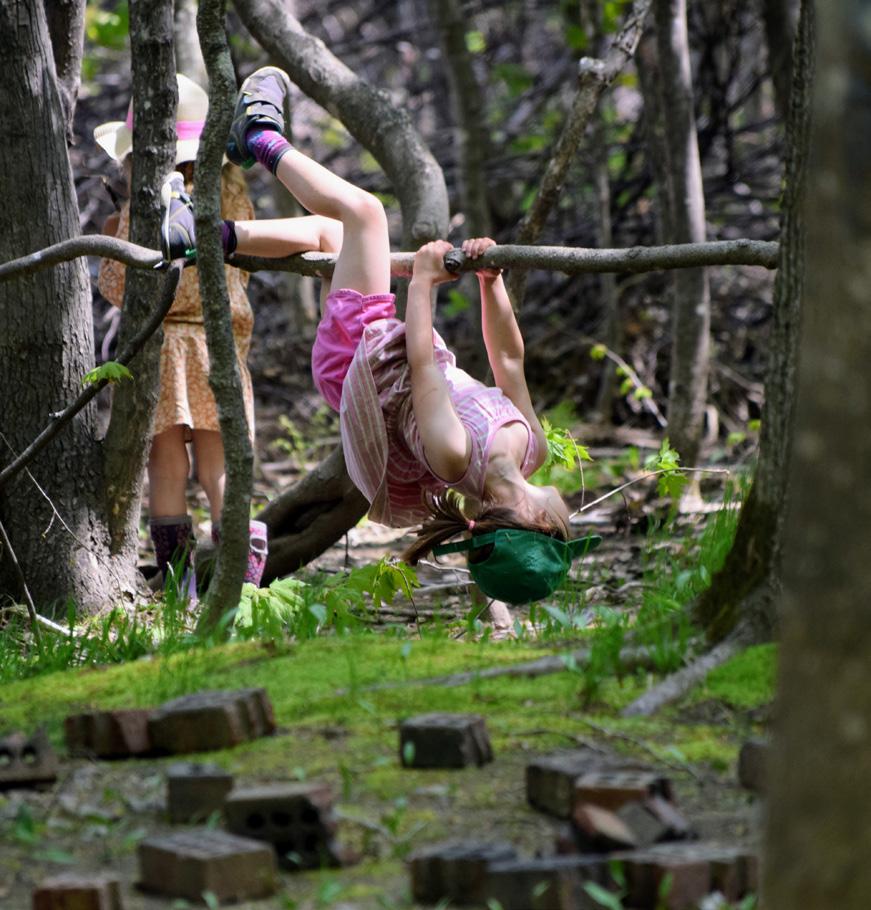
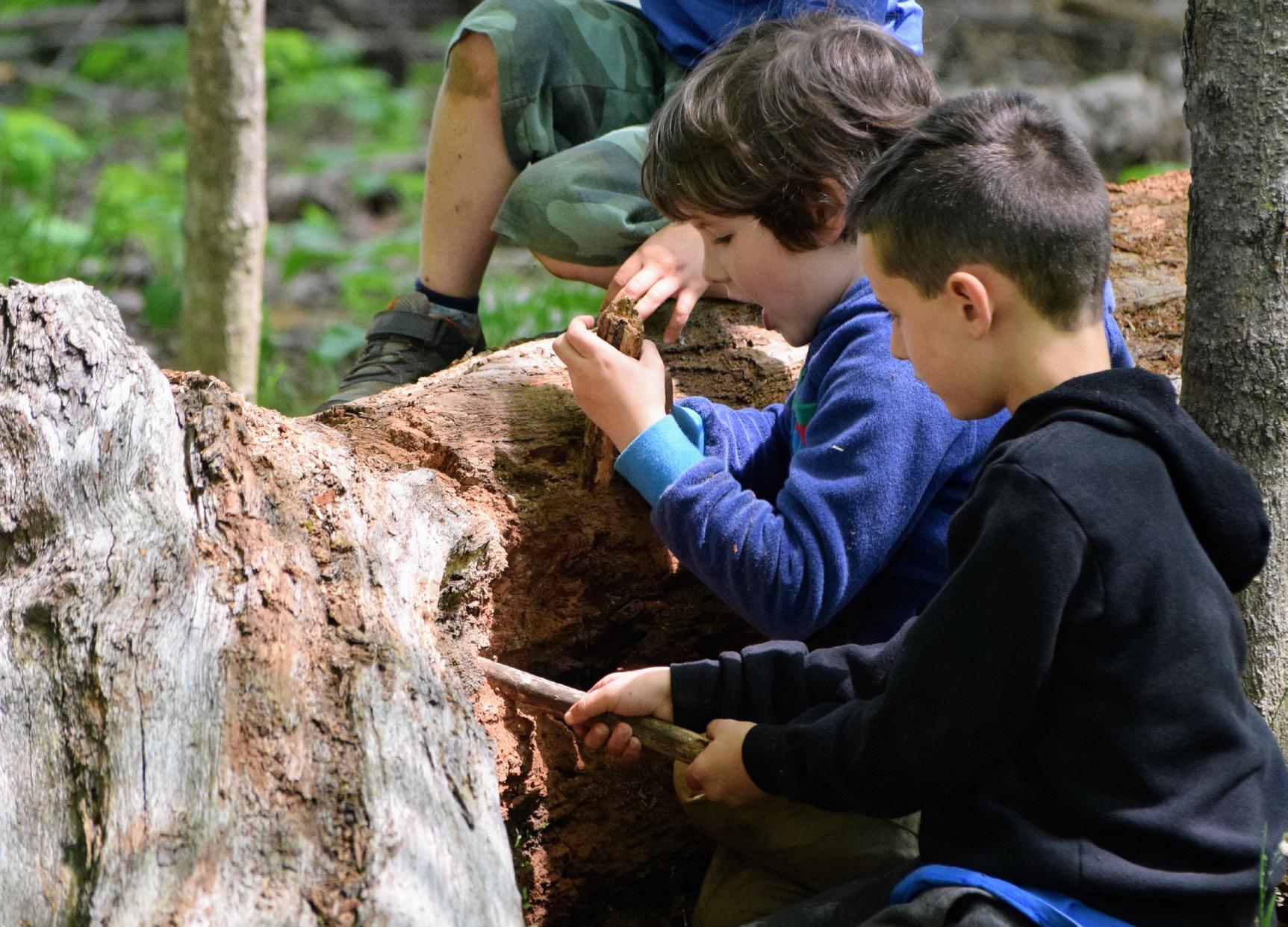
60
TimberNook Western Maine
Liz Maillett is a Fryeburg-based TimberNook provider. TimberNook Western Maine enriches the lives of the kids in the community. Their outdoor programs inspire children to play, learn, and explore through stories, games, and unique opportunities. They offer a variety of experiences for ages 1.5 to 12 years of age.
Liz believes that the children who attend TimberNook at her site “gain communication and problem solving skills, body strength and awareness, and opportunity to appreciate playing outdoors in all types of weather.” Liz also shared that “with the increase in screens over the years, short 20-minute recesses, and mostly adult-directed activities in and out of school, authentic child-led play at TimberNook is more important for children than ever before.”
Melissa Jerome, The Lilliputian School Executive Director
Melissa has been an early childhood educator for over 20 years. She holds her early childhood credential from the AMS (American Montessori Society) and is also a certified provider of TimberNook in the Mt. Washington Valley. She attended UNH and earned her B.S. in recreation management and policy with an emphasis on therapeutic recreation.
Melissa brought the TimberNook philosophy to the Mt. Washington Valley in 2019, founding The Children’s Path, LLC. In 2023, Melissa and The Children’s Path joined with The Lilliputian School, where she serves as executive director.
Kelly Evans, president of The Lilliputian School Board of Directors had this to share about Melissa: “I say this with the utmost sincerity that it is an absolute gift that Melissa has brought to the Valley, and now the children and families within the Lilliputian School community. I have watched her grow this passion for outdoor-based child-led learning over the last five years, and have been fortunate to experience the TimberNook program as a parent and as a teacher.
When we talk about creating a “yes” environment in our early childhood programs, allowing children to make mistakes (and learn from them), be curious, and not feel limited in what they feel they are capable of, TimberNook programming checks all the boxes, and more! We (The Lilliputian School) feel extremely fortunate to have Melissa join our team to lead the charge in advocating for play as learning and introducing us to the most magical learning environment for our children that is TimberNook!”




Spring 2024 61
J & C Tree Service LLC (603) 348-7454 • www.JandCTreeService.com Affordable tree services, based in Fryeburg, Maine, servicing the Mt. Washington Valley region. • Tree Removal • Tree Pruning Professional and safe operation specializing in large tree removals
Benefits of Unstructured Outdoor Play
The Lilliputian School—a beloved Montessori-based early childhood education center operating in the Mt. Washington Valley for over 40 years—recently joined with the Children’s Path, LLC to become the Valley’s first TimberNook-Certified school.
The Lilliputian School invites children to engage with the natural world through play that inspires them to be kind, curious, and resilient community members.
The TimberNook curriculum is a big part of the school experience for ages 3.5 and up. The youngest students are introduced to longer periods of uninterrupted play, both inside and out, to help prepare them for the transition to TimberNook programming when they reach 3.5 years old.
TimberNook defines the heart of its programming as the philosophy that children flourish when given the time and space to play in sensory-rich, experiential learning environments. Bringing exploration and nature together offers a unique way to reach children at a key point in their development.
Simply put, unstructured play in nature is good for a child’s overall development.
“A child’s neurological system is naturally designed to seek out the sensory input it needs in order to develop into a strong and capable individual. For instance, if a child starts jumping on small rocks, that is because their brain is ready for this type of activity. If a child is spinning in circles just for fun, it is because they need that sensory
The Lilliputian School invites children to engage with the natural world through play that inspires them to be kind, curious, and resilient community members.
input. If they climb a tree effortlessly, it means they are capable of doing so,” says TimberNook founder, Angela Hanscom.
She continues: “It is only when adults consistently step in and say, ‘No,’ to everything physical the child attempts that we start to see problems in development. ‘No climbing,’ ‘No running,’ ‘No playing tag,’ ‘No spinning,’ ‘No picking up sticks,’ ‘No getting dirty,’ ‘No jumping on the rocks,’ ‘No climbing the rocks,’ we yell when children attempt any kind of risk.”
According to a study at UCLA, on
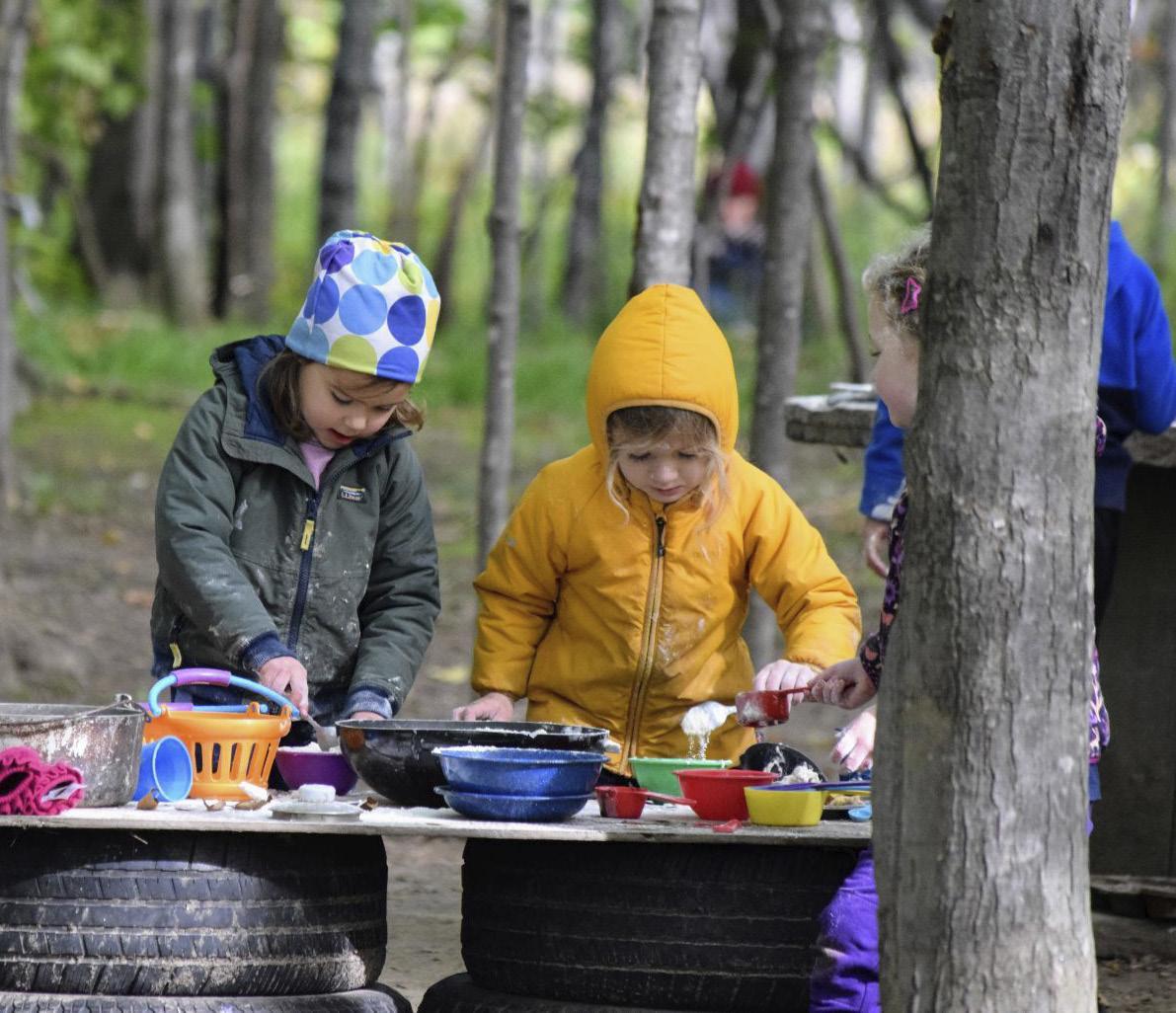
average kids hear the word “no” 400 times per day in their first year of life. No is a powerful tool for setting boundaries, preventing harm, and maintaining autonomy. “Yes” is even more powerful. Yes facilitates adventure, creativity, growth, learning, engagement, and excitement.
Melissa Jerome, executive director of the Lilliputian School, sums it up best in her recent reflection to families:
“We at The Lilliputian School value free play and understand the importance of it for your children. True play-based learning holds great benefits for your child. We talk a lot about building their foundation for optimal academic success. This looks like: sparking imagination with loose parts, allowing children ample time to develop play schemes, providing plenty of space for children to move in ways their bodies need, and providing lots of opportunities for problem solving and working through social conflict.”
Unstructured outdoor play has research-backed positive effects on gross and fine motor development, attention, visual skills, auditory processing, social skills, creativity, emotional stability, and conflict resolution. The students of The Lilliputian School validate this research on a daily basis. They are developing the critical life
skills necessary to be kind, curious, and resilient members of their community.
What Do the Kids Say?
Tate, age 5
“I like making forts with my friends at school. My favorite fort had 20 logs and a flag made out of pine needles! It could fit 10 kids. We used a tarp for the roofing and no grownups helped us. Everyone had a job to do.”
Meriwether, age 4
“I love Lilliputian because of my friends and the materials in the forest. I like all of them! And I like to play and find sticks and put them in my backpack. There is magic in the forest.”
For over 40 years, The Mt. Washington Valley has trusted The Lilliputian School with the care, nurturing, and development of its youngest residents. Founded in 1983, the school operated as The Lilliputian Montessori School from locations in North Conway and Jackson. In 2023, it rebranded as The Lilliputian School evolving into a Montessori-inspired TimberNook-certified school.
The Lilliputian School
North Conway, NH • (603) 728-9739
62 MWVvibe.com

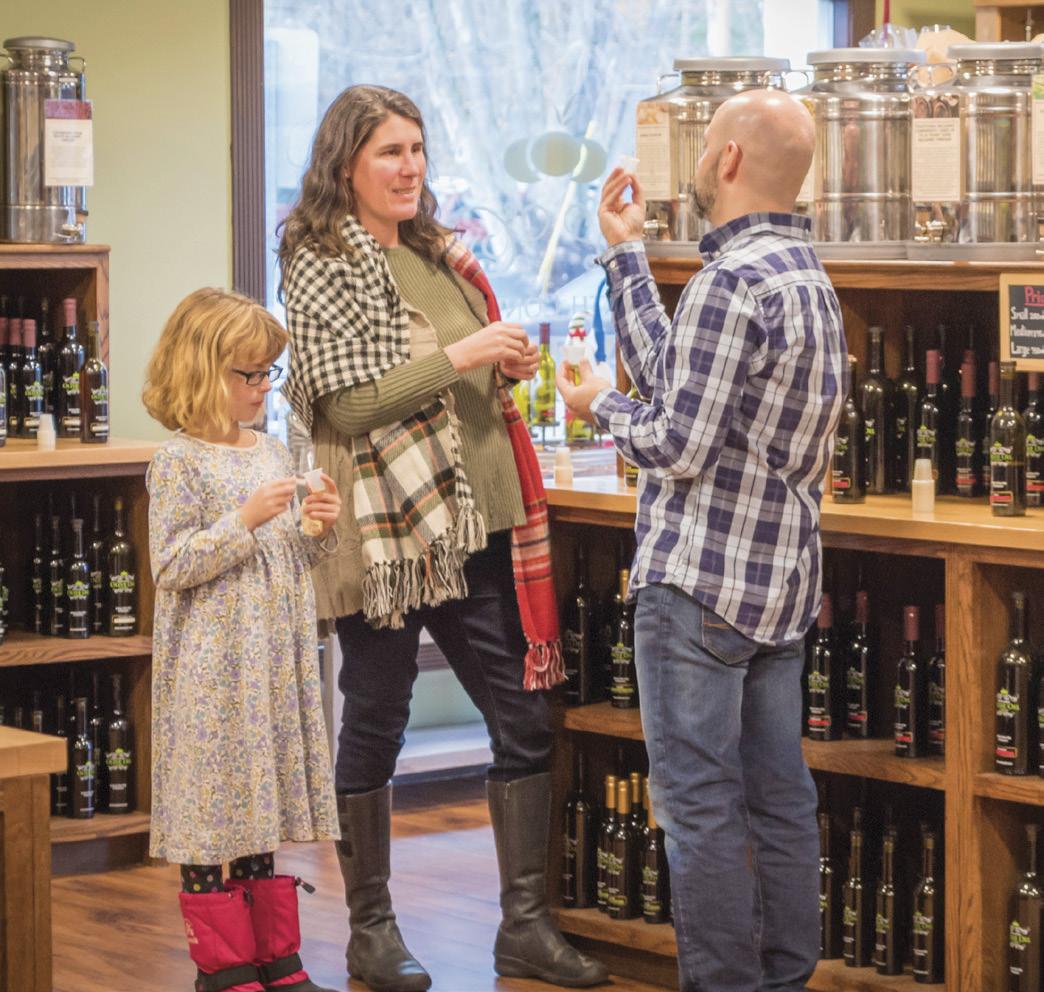


Spring 2024 63 (603) 307-1066 • www.ncoliveoil.com Two Stores! At Settlers Green and at 2730 White Mountain Highway, No. Conway, NH Over 80 different Olive Oils and Balsamic Vinegars. Non-GMO, gluten free, and no preservatives or added sugar. FIND SOME FASCINATING OLIVE OIL FACTS AND OUR RECIPE COLLECTION AT WWW.NCOLIVEOIL.COM Visit us in North Conway Village or Settlers Green next to the White Mountain Cupcakery!

THE MESA CLASSROOM Experiencing Education Outdoors
By Sarah Frankel, MESA Science Teacher & MESA Students
64 MWVvibe.com


The heart of the MESA program has remained the same: to provide 6-8th grade students with an opportunity to learn about their surrounding environment, to introduce state curriculum standards through authentic experiences, to provide personal growth opportunities, and to create a culture of leadership.
Every day at MESA—the Maine Environmental Science Academy— brings collaboration, creativity, exploration, a sense of community, and deep connections to the natural environment. The program has evolved over the last 12 years since Jay Robinson, superintendent for MSAD 72, first proposed the idea for an experiential learning program at Molly Ockett School. Throughout those 12 years, the heart of the program has remained the same: to provide 6-8th grade students with an opportunity to learn about their surrounding environment, to introduce state curriculum standards through authentic experiences, to provide personal growth opportunities, and to create a culture of leadership. What this mission looks like in action is truly something to behold.
PREPPING FOR THE OUTDOORS
Mornings in MESA are bustling, as students and teachers get organized for the day. Jotham Oliver, a founder of MESA and English language arts (ELA) teacher, begins each morning with a student check-in. Students sit in mixed age groups sharing current events, along with any fun they had
the night before. On any given day, but most often on Thursdays and Fridays, students review what is needed to be comfortable, safe, and engaged learners in the “classroom” that day. What is so amazing about the MESA program is that our “classroom” changes weekly, sometimes daily, from the sloped banks of forested streams, to the exposed bedrock of the White Mountains, and myriad other “classrooms” in between. During their three years in MESA, students become completely immersed in the local environment. While studying watersheds, students might connect with Saco Canoe and Kayak Rentals to paddle a stretch of the Saco River. Working with Greater Lovell Land Trust to better understand the formation of the White Mountains, students might climb Mount Sabattus to study the sculpted profile of Mount Tom. Led by Tin Mountain Conservation Center (TMCC), students might scramble up Square Ledge to examine mineral banding in metamorphic rock. Simply exploring these environments isn’t what MESA is all about—MESA focuses on coaching students to connect what they’ve learned in the
Spring 2024 65
classroom to what they’ve learned from the community partners out in the field.
Each week, Monday through Wednesday, MESA students maintain a fairly traditional classroom schedule, with lessons focusing on the state curriculum standards. What makes MESA unique is how these lessons are woven into and expanded upon by the experiential outings later in the week. In science class with Mrs. Frankel, students learned how to identify different minerals in rocks—and from there, identify the rocks themselves. During a visit to Madison Boulder, students used the mineral makeup of the boulder to identify whether it was a glacial erratic or not. Students were also tasked with measuring the circumference of the massive rock, converting arm lengths to meters using ratio tables introduced by their math teacher, Julie Schoenfeld.
BACK IN THE CLASSROOM
Back in ELA class, students were asked to piece together footage from multiple outings, including Madison Boulder, and write a script for a reflective documentary tying together the various pieces of their learning. Whether it is crafting their
Whether it is crafting their own math games for a family math night, M³, or standing before a large audience to recite a famous speech from memory, MESA students are introduced to the state standards in a way that is engaging and authentic.
own math games for a family math night, M3, or standing before a large audience to recite a famous speech from memory, MESA students are introduced to the state standards in a way that is engaging and authentic.
WHAT’S NEXT?
Finally, the MESA program is more than just academics. As educators, we take pride in helping our students become leaders, thoughtful community members, and genuinely kind human beings. In any given year, there might be 35 to 40 students in the program. Each of their personalities, interests, strengths, and weaknesses are embraced so that
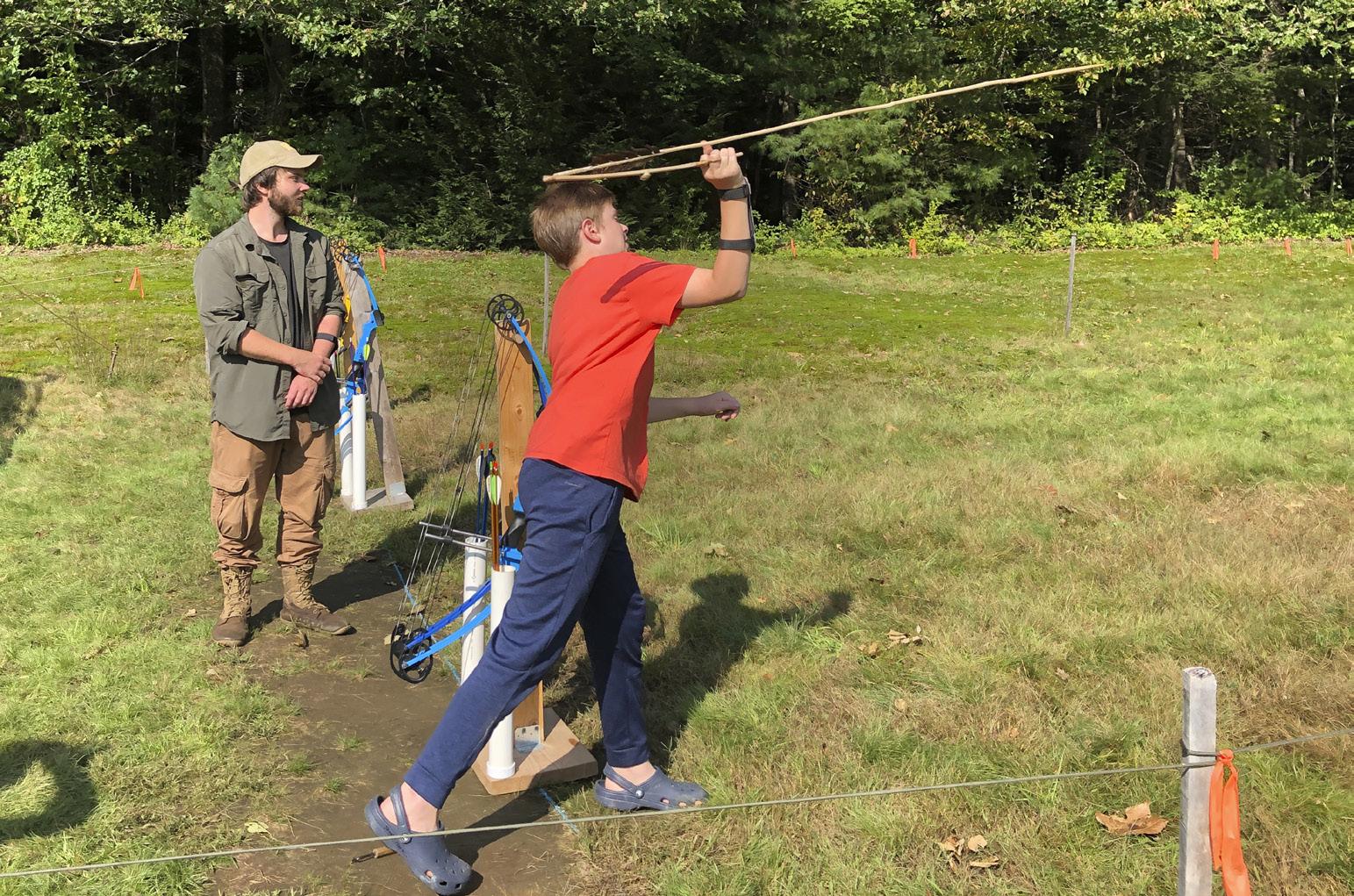
COMPILATION OF STUDENT WORK

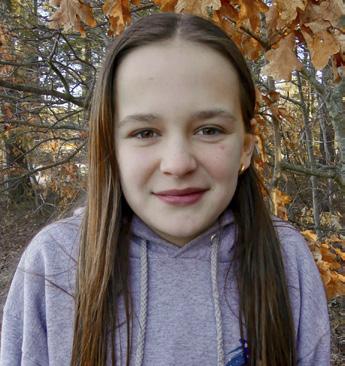
“MESA has brought back my sense of curiosity and expanded my comfort zone by pushing me out of it so often. MESA has brought me closer to my peers and teachers, and my whole perspective on school has changed. Now I see school as a fun adventure instead of a pen and paper.” Zoe A.
“In MESA we have this thing called EXP groups, which are basically experiential groups. Each EXP group has at least one 7th-grader, one 8th-grader, and one 6th-grader, and when we go out on trips on Thursdays and Fridays, we work together on activities. My EXP group has helped support me in many different ways and helped me make sense of things when I get confused. This may be my first year, but so far MESA has helped me work better in groups and helped me to understand our world and how we can make it better already.” Ella D.

“Coming into MESA isn’t something you try out then leave for a couple of days. It’s a commitment. Standing outside in freezing temperatures with pouring rain is a choice, not something you have to do. In MESA, you are responsible, you participate, and have a good attitude. My older brother was in MESA a few years back. He never complained, and I see why. You see, every day after school, my dad asks me how school was. I always responded with, “Good.” But now that I’m in MESA, I have a story to tell. Every day is a new adventure. Being a part of this program means that you must endure the cold, humidity, heat, and rain. That’s one thing you should know about MESA; because what’s fair in life is when you know the rules up front. Mondays aren’t terrible anymore and Fridays aren’t as exciting. I can’t wait for the upcoming years; with that being said, thank you for listening.” Layne J.
66 MWVvibe.com
Sam McDonnell practices using an atlatl during the MESA trip to Bryant Pond. This is one of the many activities students take part in, challenging them to step outside their comfort zone and learn new skills.
Photo by Jotham Oliver



“As someone who lives in New England, I’ve always loved being outside, whether it’s hiking, swimming, or skiing. In MESA, 40 percent of our school week is outside in the woods snowshoeing, biking, or even just walking around. Being a MESA student has made me so much more observant of the world around me. When you’re forced to be quiet and you are given the right tools, you’ll realize so much is happening around you. You hear the soft sound of birds chirping. You might see an owl or an osprey. You might even discover an underground river. Once you know all the beautiful things happening around you, you’ll want to protect everything. Being a MESA student, I’ve learned how to prevent erosion, protect the water from invasive species, and protect small creatures.” Solana M.

“There is something so humbling about being in the woods with only nature and massive trees surrounding you. It’s so easy to get caught up in life, drama, and stress; the world feels so small, especially in a tiny town like Fryeburg. It’s when you’re able to spend the day outside hearing about how even the tallest mountains have been formed—when you know how truly small you really are. It helps you gain a lot of perspective. In MESA, I have been able to connect with nature more than I ever have. I think the best part of MESA is the fact that there is such a sense of community that you know that when you fall, metaphorically and physically, there will be someone to help you up. I’ve never gone a moment feeling judged in the MESA program. I want to thank the MESA teachers and community partners, for making MESA … MESA,” Claire M.
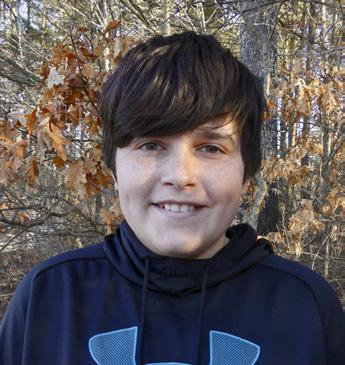
“Would you rather sit in a classroom and learn about an esker, glacial erratic, or subterranean stream … or would you rather experience it and learn about it in the field? Personally, I would rather experience it.” Nick A.
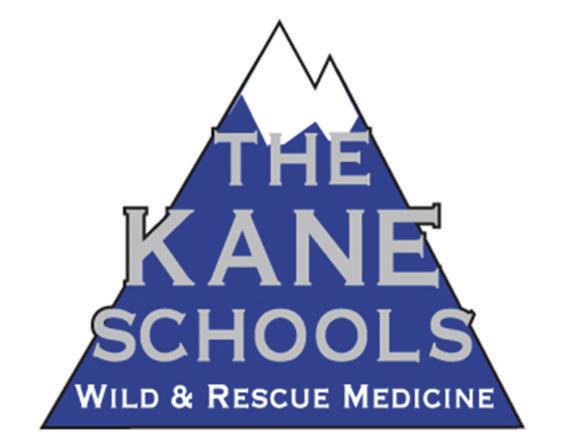

Spring 2024 67
Solana Manning (8th Grade) and Avery Jordan (7th Grade) use a hand-made barometer to measure changes in atmospheric pressure as they hike Flat Hill at the Heald and Bradley Pond Reserve with GLLT.
MOUNTAIN VIEW SERVICE CENTER (603) 323-8135 307 WHITE MOUNTAIN HIGHWAY CHOCORUA, NH 03817 Cindy & Dennis MANAGEMENTDrootin TEAM Servicing all Makes and Models ASE Certified NAPA Autocare WILD & RESCUE MEDICINE From people who have done what they teach Courses include Wilderness First Responder, EMT, Wilderness EMT, Advanced EMT, Wilderness Medicine Bridge Course, Wilderness First Aid, and more. thekaneschools@gmail.com THEKANESCHOOLS.COM
everyone feels encouraged to grow both as pupils and as individuals. In heterogeneous groups, veteran students lead by example, guiding their peers, and demonstrating what it means to be an engaged learner in all environments. Within the comfort of the MESA safety net, younger students are empowered to participate, try new activities, and take risks so that they can take on more leadership roles showing newer students (and teachers) what it means to be a member of the MESA family.
“When MESA began as an idea 12 years ago, beyond being impressed with the efforts of our staff to try something new and to develop a top-tier educational opportunity for their students, I have been most amazed at the culture of learning the original and subsequent staff members have helped to create and to maintain over time with ever-changing learners. Having adult learners (the teachers) who are fully invested in the program and in the learning going on translates into high levels and engagement for the younger learners (the students). And if it were only about learning knowledge and skills, the program would be a success. However, the team also involves students in the creation of a respectful, supportive community of learners where everyone has an opportunity to contribute. I am very grateful for the incredible effort, reflection, planning, and execution that goes into shaping such an amazing model for learning, and it would not be possible without our talented teacher leaders.”
– Jay Robinson, Superintendent
As MESA teachers, we frequently find ourselves expressing how grateful we are to spend our days surrounded by students and staff with insatiable curiosity, a desire to challenge themselves, and a sincere love for the program. But who are we to tell you just how exceptional MESA is? It is the students’ voices in this article that are most important, and so it is their stories we’d love for you to read.
YOUR TRUE SELF
As educators, we strive to have a positive impact on the lives of our students. Maya Johnson, an 8th grader in the program, recently shared, “I used to just ride in the car looking at trees but now every time I pass a tree that I know, I name it.” It is comments like this, along with the stories and reflections shared above, that

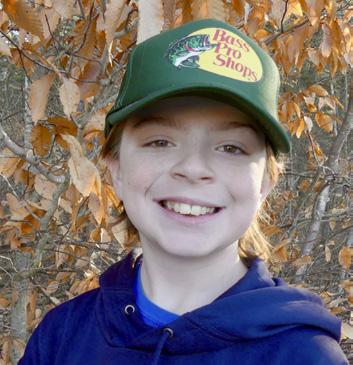
“In our geology unit, we’ve learned about rocks: ring dikes, pegmatites, eskers, and roche moutonnées. We’ve gone to the Ossipee Mountains, Kezar River Reserve, Tin Mountain Conservation Center, Madison Boulder, and explored trails everywhere in Mt. Washington Valley and Lovell, ME. Mike Dufhilo, from TMCC, gave us each an M&M to represent Earth’s layers. He told us that the candy layer was the Earth’s crust, the chocolate and a little bit of the candy layer was the lithosphere, another little bit of the chocolate was the asthenosphere, and the rest of the chocolate was the mantle. The peanut inside of it was the Earth’s inner and outer core. These metaphors, and experiences are why MESA rocks. Pun intended!” Jonah N.

“When I came into MESA as a young 6th grader, I thought, “This is different!” Differences can be both bad or good—and this time, the difference was good. I am learning about how so many things are connected in our world! Our major community partners (Greater Lovell Land Trust and Tin Mountain Conservation Center) take us on field trips twice a week and we learn about the water cycle, geology, and forestry. We have opportunities such as Family Engineering Night, Speech Night, and Bryant Pond that allow us to have new experiences. Everyone is kind and wants to help you, which is the environment that I want to be in during school, and anywhere else. Caring, supportive, knowledgeable, different, amazing, new, and creative are all ways to describe what MESA means to me.” Hana O.
illustrate the positive influence MESA has on its students. Beyond academics, the outdoor experiences, and connections made with community partners, there’s something more that fuels MESA’s success. Jaszzy Clark, a 6th grader, has summarized it perfectly: “MESA is somewhere to be your true self.”
For additional information and to learn more about the MESA program, check out the MESA website, www.mesa.msad72.org/home, MESA Experiential Outing Footage: Jotham Oliver’s YouTube Channel, or send us an email at mesa@msad72.org.
68 MWVvibe.com
Bryson Lounsbury, Zoe Anderson, and Hana Oliver (from left to right) take notes on the granite quarry located in the Rockwell Sanctuary at Tin Mountain Conservation Center. Students make connections between this quarry and a previous visit to the Redstone Quarry in North Conway.
Photo by Jotham Oliver





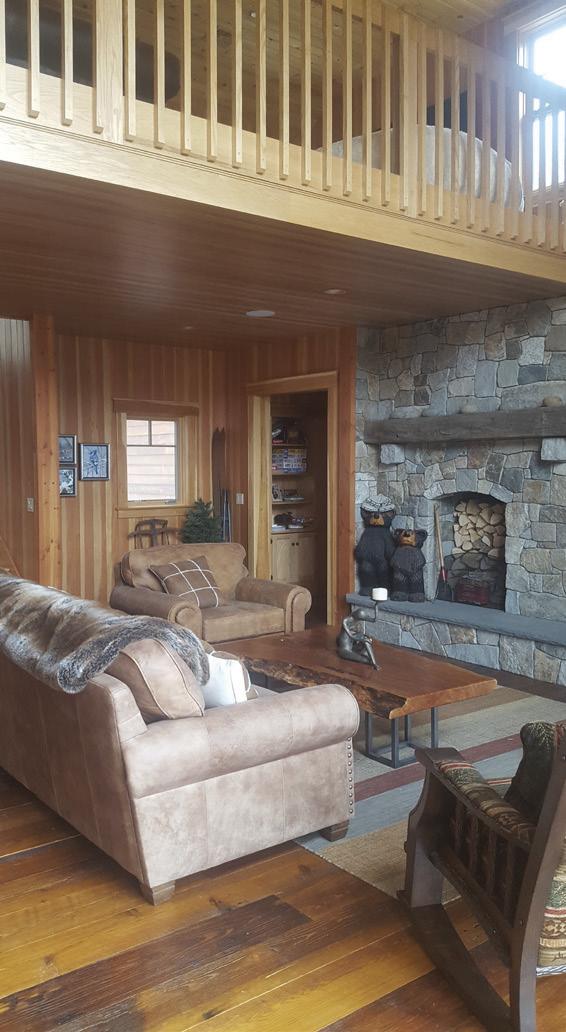

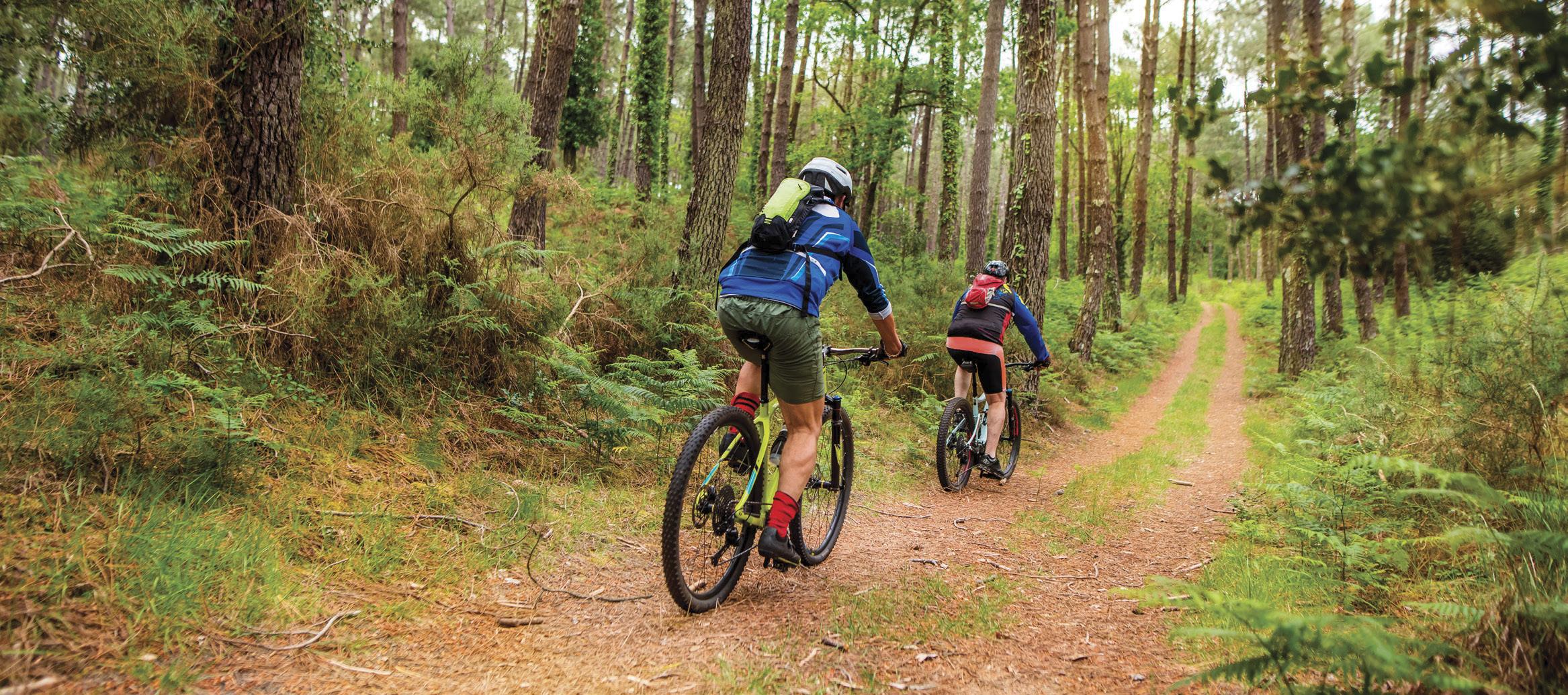

Spring 2024 69 FUEL YOUR ADVENTURE NORTH CONWAY HOUSE OF JERKY 2 STORES IN NORTH CONWAY North Conway Village 2730 White Mntn Hwy (603) 730-5474 Settlers Green 2 Common Court - Unit D46 (603) 730-5515 THE LARGEST SELECTION OF JERKY IN THE REGION! • Beef Jerky • Turkey Jerky • Exotic & Game Jerky NorthConwayHouseofJerky.com Western Maine & New Hampshire Lakes & Mountains Carol Chaffee, REALTOR® www.carolchaffee.com (207) 240-1641 • (888)439-8743 #882 david@fishstreetdesign.com (207) 697-2277 • Fish St., Fryeburg, ME www.FishStreetDesign.com
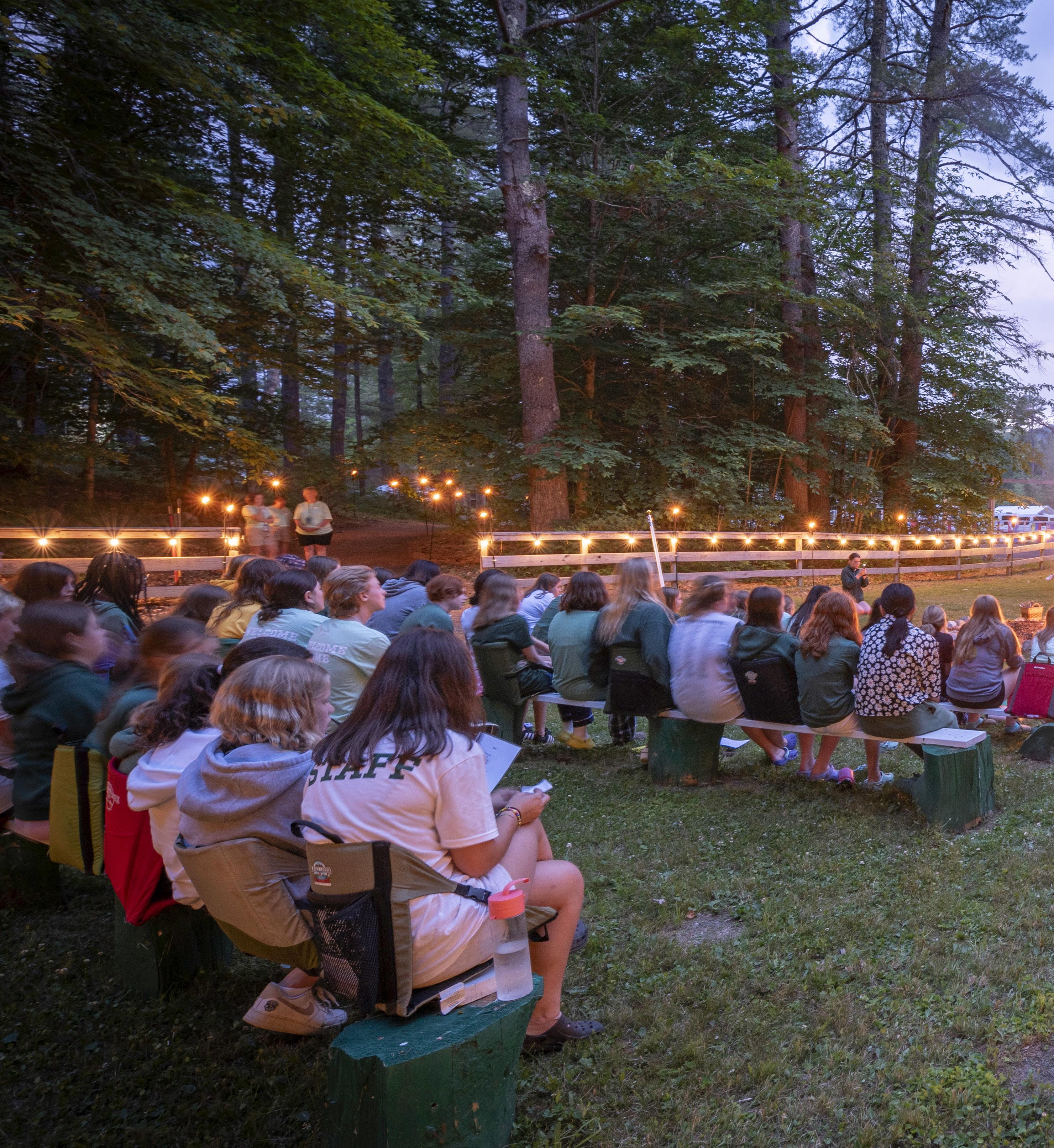
70 MWVvibe.com
EATON’S CAMP WAUKEELA FOR GIRLS
Where Old Friendships Begin
By Majo Orozco
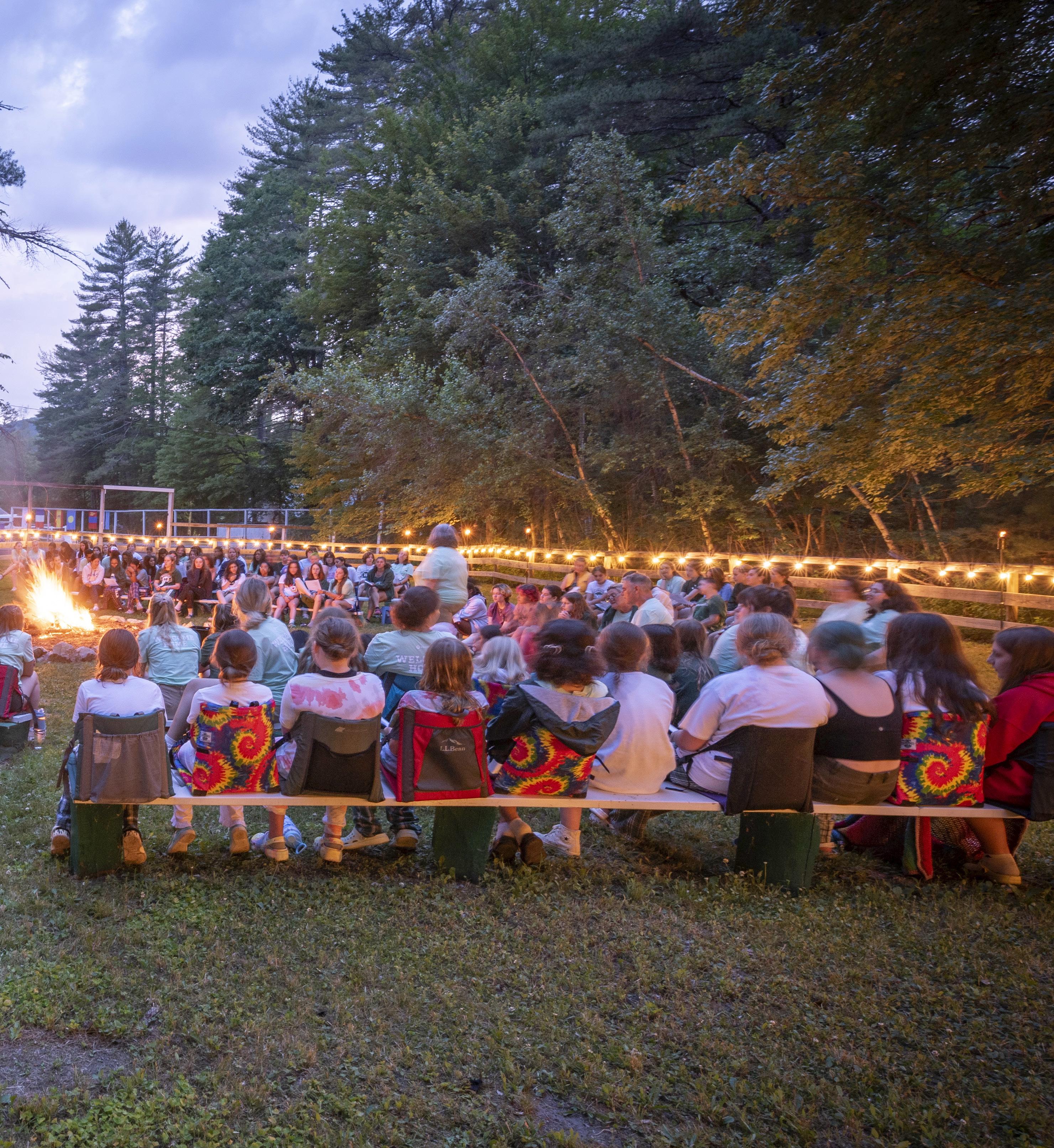
AT CAMP WAUKEELA, KIDS ARE ALLOWED TO BE KIDS.
They’re allowed to take a break from the pressures of the modern world. They are encouraged to follow and discover their intuition and decide what they want to do, who they want to be in a space with people who will never judge them, and who will find ways to join in on their fun.
Spring 2024 71



WHAT
DOES IT MEAN TO BE A KID? IT MEANS LETTING GO OF EXPECTATIONS AND EMBRACING LIFE’S MYSTERIES.
Massive cities began to spring up in the dawn of the modern era in the late 1800s. With this, nature was no longer readily available to people. Education professionals started to wonder how this disconnect from the natural world would affect the children, as many of their fondest memories were times of unstructured play and discovery. A worry that the children of the present would not experience this sort of freedom emerged—and from it—a brilliant solution. A solution that has carried through to the 21st century, and from which a billion-dollar industry has arisen: summer camp.
In the early 1920s, amidst the emerging industry of camp, a man named Fred B. Philbrick started Camp Waukeela on the shores of Crystal Lake in the foothills of the White Mountains. The small camp was a great success, attracting kids from the busy streets of Boston, as well as many from the local area. Waukeela was unique in its care of and belief in young girls’ ability to be independent. The 1920s at Waukeela were filled with adventure. Campers and counselors lived in simple platform tents and spent their days riding horses down the not-yet-paved roads of Eaton. By the 1930s, the simple platform tents had been transformed into rustic wooden cabins whose walls would soon be filled by camper’s names. Waukeela
was a special place, and people who came to it would often stay for many years, feeling a strong sense of belonging.
Not much has changed since the beginning of camp. The world is, of course, very different than it was 100 years ago—and camp has had to adapt to these realities—but people who visit
If you let any Waukeela camper, counselor, or alumnus tell you a camp story, you will watch their face light up—and they’ll offer you a bouquet of wild, imaginative, and hilarious encounters that seem to be sitting, always, just at the tip of the tongue, as if this story had just happened yesterday.

camp after 50 or 60 years still say they see it just the same as they did back then. It still has that same powerfully magical feeling that started all those years ago. Still, children seek independence and friendship while being bolstered by the assurance that they are, in fact, capable. And, of course, at camp are able to nurture a deep and wholistic connection with nature in a world where, for many, access to natural beauty is waning.
72 MWVvibe.com
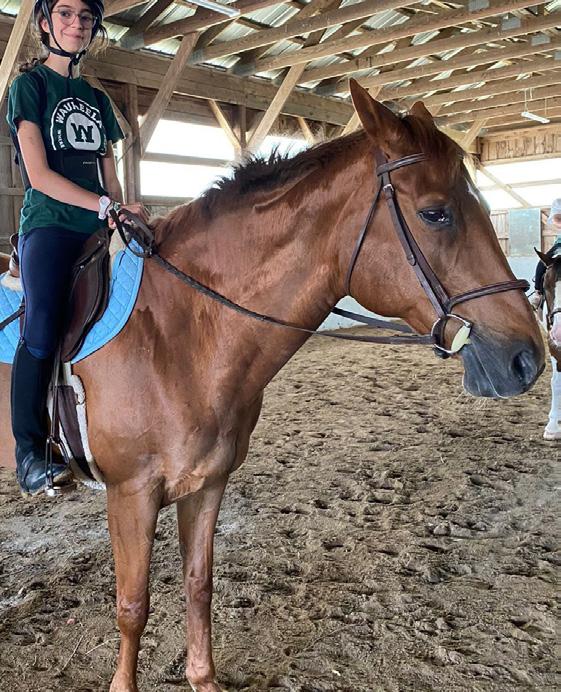


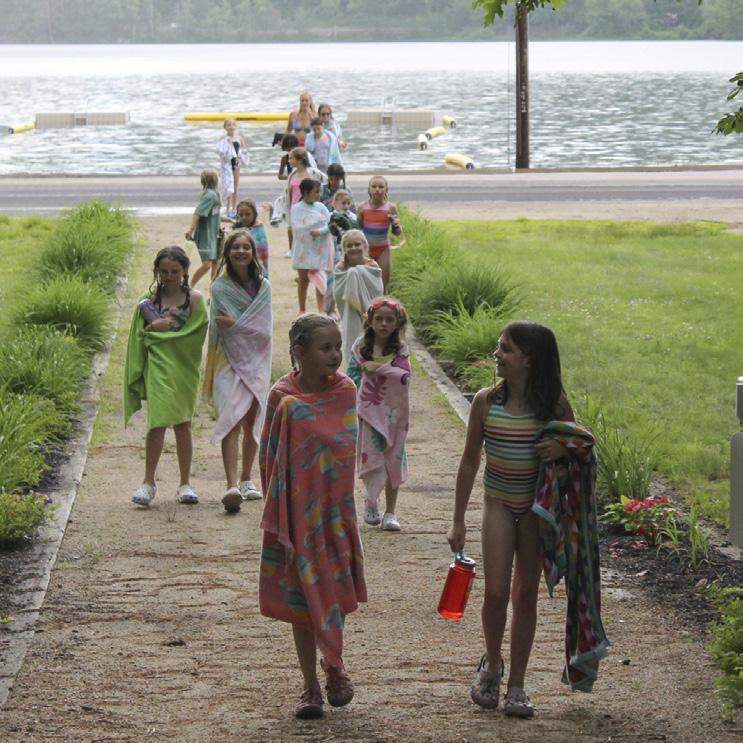
For teenagers who are on the brink of adulthood and who feel their independence rushing through them, their counselors represent people with impressionable impact on their lives.
If you let any Waukeela camper, counselor, or alumnus tell you a camp story, you will watch their face light up—and they’ll offer you a bouquet of wild, imaginative, and hilarious encounters that seem to be sitting, always, just at the tip of the tongue, as if this story had just happened yesterday. You’ll start to notice, however, that every story—even the silliest— answers an invisible question. It’s a question you did not know you’d pondered: What does it mean to be a kid?
What does it mean to be a kid? It means letting go of expectations and embracing life’s mysteries. It means following the voice inside your head that asks: What if? And, Why? It means asking to paint your own face at the facepaint stand and completely covering it in your favorite color. It looks like finding a cardboard box big enough to fit in and going into it every time you can. It might sound like screaming at the top of your lungs because you are excited about candy. At Waukeela, we are constantly asking this question and seeing the beautiful answer unfold right in front of our eyes. Kids are allowed to be kids. They’re allowed to take a break from the pressures of the modern world. They are encouraged to follow and discover their intuition and decide what they want to do, who they want to be in a space with people who will never judge them, and who will find ways to join in on their fun.
In a world in which the pressures young people are faced with are escalating, Waukeela stands to be different. It is a small nook that witnesses children growing into themselves at a disproportionate pace. Through its years of his-



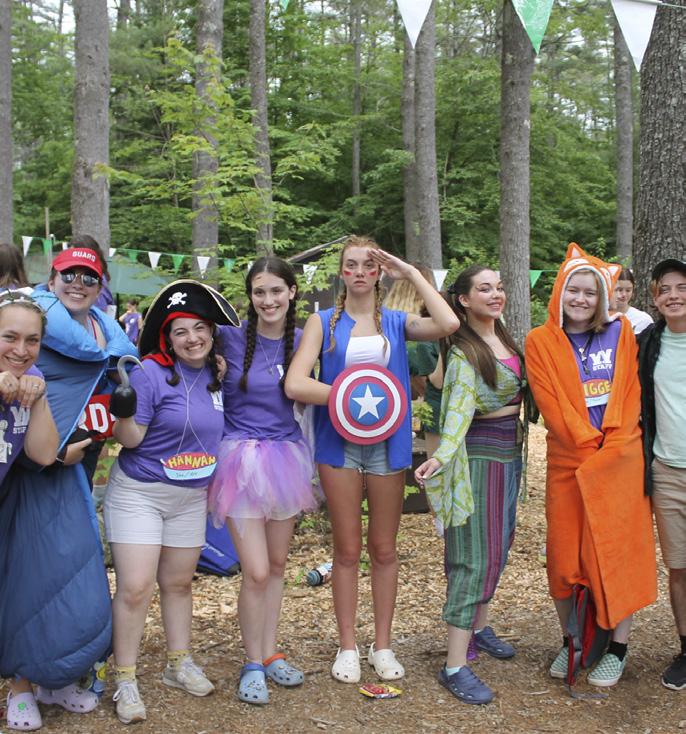


Spring 2024 73
McSherry’s Nursery (603) 447-5442 • McsherriesNurseries.com 2599 East Main St. Center Conway, NH OPEN DAILY 8AM-5PM •Spring Annuals •Herbs •Perennials •Trees, Shrubs •Dry Goods 10% discount for seniors and veterans Our roots grow deep in our community

tory and under its current directors, an important truth has been revealed: people grow when they are asked to do hard things … but only if they are given the support and encouragement needed. The pressures of the modern world—college, extracurricular activities, schoolwork, fitting in socially—are all big hurdles that children are often not prepared for. Especially when they haven’t had the opportunity to overcome hard things on their own.
Every summer, campers from far and wide come to Waukeela and find that they can be away from home, make new friends, and do things they never thought they could. All while having the most supportive community behind them. Kids are asked to do hard things, such as sleep in simple wooden structures, face bugs daily, try new things outside of their comfort zones, and live in community with people who come from different backgrounds. All of these hurdles are little victories that help them build a sense of self-reliance and esteem that carries them through the rest of their lives.
have relatable role models who can help them find what resonates for them. The process of discovering what isn’t true for them is still vital because it exposes the hard boundaries of their personality and teaches them how to say, “No,” when needed. However, the process of finding what does feel true is done mostly through oth-
Witnessing a genuine friendship between a 16-year-old and a 10-year-old is a rarity, yet its beauty is undeniable. Unlike the structured environments of many schools today, where interaction across age groups is limited, we view these friendships at camp as an invaluable opportunity for holistic development.

As children become teenagers, they begin to discern what is presented to them into what feels true and right for them—and what doesn’t. At this crucial time in their lives, it is important to
er people. Especially, relatable role models. Relatable and positive role models are people who are close in age to children and teenagers and who represent the next stage in their lives. Because camp is such a tight-knit community, younger kids experience these role models in older campers, and older campers see their future selves in counselors. Looking
74 MWVvibe.com
Waukeela is located in one of the most beautiful outdoor spaces in the world! The camp offers fantastic hiking, camping, canoeing, and climbing trips for campers. No matter the current skill level and expereince, campers come home with a new appreciation of the great outdoors.

ahead at people who are at the stage of life in which they will soon be experiencing provides a safe reference for people to aspire to. For young kids to see what it is like to be a teenager—and not be ignored by them—sends a message that inspires acceptance and growth.
what they envision for themselves as they approach their teenage years.
Conversely, the 16-year-old is afforded a precious reminder of the innocence of their own childhood. In the company of a 10-year-old, they are granted permission to embrace their playful side once more, while assuming a responsible role in the friendship. This duality allows
For teenagers who are on the brink of adulthood and who feel their independence rushing through them, their counselors represent people with impressionable impact on their lives.
Witnessing a genuine friendship between a 16-year-old and a 10-year-old is a rarity, yet its beauty is undeniable. Unlike the structured environments of many schools today, where interaction across age groups is limited, we view these friendships at camp as an invaluable opportunity for holistic development. The dynamic between a 10-year-old and a 16-year-old provides a rich source of learning for both parties. The younger camper gains insight into the complexities of teenagehood, preparing them for the journey ahead. They not only observe the 16-year-old’s experiences but also learn from their mistakes, contemplating
the older camper to cultivate patience and a heightened sense of responsibility. Nurturing and looking after someone younger becomes a pathway for the 16-year-old to feel both important and reliable.
For teenagers who are on the brink of adulthood and who feel their independence rushing through them, their counselors represent people with impressionable impact on their lives. The glimpse they provide into life after high school is immeasurable. The world of college or jobs or projects or whatev-
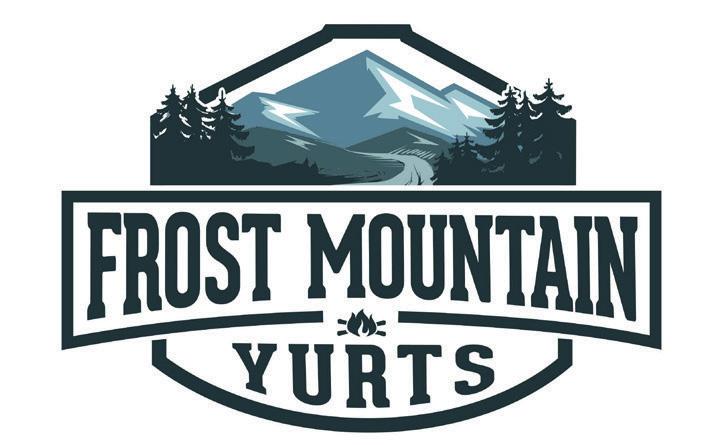
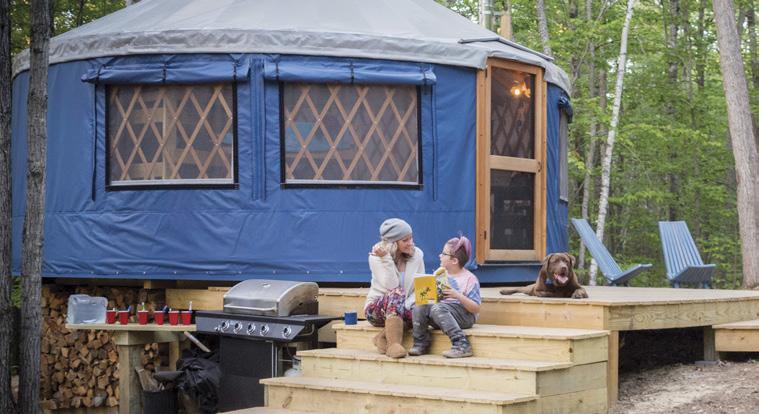
ALL THAT’S MISSING IS YOU! Bring drinking water, sleeping bags and a cooler full of food.
OUR SECLUDED YURTS HAVE EVERYTHING YOU NEED FOR A PERFECT GETAWAY!
(802) 233-7010
www.FrostMountainYurts.com
Spring 2024 75
Brownfield, ME
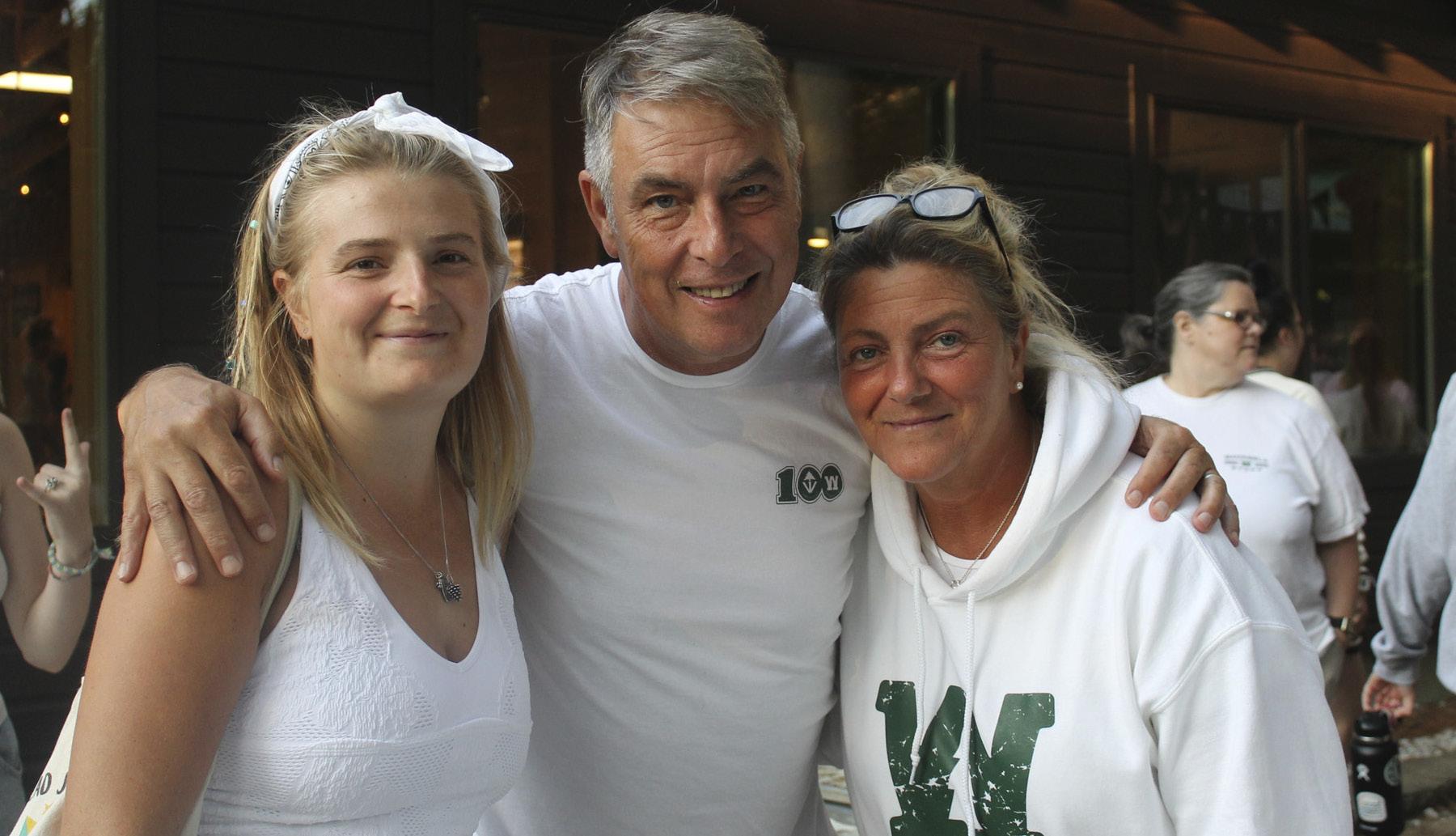
er 20-year-olds get into these days is fascinating, magnetic, and scary. Teenagers need people who didn’t live it 10 or 15 years ago when things were different; they need people who are living in it now. People who can tell them about the big concepts of what is about to happen—along with the details that might otherwise fade with time from someone older. The incredibly complicated feelings of early adulthood that, with time, blur into a single narrative and blend with the outcomes offer valuable insight for the younger generation when shared fresh. The oldest campers at camp are fascinated by the counselors; they are the most influential people in their lives, even when they only see them during the summer.
ships that last throughout their years at camp, and beyond.
A normal day at Waukeela is full of bizarre moments that feel impossible to explain to someone who hasn’t experienced it. Loud singing during meals, crazy constant ongoing games, silly
Every camper is assigned a “G-time group”, a group of between 8 and 10 kids all from different age groups led by one of the kids in the oldest age group. These groups go through G-time together, a time dedicated to bonding, reflecting, and intentionally building community, self-esteem, and awareness.
This inter-age connection is something Waukeela greatly values and puts special emphasis on fostering. Every camper is assigned a “G-time group”, a group of between eight and 10 kids all from different age groups led by one of the kids in the oldest age group. These groups go through G-time together, a time dedicated to bonding, reflecting, and intentionally building community, self-esteem, and awareness. These groups become very close throughout the summer and build relation-
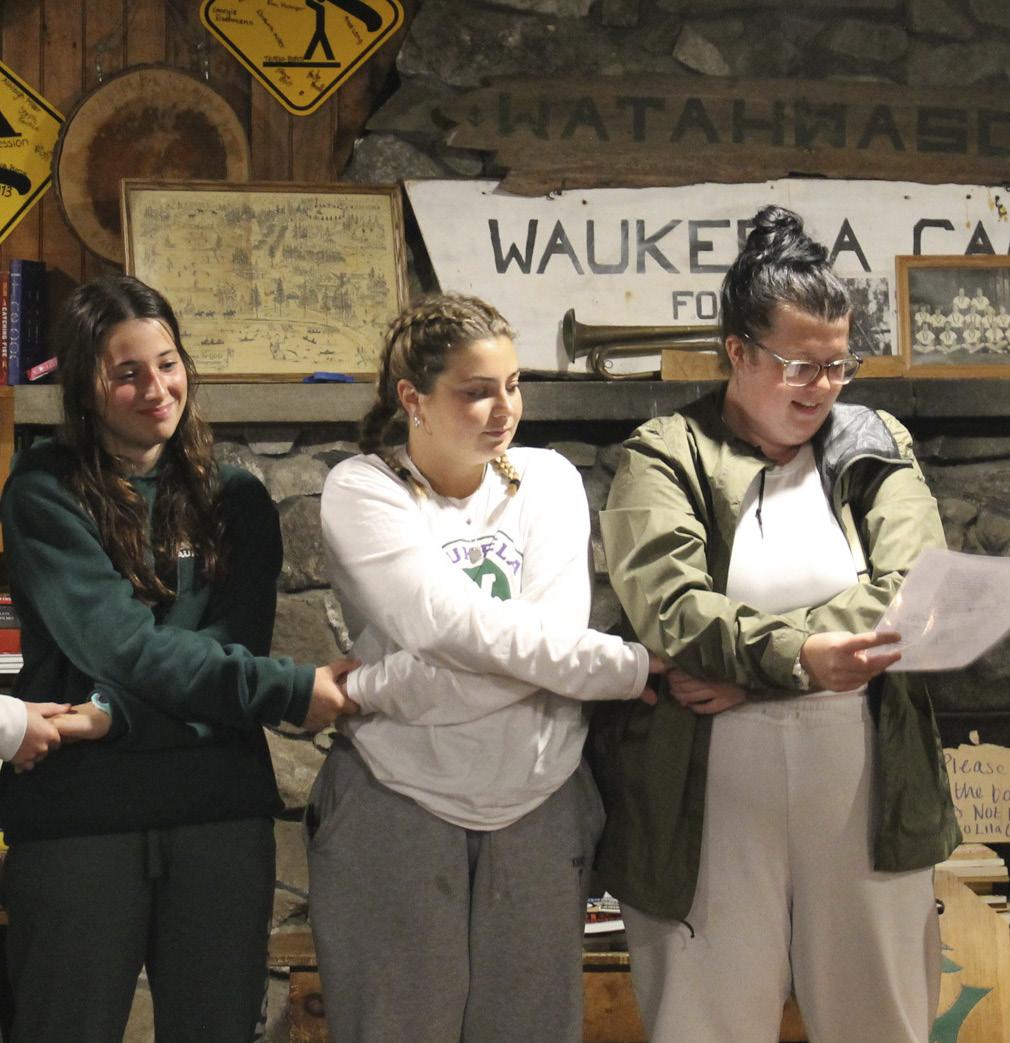
jokes that make their way around camp quicker than anyone ever imagined, pretend weddings, funerals, graduations, and any major life event of stuffed animals, bugs, or people. All of these form a reality in which trying new thing is fun. Silliness and playfulness are the only mental states in which humans can learn new things, and the skills kids are learning at camp are so important that the
76 MWVvibe.com
Camp directors, Graham and Gillian Moore (center and right), are entering their ninth summer at Waukeela, having first experienced the Pine Grove in the summer of 2015 on a visit to see their daughters Ellie (left) and Rosie, who were both counselors that summer.

environment has to be equally as silly and playful.
This kind of space where people are comfortable to try new things and where people feel like they belong doesn’t just happen. At Waukeela it has taken over 100 years of work and some very dedicated people to make it happen. The current directors, Graham and Gill Moore, are some of these incredibly committed people. They came to camp in 2015 as guests to the director at the time, and have since become directors themselves. One of their greatest skills is creating culture. This skill is not easy to find, and only great leaders are able to perfect it. They possess the ability to make people feel like they are a part of their family.
Gill and Graham believe in the power of people; they believe that every human being is wonderfully complex and that we can all learn so much from each other. With these values at the forefront of their directorship, they have created a more loving camp. Waukeela has always been loving, but since Graham and Gill took over, there have been more intentional efforts into making this a community built on love. And it all starts with the two of them.
When someone first steps into camp, they are greeted by smiles, hugs, and excitement. This is the way Graham and Gill greet everyone they meet—waiters at restaurants, receptionists at hotels, even salespeople on the phone. They make friends with everyone they meet, and they are curious about and surprised by every new story, every new personality. And it is this infectious love of others that permeates through camp and shows people a different way of being in the world. A more loving one.
Waukeela is a special place. It has been for many years. It has changed thousands of people’s lives, and it will continue to do so for years to come. There is a unique magic that permeates the trees in this enchanted corner of the world, and if you ask anyone who has lived it, they will tell you more than you asked to hear. But you will never truly understand it until you have lived it yourself.
For additional information about Camp Waukeela, visit them online at www.waukeela.com.
Camp Waukeela, Eaton, NH (603) 447-2260

Spring 2024 77
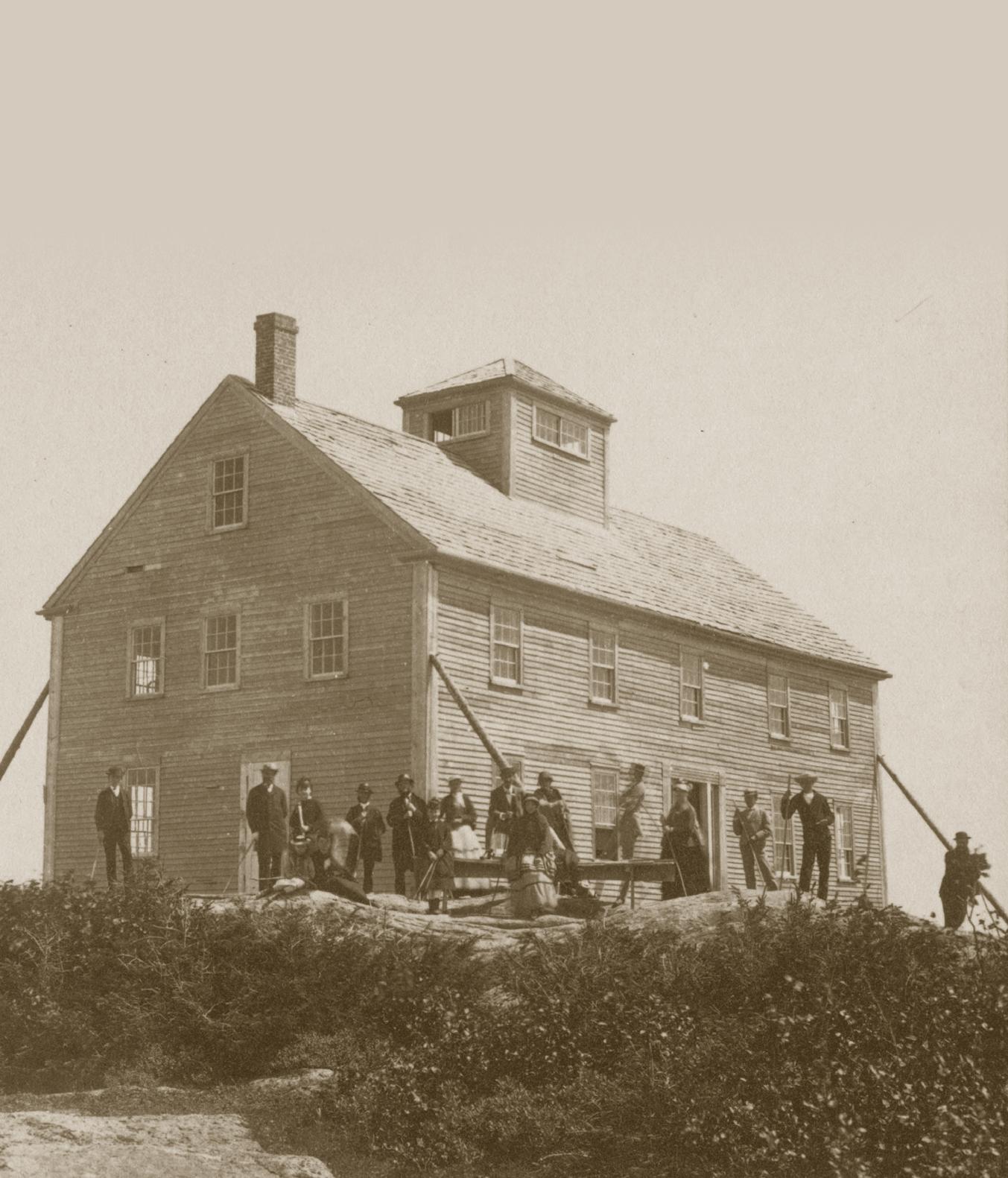
THE HOUSE IN THE CLOUDS
A Closer Look at Kearsarge North and the Summit House
By Heather L Corrigan
The Miriam and Ira D. Wallach Division of Art, Prints and Photographs: Photography Collection, The New York Public Library. “Tip-Top House, Mt. Kearsarge, North Conway, N.H.” The New York Public Library Digital Collections. 1858 - 1875.
Local entrepreneurs Nathaniel Frye, Moses Chandler, and John Dana built the first structure on the summit of Kearsarge around 1840, known as the Summit House. This summit house predated Mt. Washington’s “Tip Top House” by four years.
Anyone who has hiked Kearsarge North, located in Bartlett, NH, is likely familiar with its switchbacks and quickly climbing elevation. At the summit, the reward is hanging out in the abandoned fire lookout tower (built c.1909) and enjoying the 360-degree views of the White Mountains.
Back in the 1840s, the trail would have been full of people on horseback, with some hikers, making the trek to the summit. The congestion would prompt entrepreneurs to start a popular trend in the business of tourism: the summit house. This trend would last many decades, with many summits, no matter how small, seeing structures built to house the many hikers and tourists looking for a place to stay while in the White Mountains.
WHAT’S IN A NAME?
Kearsarge, Kiarsarge, Kyarsarge. Kearsarge North had various spellings in the 1800s, and all locals referred to it as Kearsarge. It is said the name was given to the mountain by the Abenaki living in the area, but there are other stories that accompany the name.
Around 1867, the Reverend Benjamin Durgin Eastman of North Conway suggested that the name was a combination of names for the sun, Kesus; the moon, Keshow; and heaven, Keshuk. Others say a hunter named Hezikiah Sargeant, who lived at the base of the mountain, was the source, spelled Kiarsarge during that time. Some believed it was the Pequawket tribes, who lived in the Conway and Fryeburg areas, that had words meaning “through the door of the sky,” and these words resulted in the word Kearsarge.
In the 1870s, the Appalachian Mountain Club was aware of two peaks in New Hampshire, both named Kearsarge. A meeting in 1877 by the AMC sought to determine which peak was named Kearsarge first, and while there was evidence of both peaks being referred to as Carasaga Mountain (Merrimack County) and Pigwackett Hill (Bartlett)
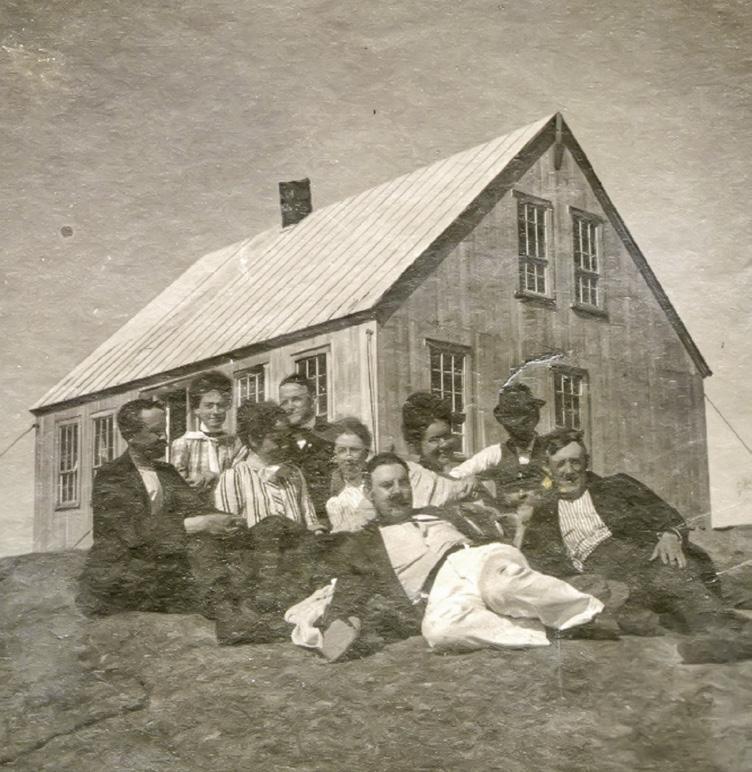
The NH Legislature passed an act on July 14, 1864, which allowed the building of a chartering road from “Kearsarge Village in Carroll County, to the top of Kearsarge Mountain.” It was at this time that a new bridle path was built by Joseph Nute and Stephen B. Eastman to help the congestion on the trail.
on maps from the 1700s, they determined both peaks were named Kearsarge around the same time. But the quarrel over the name didn’t stop there. Merrimack County argued that the USS Kearsarge, the sloopof-war (warship with a single gun deck and up to 18 guns) which defeated the Confederate warship CSS Alabama in 1864, was named for their peak specifically.
In 1915, the efforts of Jacob H. Callinger (from Merrimack County) were able to get the name of Kearsarge in Bartlett changed to Mt. Pequawket on maps by the U.S. Board of Geographic Names. Although the name was changed on maps of the area, locals of Kearsarge Village and North Conway still referred to the mountain as Kearsarge.
According to Helen Nute’s “Sally Mander” column in The Reporter from 1970, “Strangers in town desirous of climbing the mountain and asking directions to Mt. Pequawket were amazed by the lack of information available.” It was later that maps began to add “Mt. Kearsarge” in parentheses next to “Mt. Pequawket.” This change lasted until September 6, 1957, when the AMC changed the name to “Kearsarge North.”
TOURISM AND THE CALL FOR A HOTEL
The Kearsarge area was one of the first in Conway to begin to welcome tourists. Isaac Merrill, proprietor of the Merrill House, began to open his hotel to artists traveling to the area. By the 1840s, a trail was constructed up Kearsarge by Samuel Thompson, which started at the Arcadian Cottage at the base of the mountain. Samuel Thompson was also the proprietor of the famous grand hotel, the Kearsarge Hotel (also known as Kearsarge House or The Kearsarge), located next to the North Conway depot in Railroad Park (now Schouler Park). The trail was used until 1909, when a fire tower was installed, and later the trail was moved to its current location by the US Forest Service.
Local entrepreneurs Nathaniel Frye, Moses Chandler, and John Dana built the first structure on the summit of Kearsarge around 1840, and it was known as the Summit House. This summit house predated Mt. Washington’s “Tip Top House” by four years. It was a slow building process, with all materials being brought up the face of the mountain by ox-sled in the dead of the winter. This house was a simple structure that began to fall into disrepair over the years.
The NH Legislature passed an act on July 14, 1864, which allowed the building of a chartering road from “Kearsarge Village in Carroll County, to the top of Kearsarge Mountain.” It was at this time that a new bridle path was built by Joseph Nute and Stephen B. Eastman to help the congestion on the trail.
Andrew Dinsmore purchased the
Spring 2024 79
summit house and renovated it to serve as a hotel with all the modern amenities, opening on July 4, 1869. The hotel was a 2-1/2-story house with a mounted cupola and telescope. Rates were higher than other hotels in town, most likely due to summit travel and the incredible 360-degree views.
During the 1870s, the hotel was run by A.A. and J.W. Whitaker (of Whitaker Woods fame) and they would be the last proprietors of the hotel. In 1905, Andrew Dinsmore was quoted about the number of patrons they would see: “Sometimes at the height of the season, 50 persons a day would come up the mountain and 20 horses. Parties would stay three or four days or a week at the Summit House. Those were the good days before the railroads had ruined everything here.”
At the base of the mountain was a fleet of horses that made daily trips up the mountain. There were so many passengers at times that the mountain railroad was discussed to ease the burden on the horses.
But tragedy struck on November 12, 1883, as hurricane-force winds blew the Summit House off the summit. Lease of the land called for the building, if
“Sometimes at the height of the season, 50 persons a day would come up the mountain and 20 horses. Parties would stay three or four days or a week at the Summit House. Those were the good days before the railroads had ruined everything here.”
destroyed, to be re-built within a year to hold the title. A similar structure was re-built using reclaimed parts of the former Summit House, but it didn’t dare call itself a hotel. Travel to the summit did not cease, however, just because the hotel was destroyed, and hikers still enjoyed using the structure as a place to lay their heads at night.
By 1885, railroads were well established in the area, and with it brought those who were never able to make the trip to the area before. Train travel allowed for shorter travel time, along with and the ability to travel to the area in seasons other than summer. With the popularity of hiking or riding up Ke-
LUDWIG THE BAVARIAN
High atop the fire tower on Kearsarge, you may still find a logbook to register your arrival. For many years, the most common, almost daily, signature on the summit was written down as L.T. B. If the trail was blocked or these books filled up, L.T.B. would clear downed trees or he would switch full logbooks out for fresh ones.
For many, this mountain is a local gem because it hikes like a 4,000-footer, but lies just beyond the northern boundaries of downtown North Conway. Born in the European region of Franconia, L.T.B. was a true master of so many subjects. Hiking and living in the mountains were obviously in his blood. In his formative years, he was an AMC
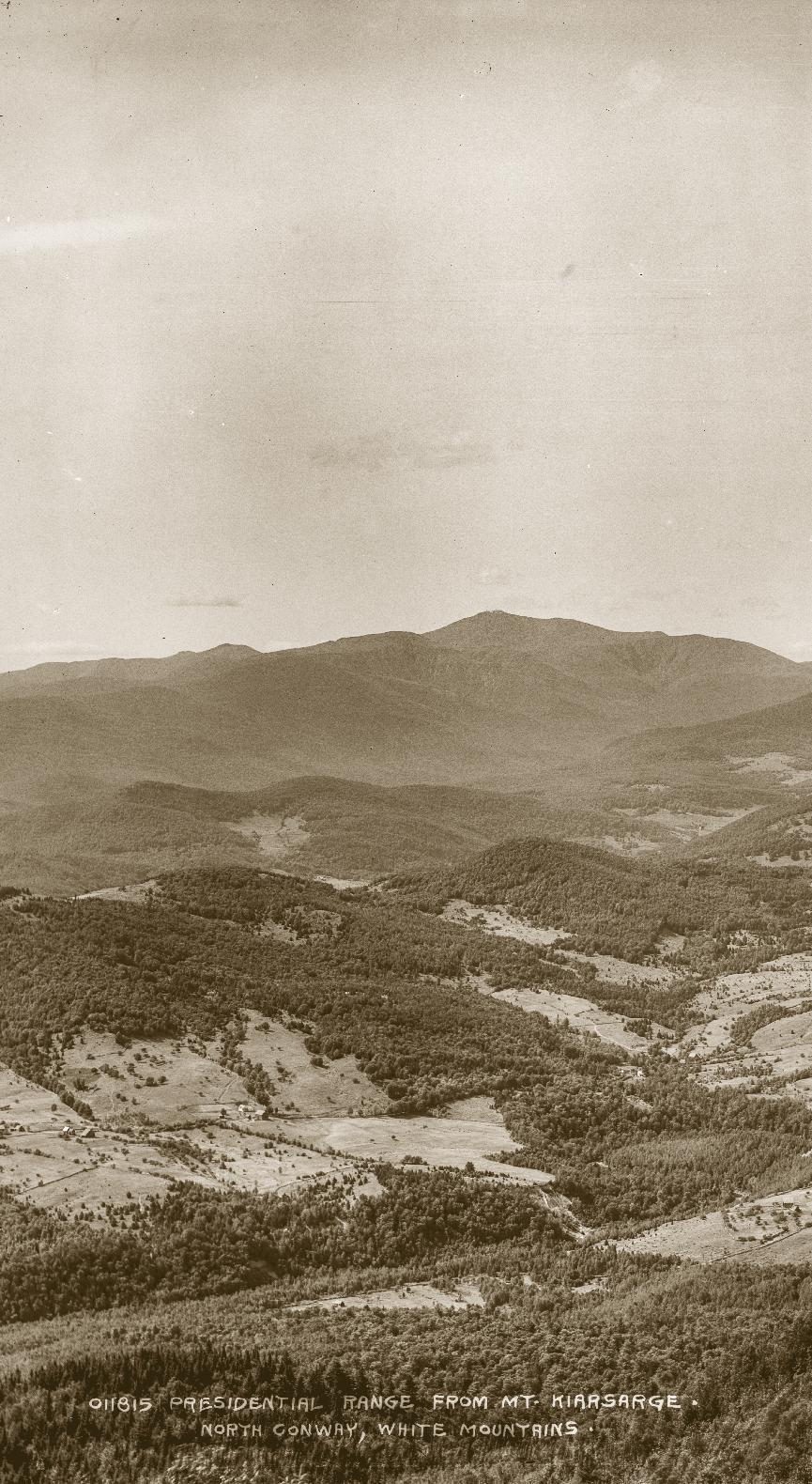

80
Mount Washington
Route 16A, Intervale
hutsman, packing supplies high into the backcountry. This is one of many reasons why he was so well-versed in backcountry etiquette and why he kept the trail to Kearsarge immaculate.
As you ponder the story of the hotel that sat upon this peak, so did our caretaker L.T.B. This mountain has so much history to explore, from a downed helicopter to even the evidence of a plane’s wreckage, which lies somewhere on its slopes. L.T.B. would summit Kearsarge in under an hour, a solid performance even for someone without a hip replacement.
The mountains will miss L.T.B., the steward of Kearsarge. We released the ashes of Ludwig the Bavarian on the summit of Kearsarge North. It was
flanked by the community he loved. R.I.P. Ludwig Schiessl, aka L.T.B.
Source: William Gilson

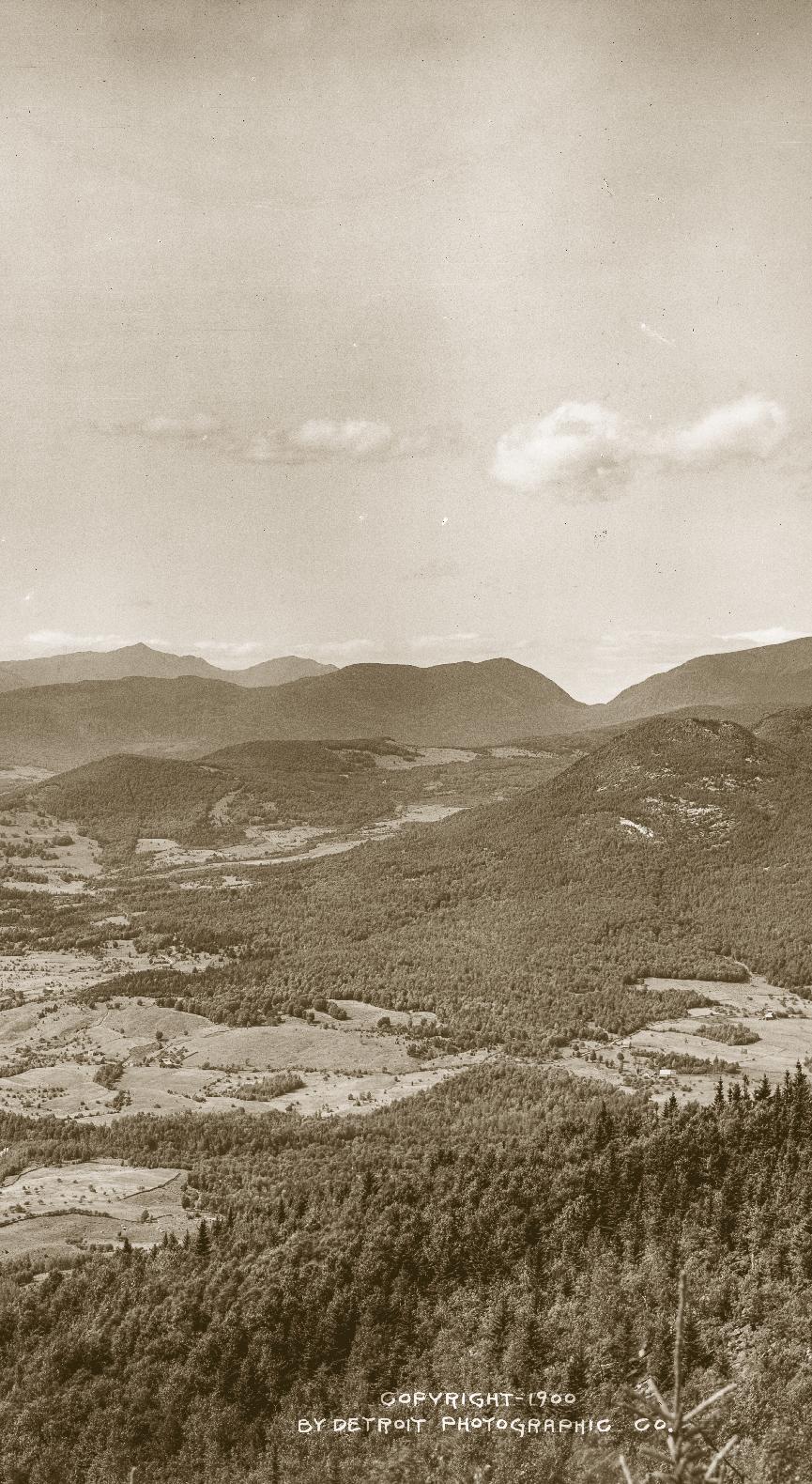
















This view is from Mt. Kiarsarge in1900, looking north towards Mount Washington and the Presidential Range.


















































































81
Mount Adams
Black Mountain Ski Area
Doublehead Mountain
Dundee Rd.
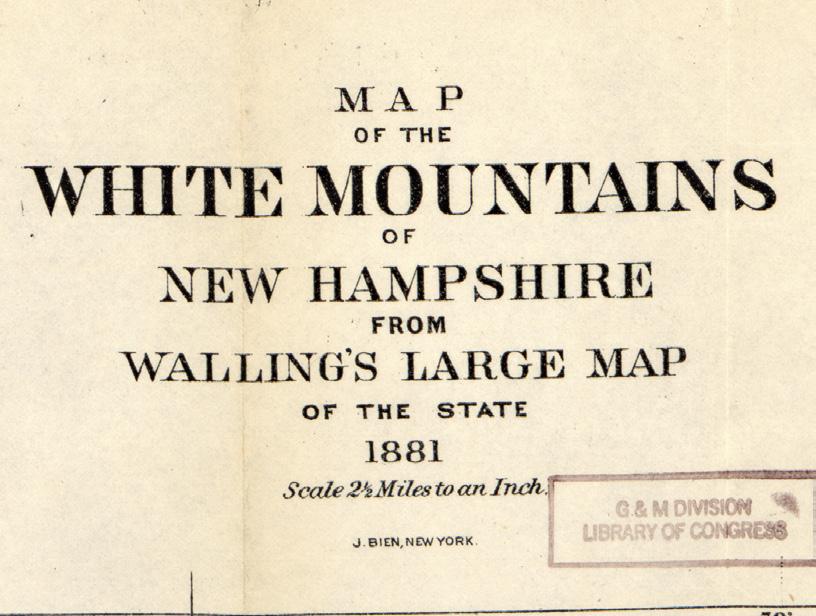
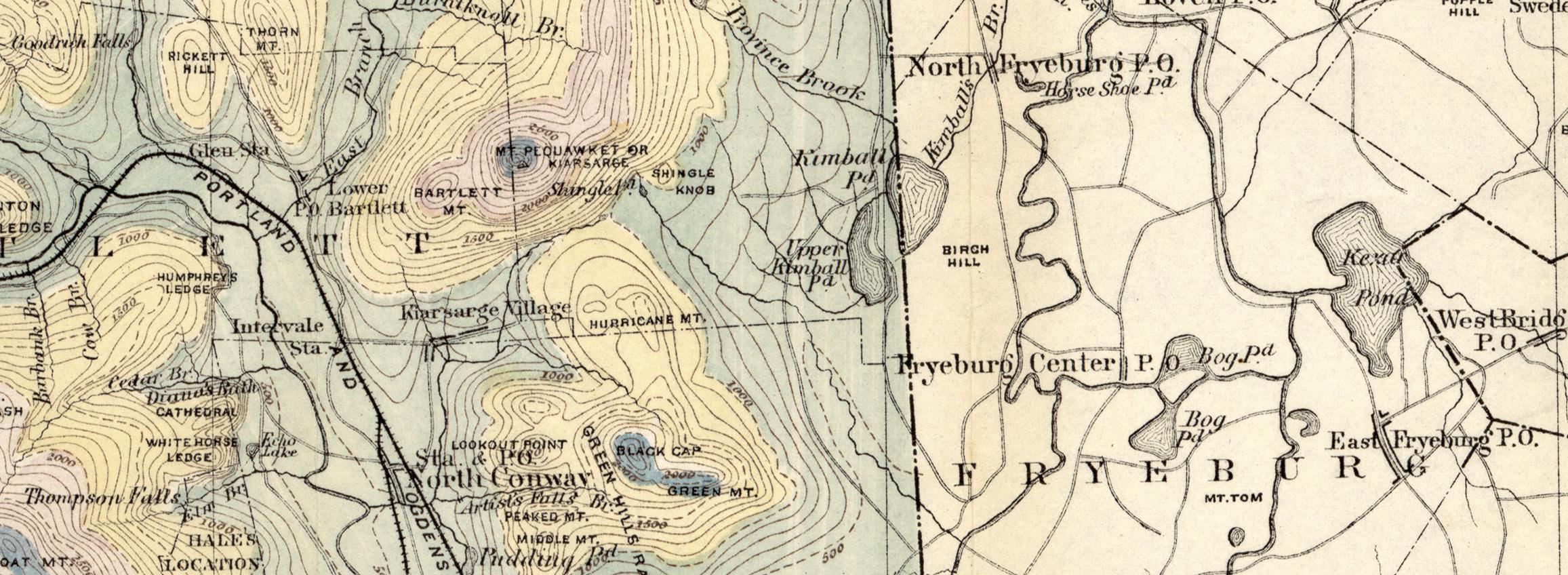

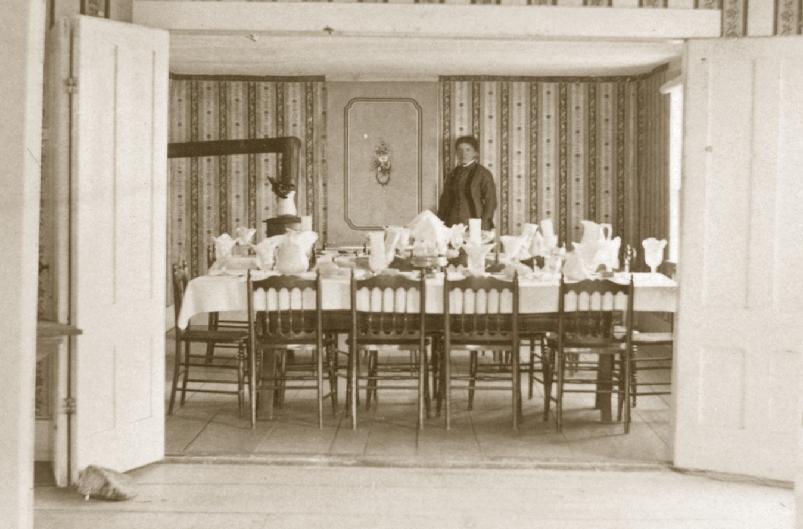
arsarge, plans for a railroad to the summit were drawn up. The North Conway-Mount Kearsarge Railway Corp. was organized with $400,000 of capital stock and a board of directors.
Among the board members were Nathan W. Pease (famous local photographer), Lycurgus Pitman of North Conway, and M.C. Wentworth of Jackson. It was predicted in 1889 that the railroad would be a great asset to Chatham and surrounding areas, good for communication and transport for all the granite and lumber industries in the area, as well as allowing visitors to view some of the “finest panoramas” of scenery in all of New Hampshire.
The railroad was surveyed thrice over the years, with the final survey in 1891. The plans called for the track to make a complete turn around Kearsarge and Bartlett mountains and
circle the upper core of Kearsarge three times. It would be a smooth rail, with a five percent grade and the Intervale junction to the summit was measured at 11.5 miles. While the idea was embraced by many in town, it was gradually abandoned, with developers looking to more newfangled ideas.
The next time you hike Kearsarge North, take a moment at the summit to imagine this three-story hotel on the small summit. If you climb up into the fire tower to see the incredible 360-degree views, you can envision what hotel guests saw back in the 1800s and why it would draw them to the summit. Although the hotel has been gone for many years, the summit of Kearsarge North still sees plenty of foot traffic, and the spirit of the Summit House is alive to this day.
82 MWVvibe.com
TOP: The above map of the White Mountains of New Hampshire, called “Wallings Large Map of the State,” was printed in 1881, and shows “Mt. Pequawket or Kiarsarge.” Also notice that Hurricane Mountain is listed. Interestingly, it is said that nearby Hurricane Mountain gained its name from when the great hurricane of 1883 blew the Summit House off the summit. Yet Hurricane Mountain is clearly listed on the map from 1881. ABOVE LEFT: After the Summit House was blown away, debris was collected and a lesser structure was built to protect the title, which called for the building, if destroyed, to be re-built within a year. Robert N. Dennis collection of stereoscopic views.
ABOVE RIGHT: The above stereoscopic card is labeled “Interior Tip-Top House, Mt. Kearsarge, North Conway, N.H, by Pease, N. W. (Nathan W.), 1836-1918.”








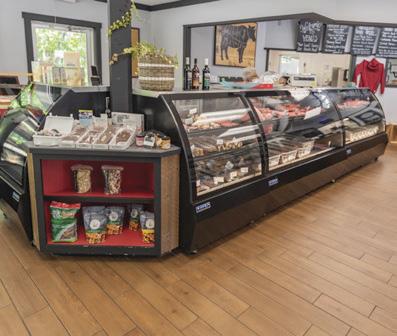

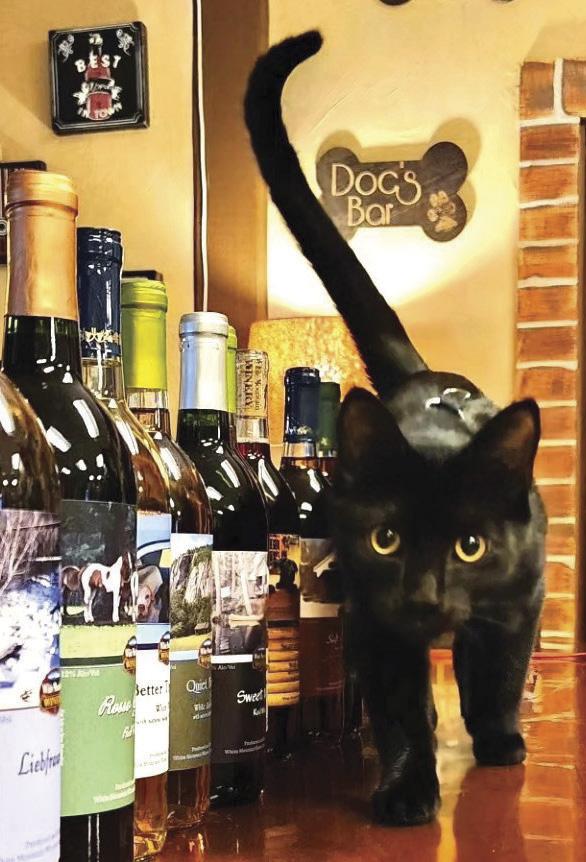
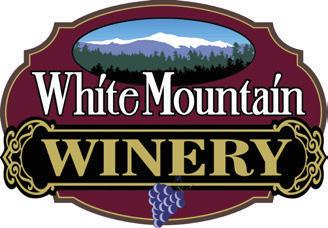

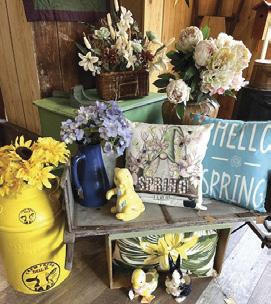


Spring 2024 83 WHITE MOUNTAIN INDEPENDENTS WhiteMountainIndependents.com For charm, service, & distinctive products, we invite you to SHOP THE BLUE FLAGS in support of our small, locally-owned retailers! North Conway Village (603) 733-5144 • ItsMyGirlfriendsNH.com Located Next to the Train Station No Soot, No Toxins, Burn Longer, Cost Less North Conway Village (603) 986-8969 • Soyfire.com 20% Off Fragrance of the Month Visit our store to pick up quick meals or to experience restaurant-quality food at home! VenosNH.com (603) 662-0615 715 White Mountain Hwy, Conway, NH SPECIALTY FOODS & MEATS (603) 662-0452 328 White Mtn Hwy, Conway, NH Antiques • Home Decor • Jewelry Custom Furniture • Chalk Paints Give us a Try ... or Buy Online! Reporter Court No. Conway Village (603) 356-9643 WhiteMountainWinery.com
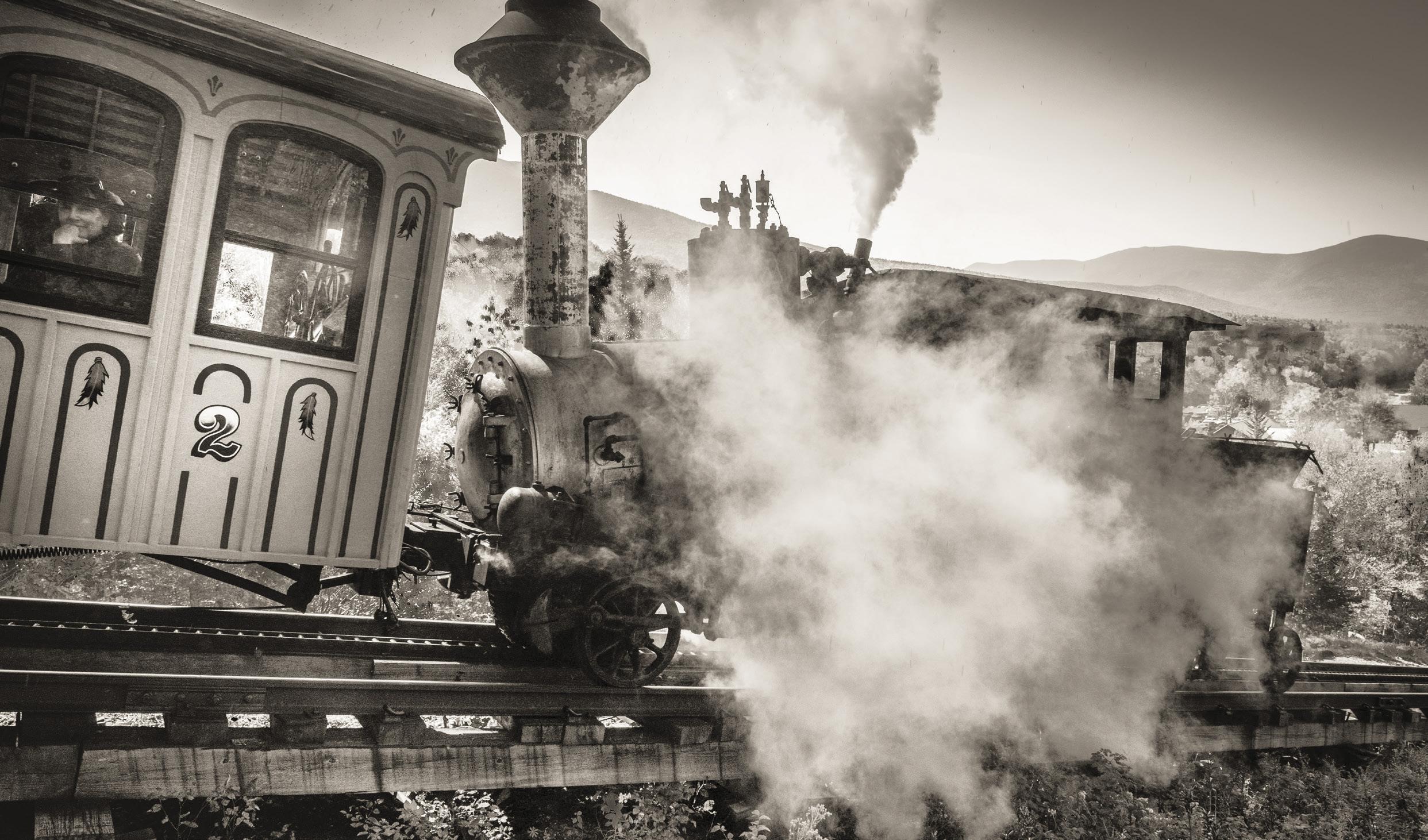


84 MWVvibe.com FREQUENT DEPARTURES DAILY, all year long thecog.com
















































 Edwin Giron, DDS, DAAFE and Caitlin Behr, RN, BSN
Edwin Giron, DDS, DAAFE and Caitlin Behr, RN, BSN




















































 Orange belted bumble bee - Photo by Mike Murphy
Orange belted bumble bee - Photo by Mike Murphy





 By Lea Camille Smith
By Lea Camille Smith


































































































































































































































































































